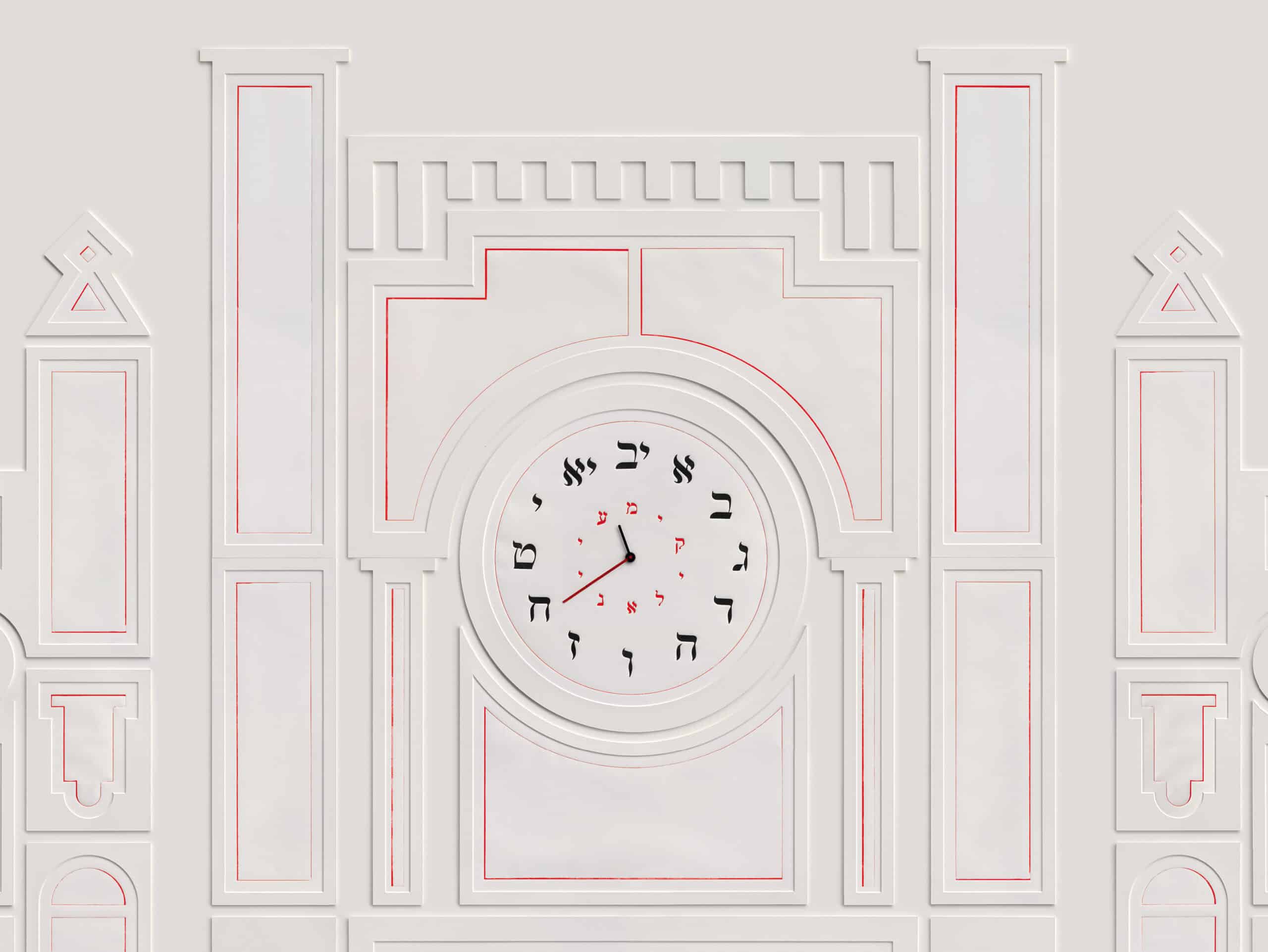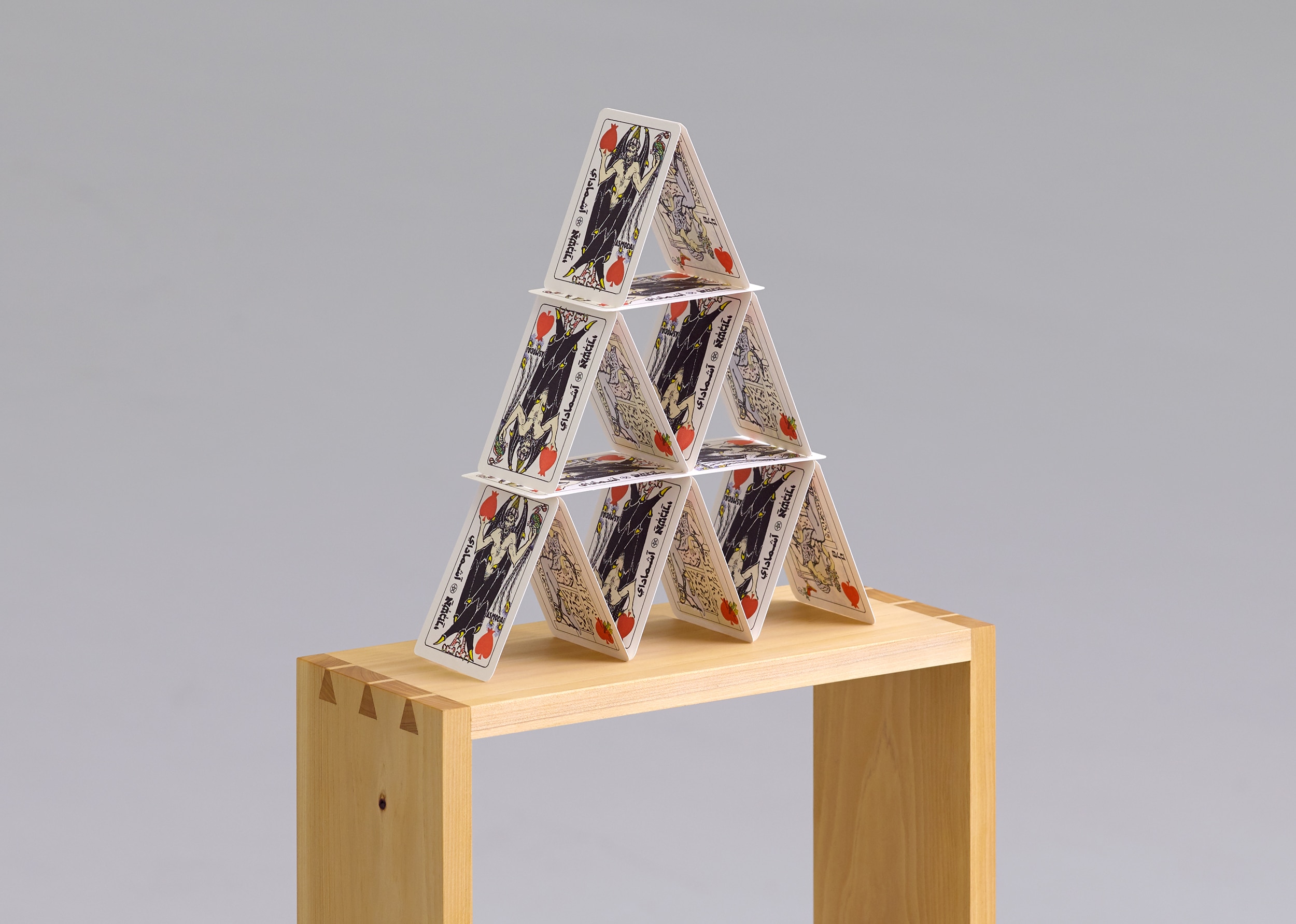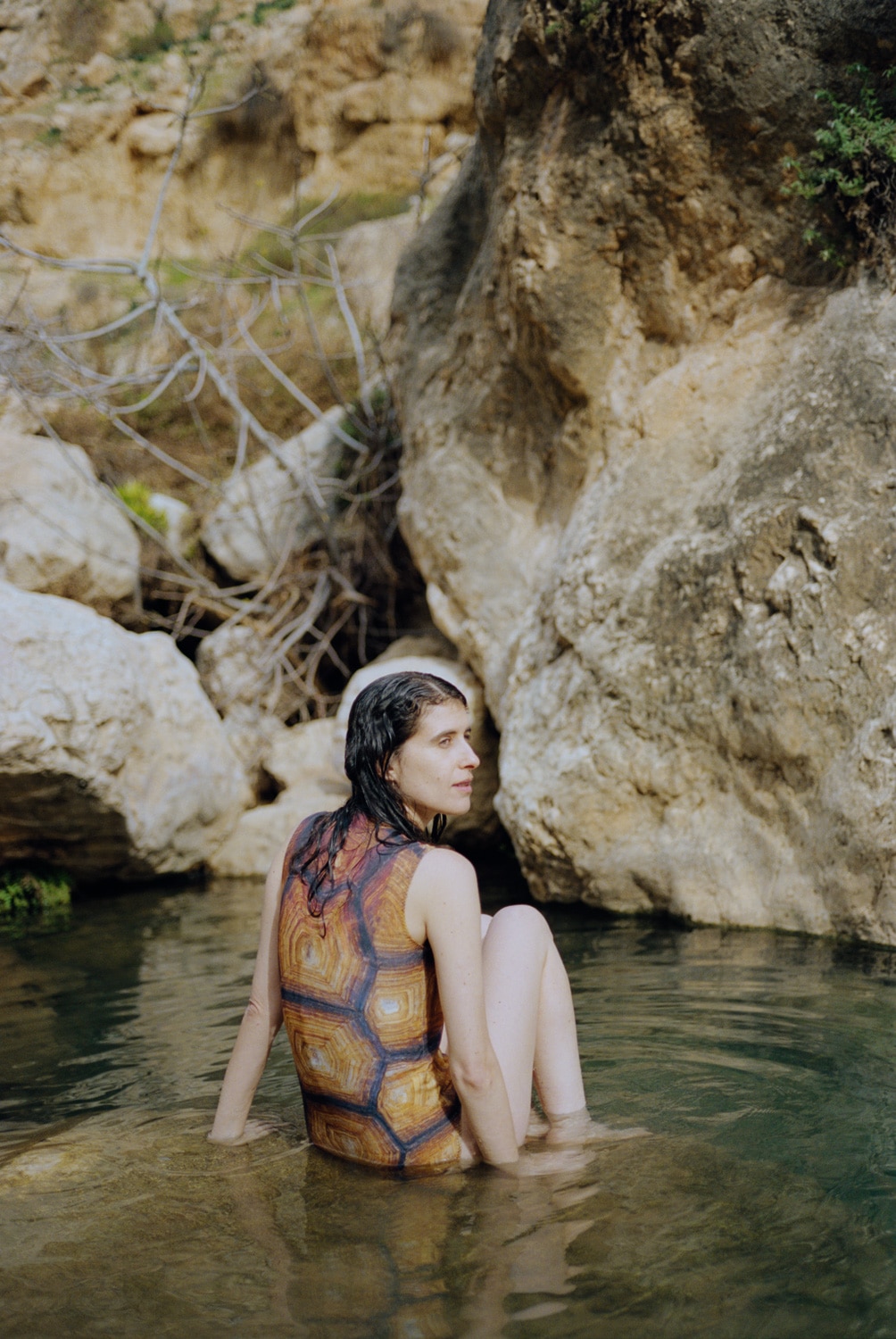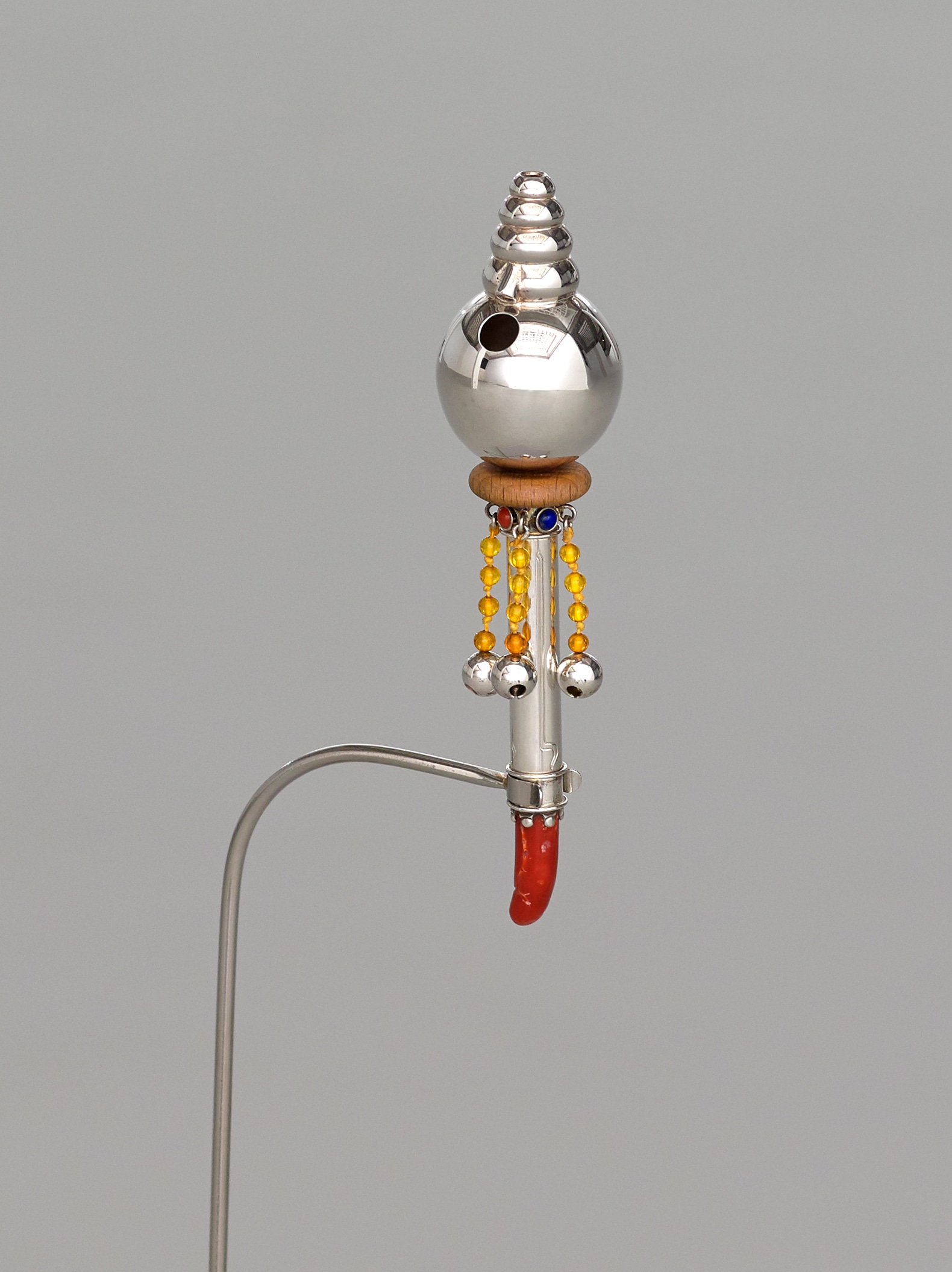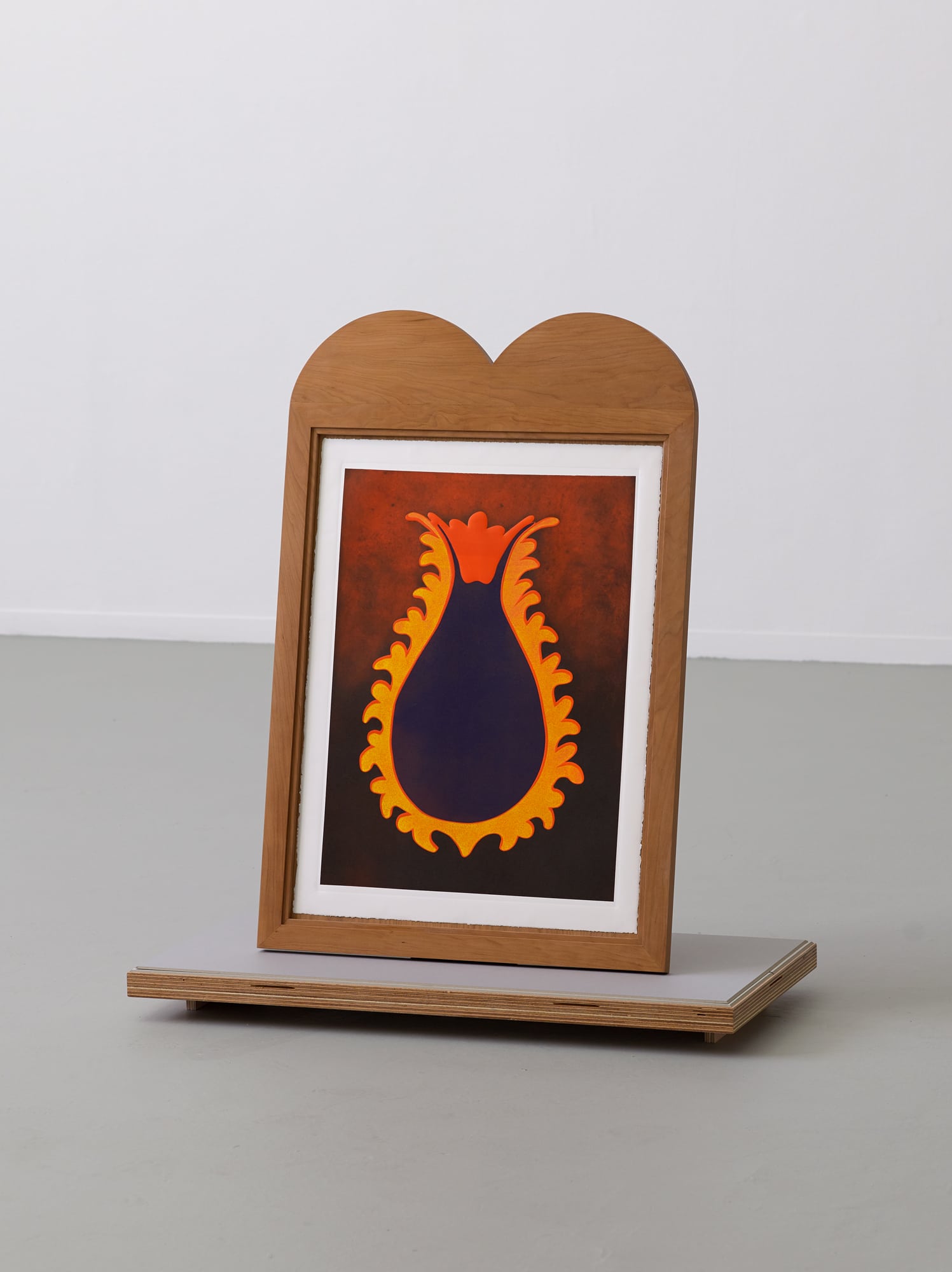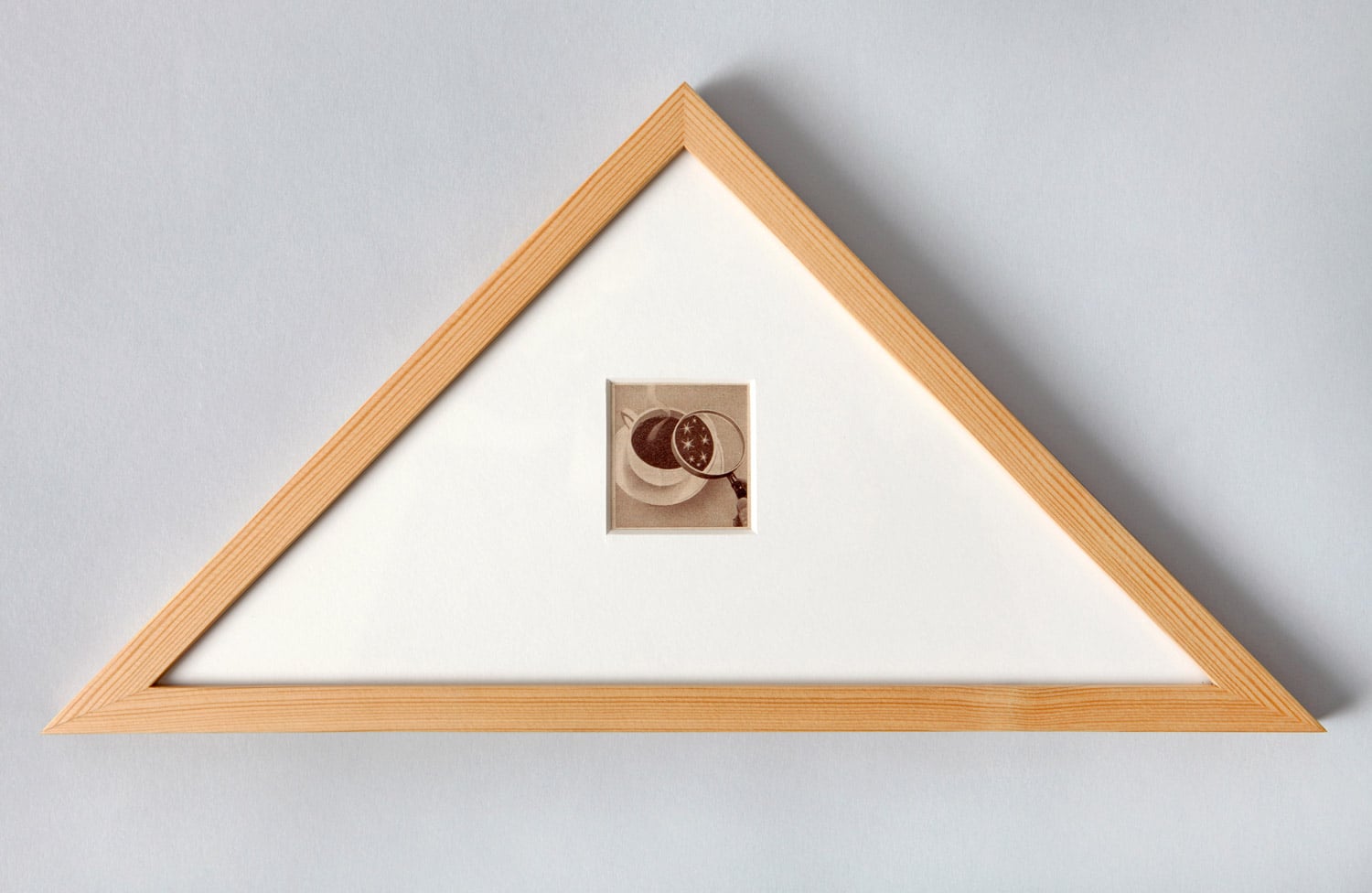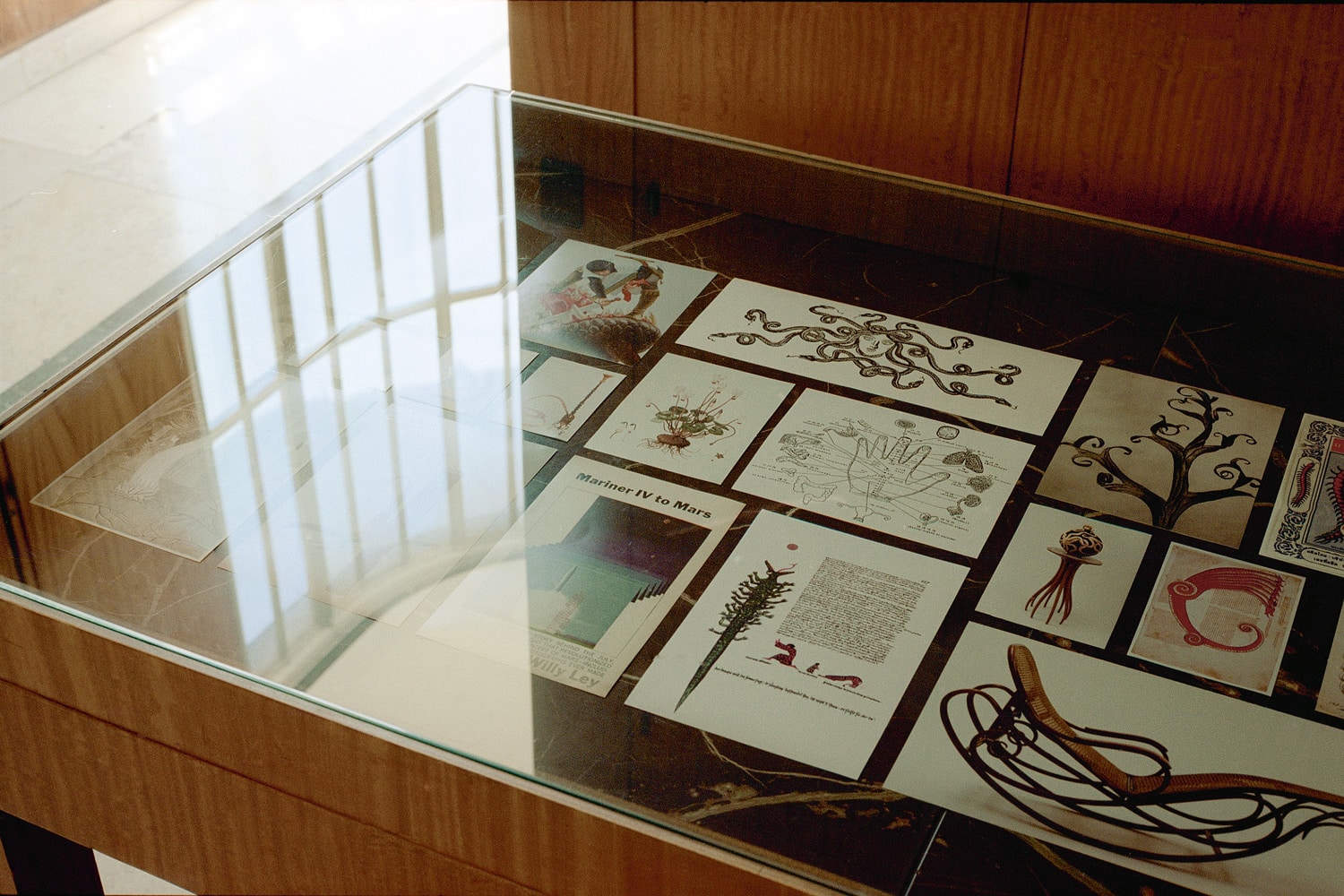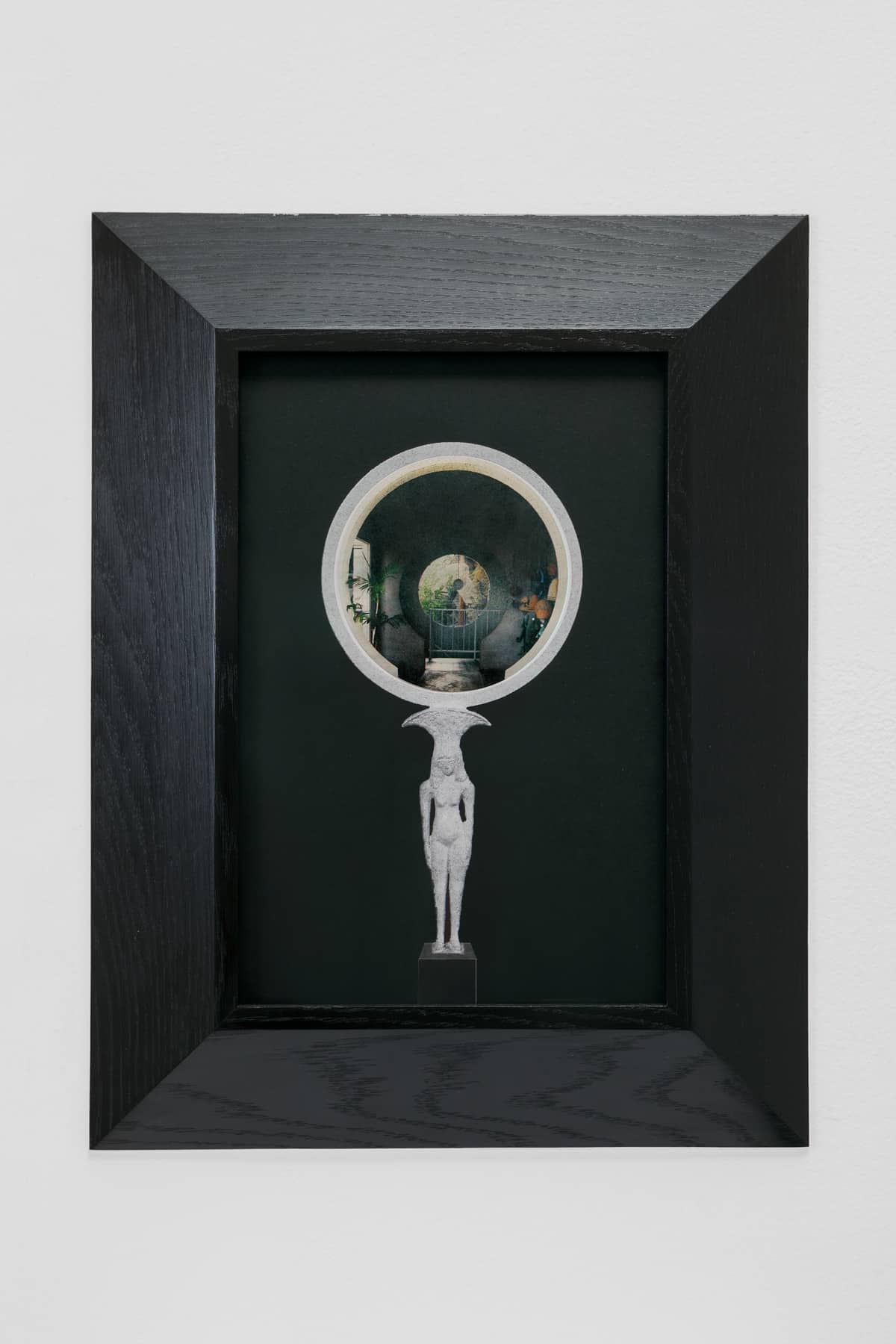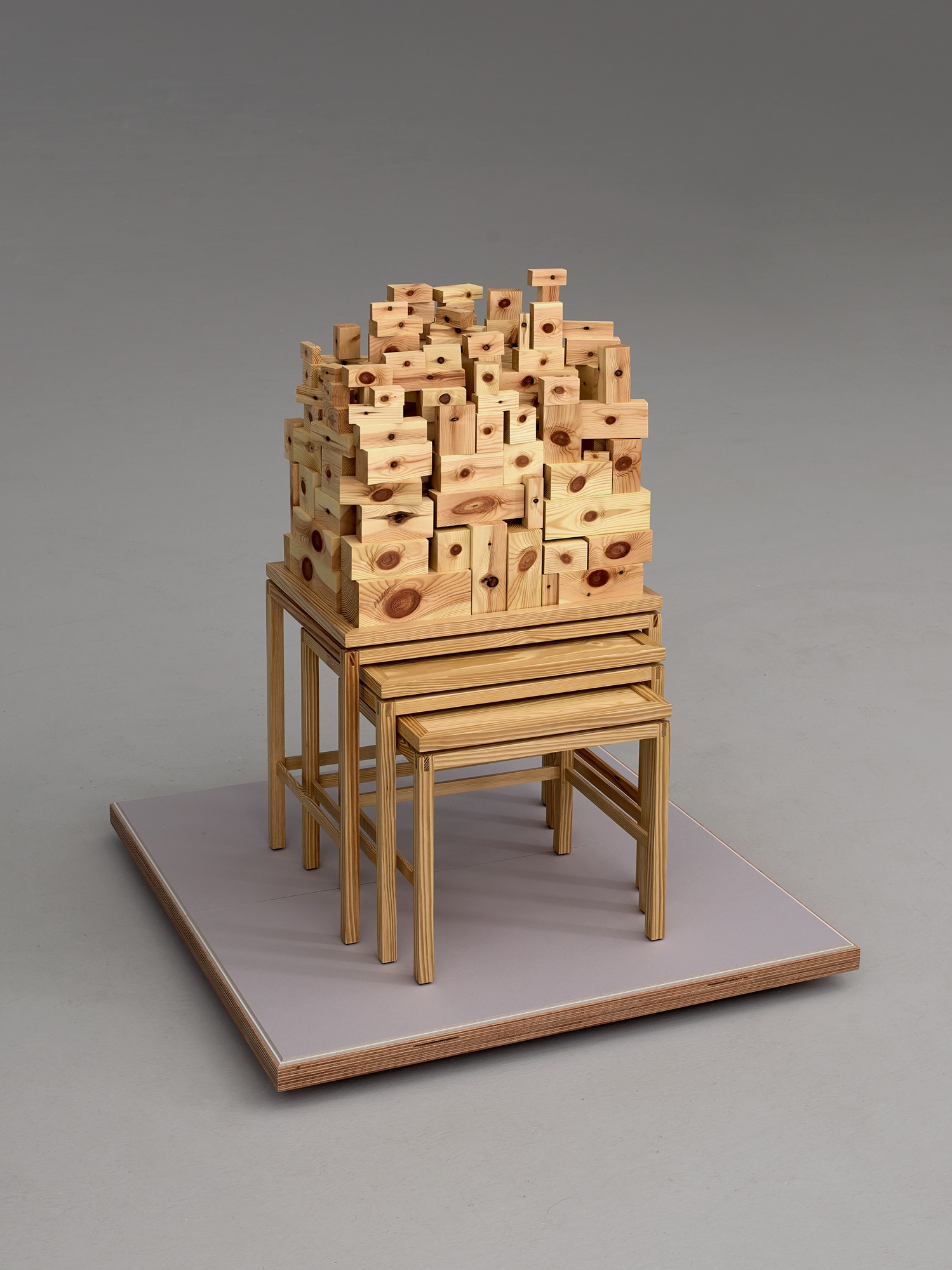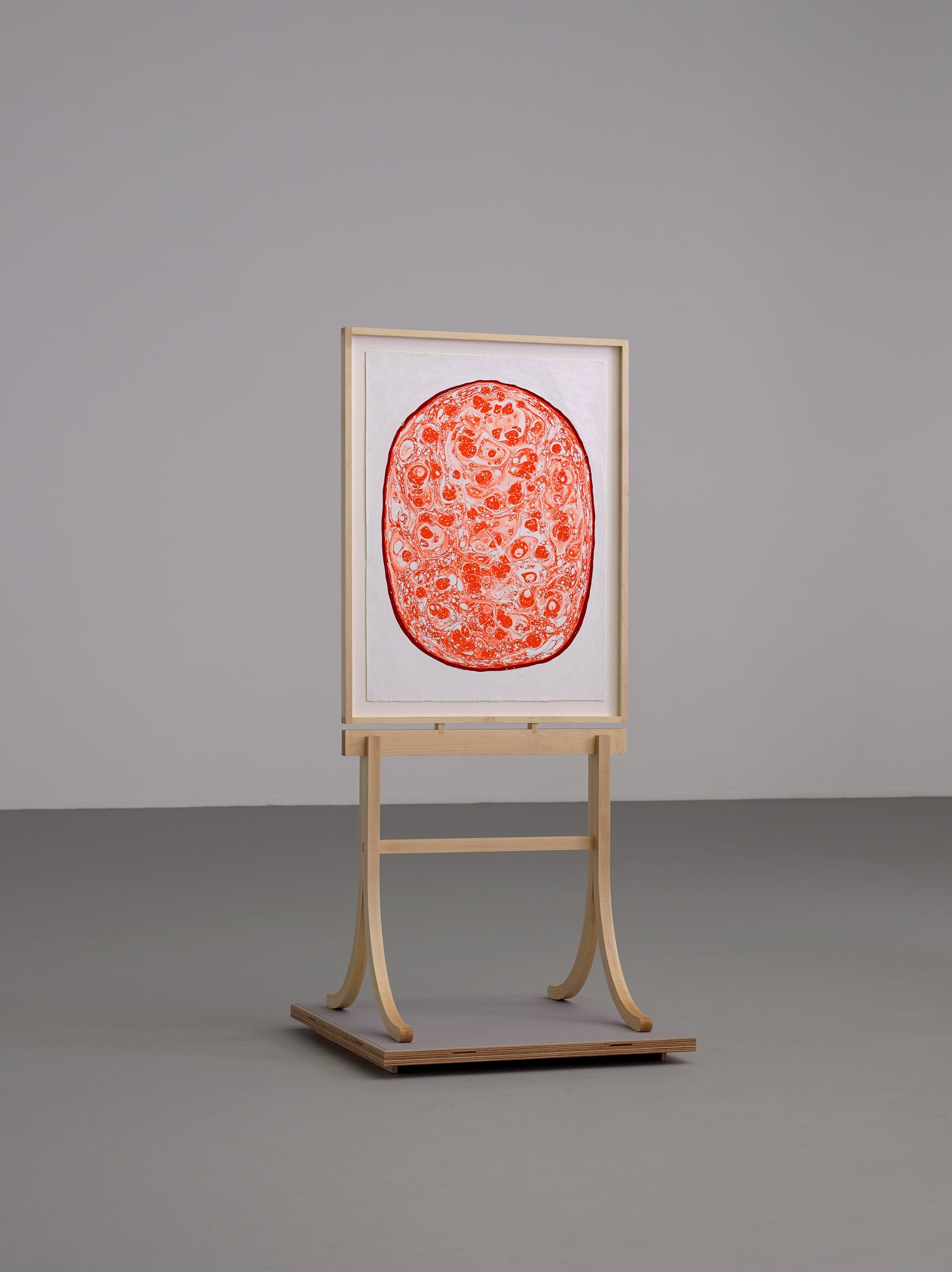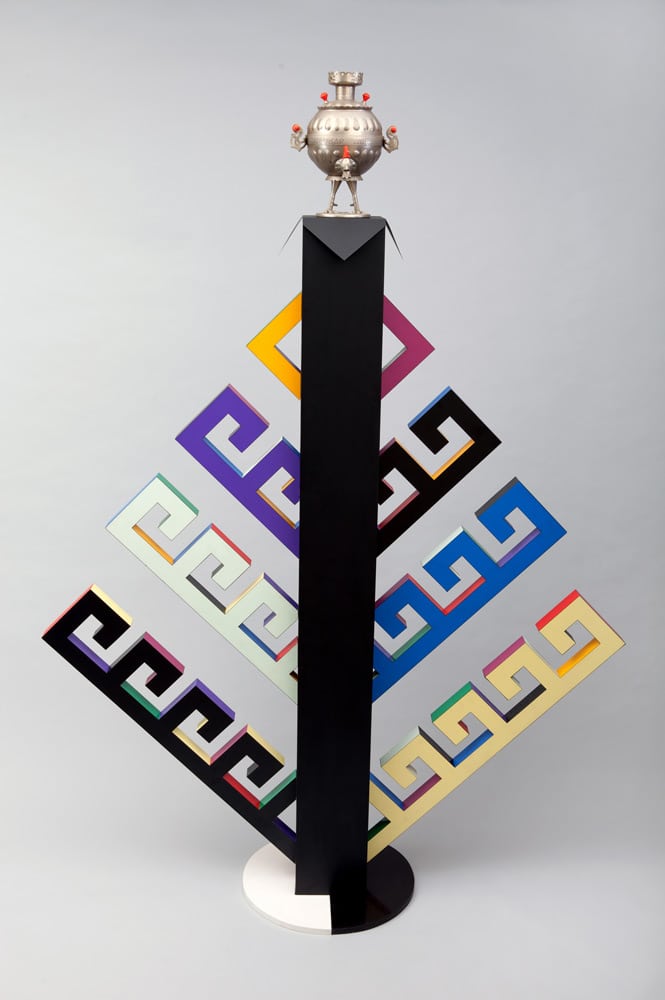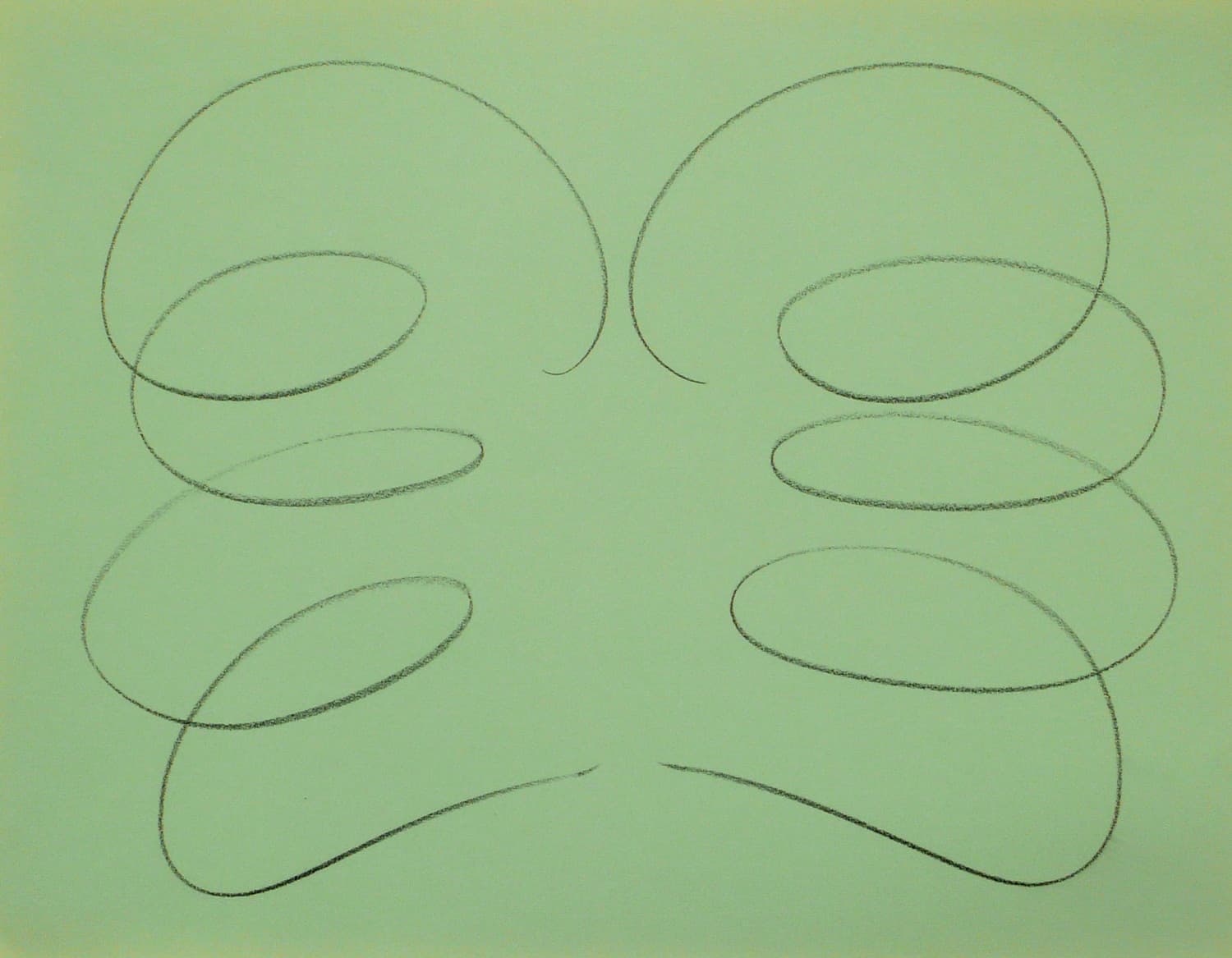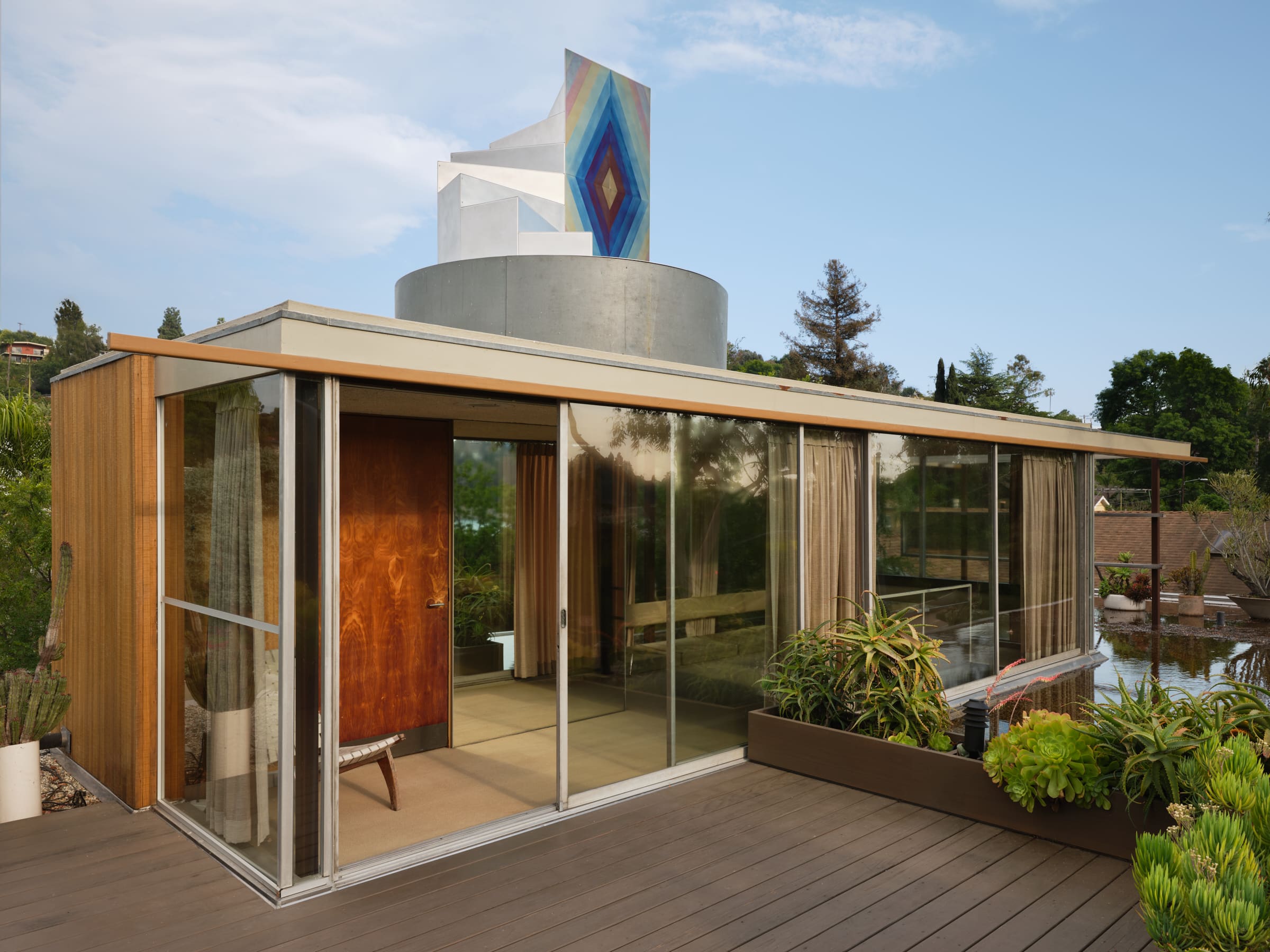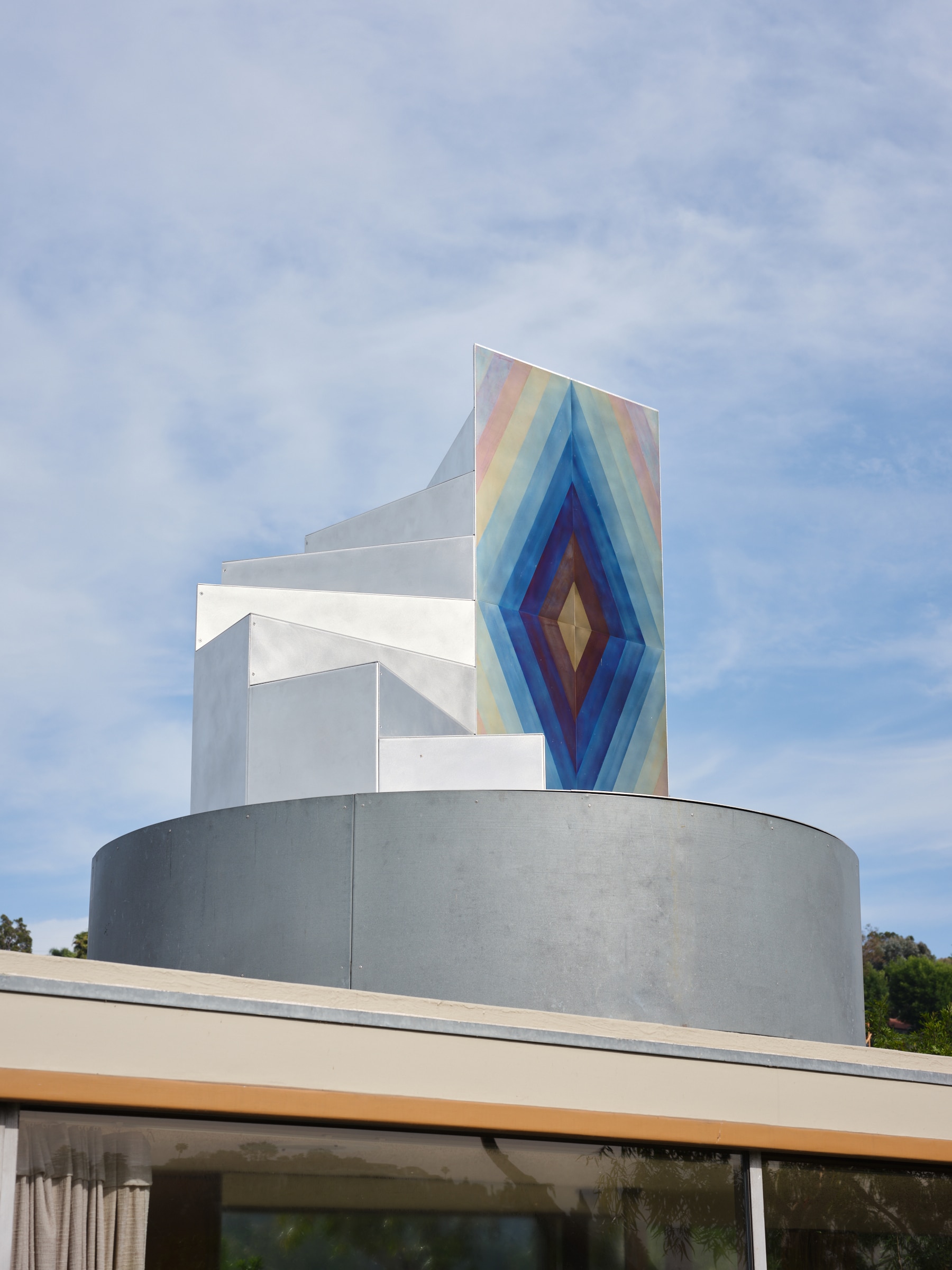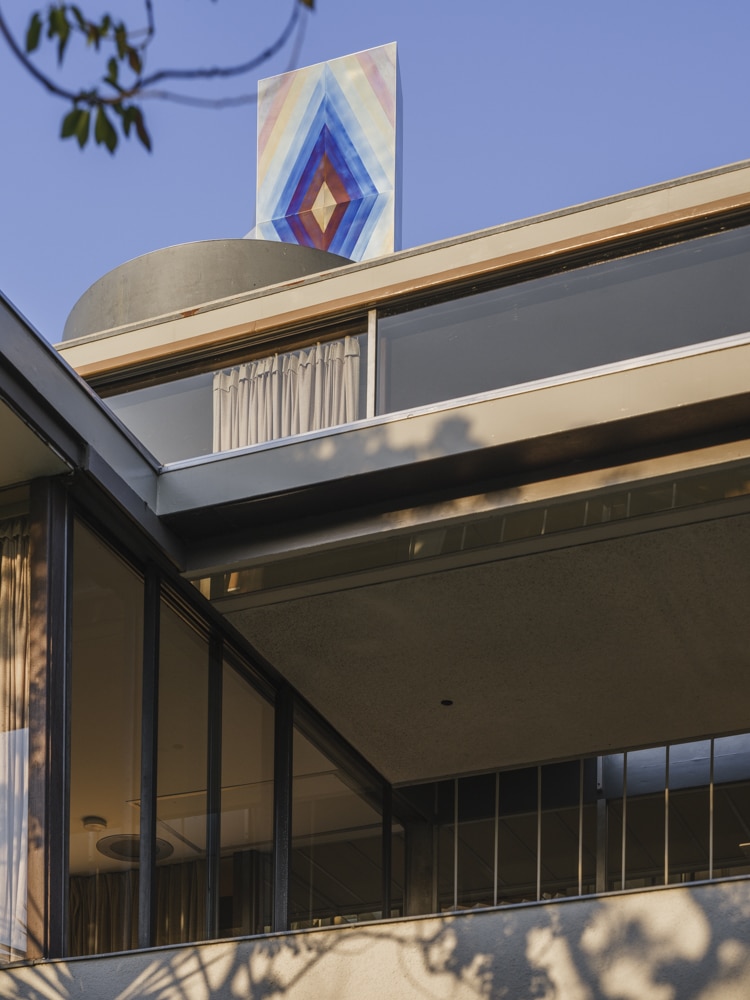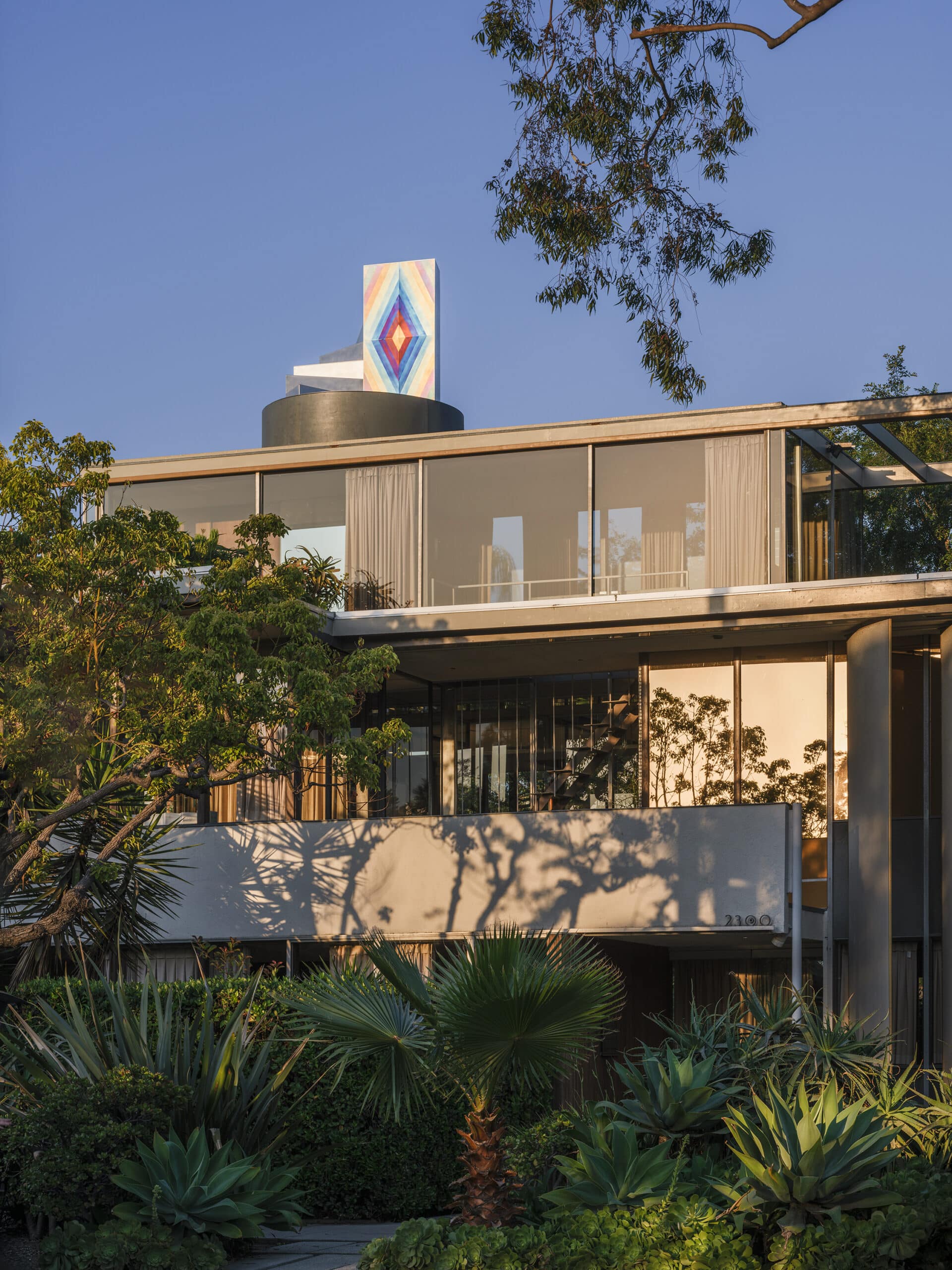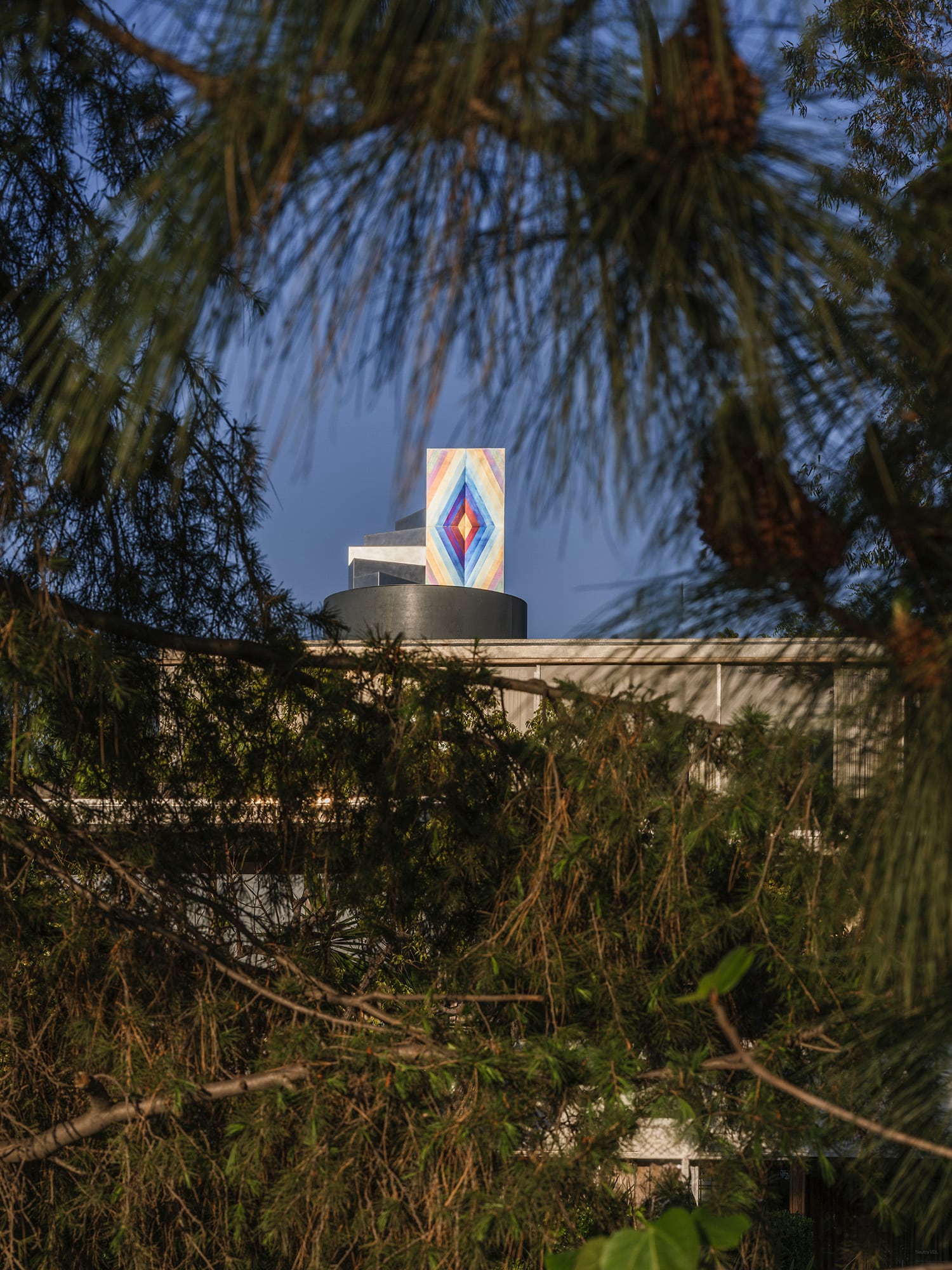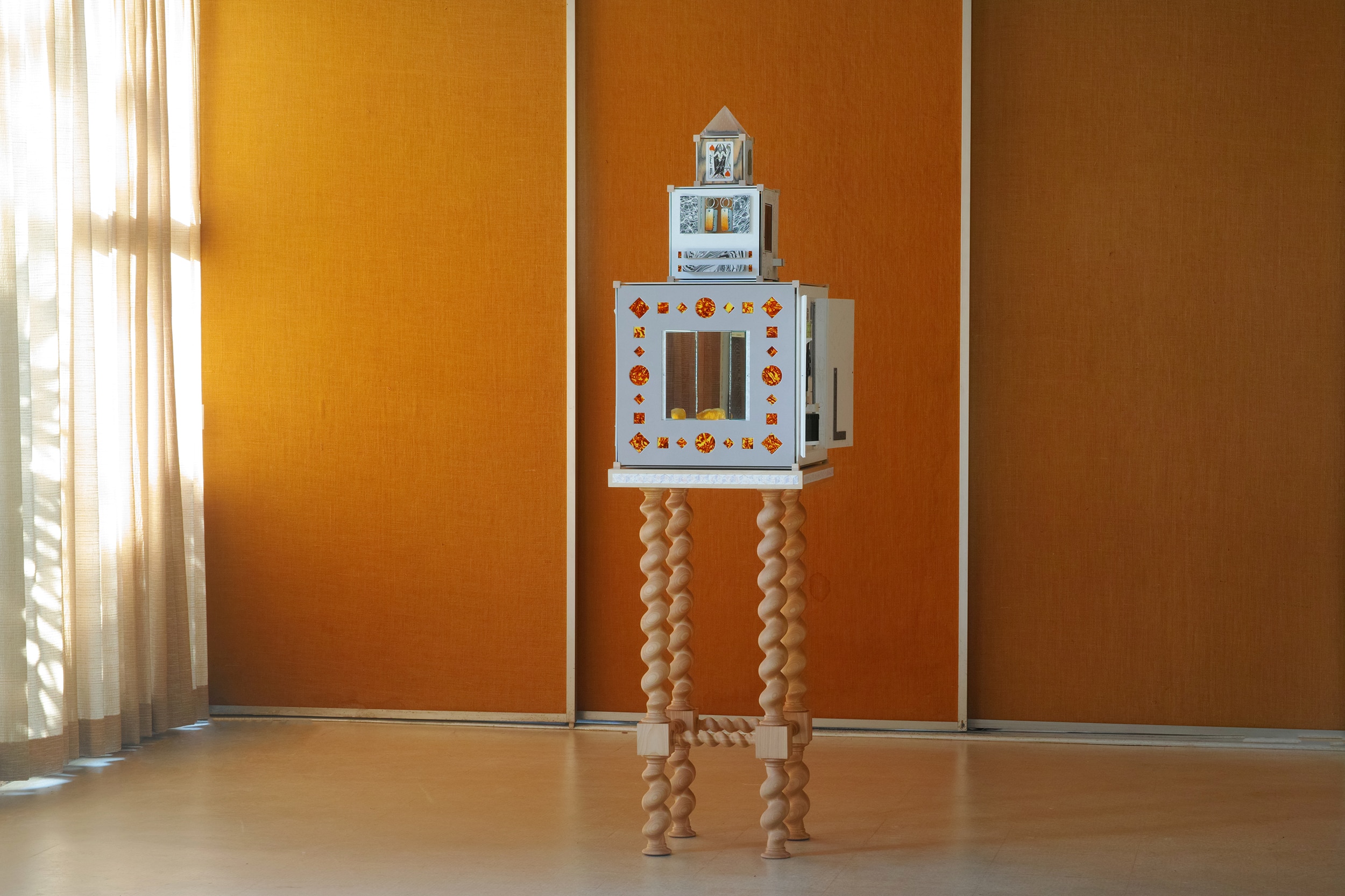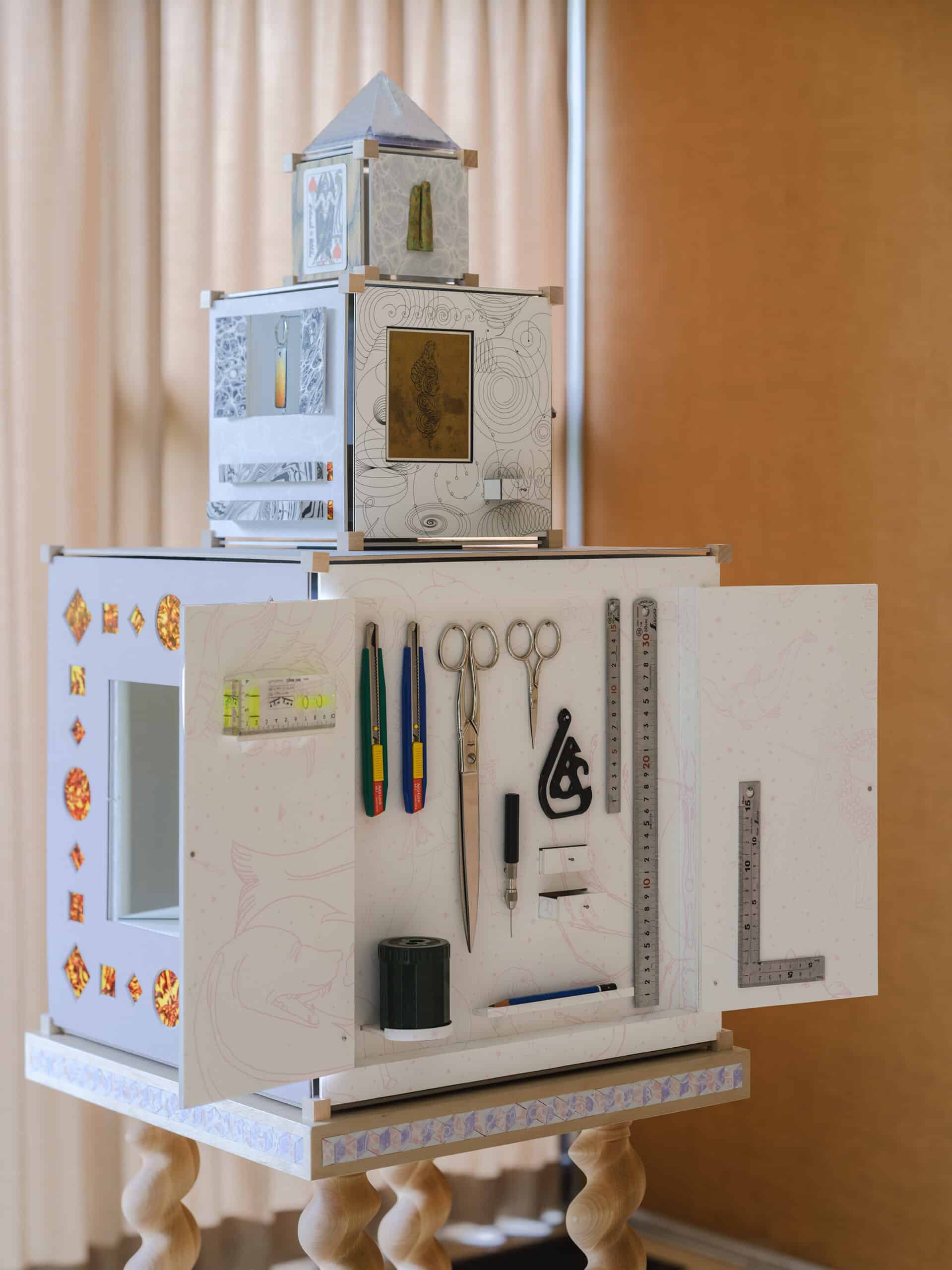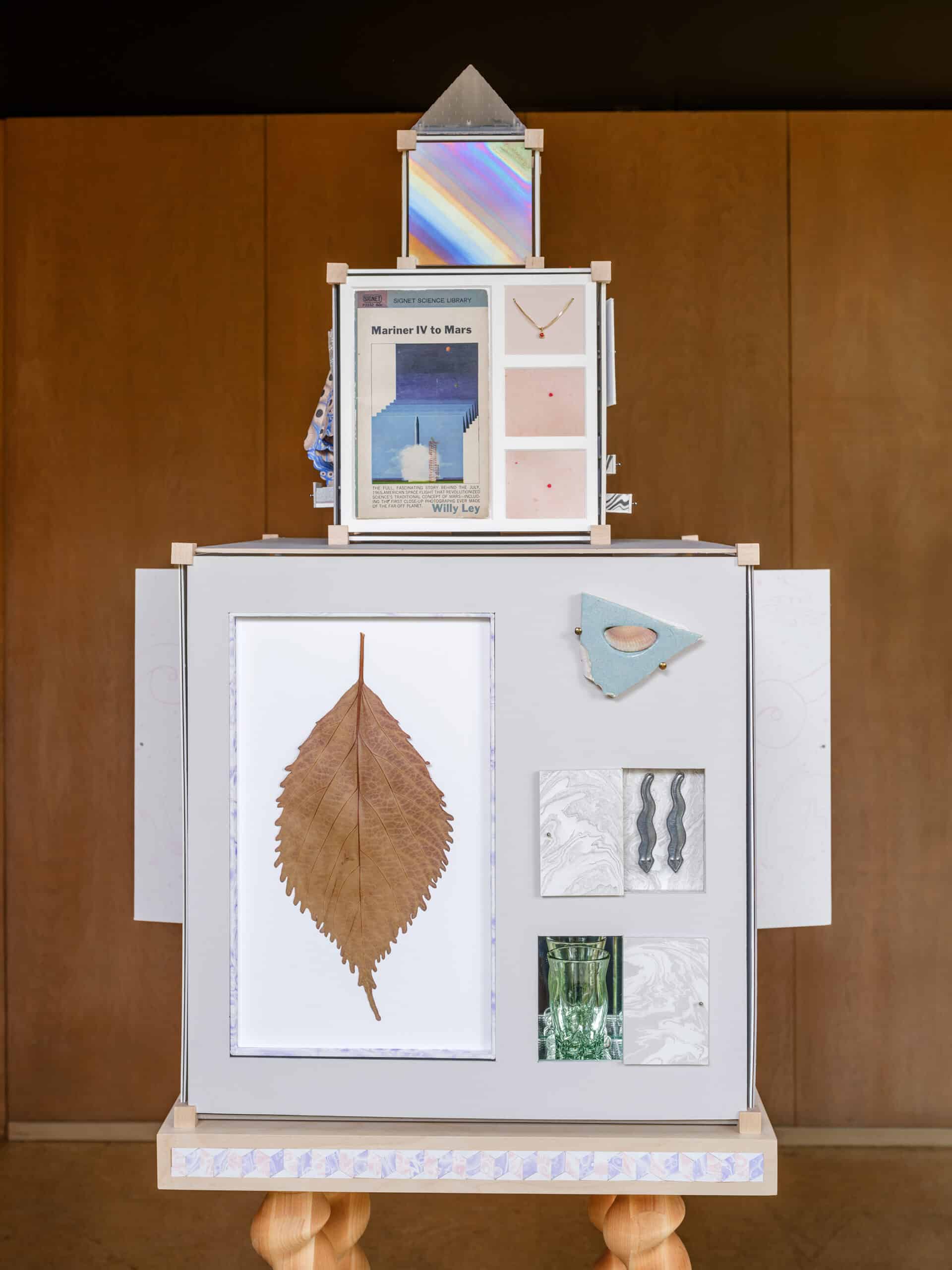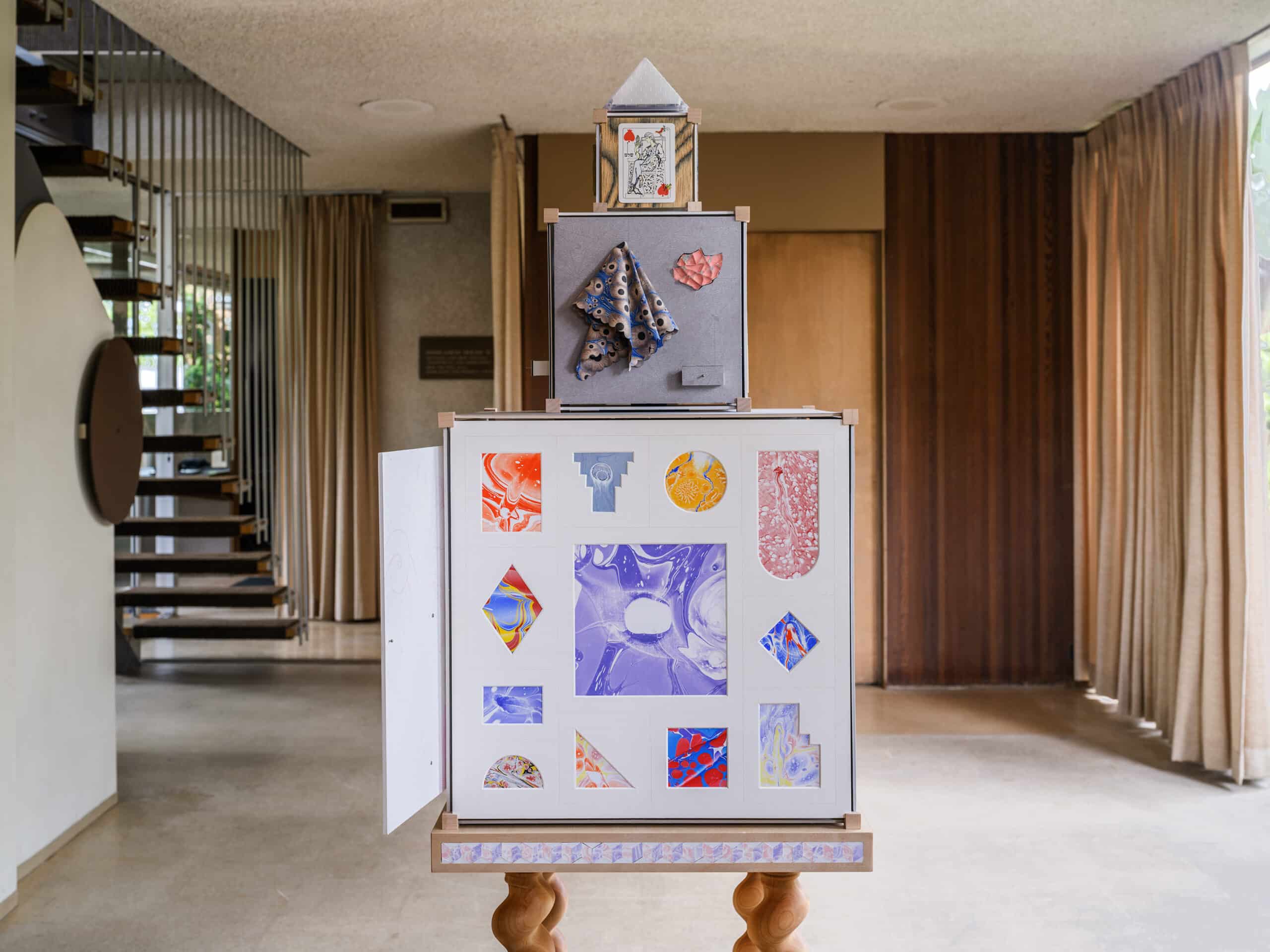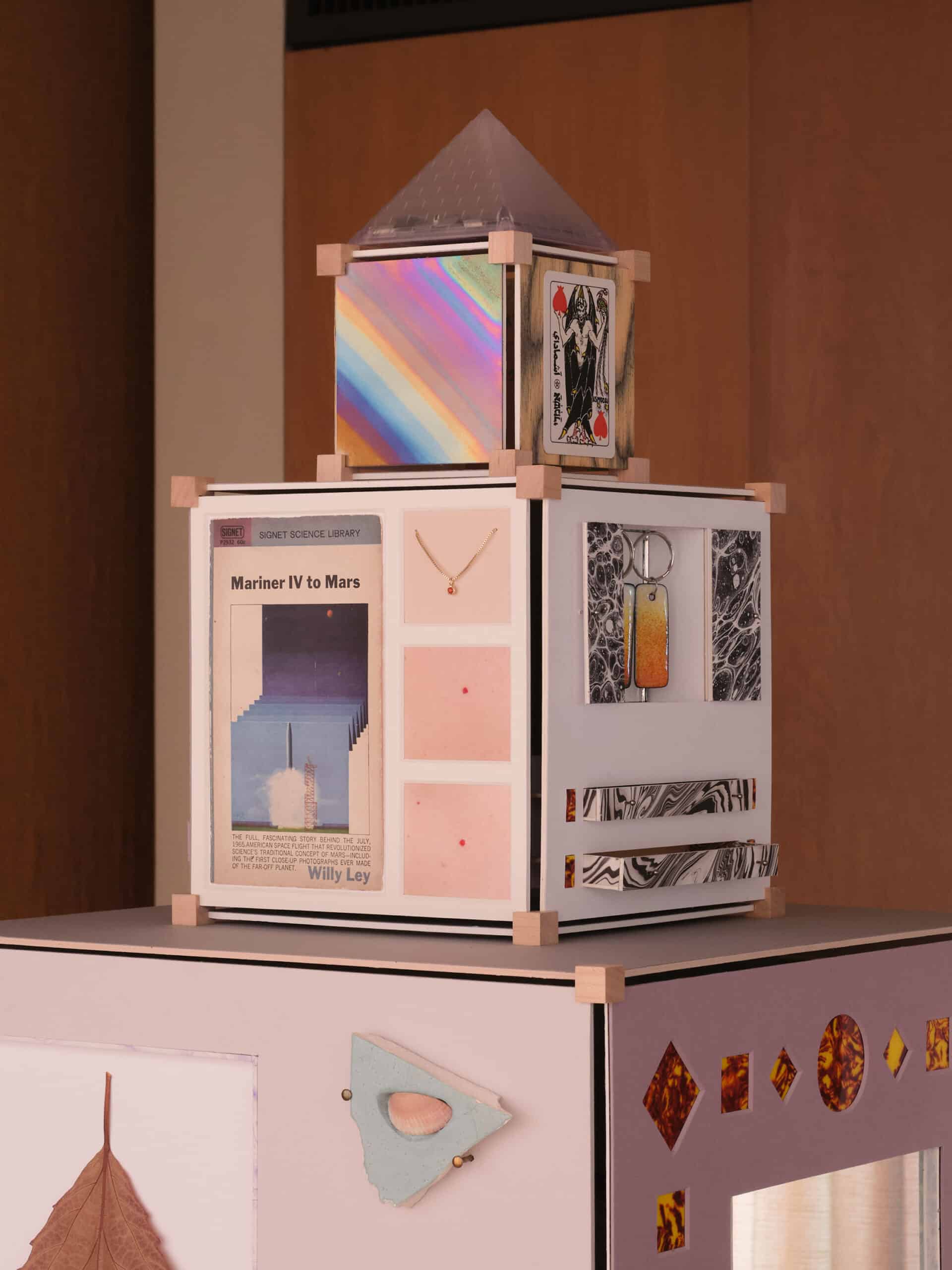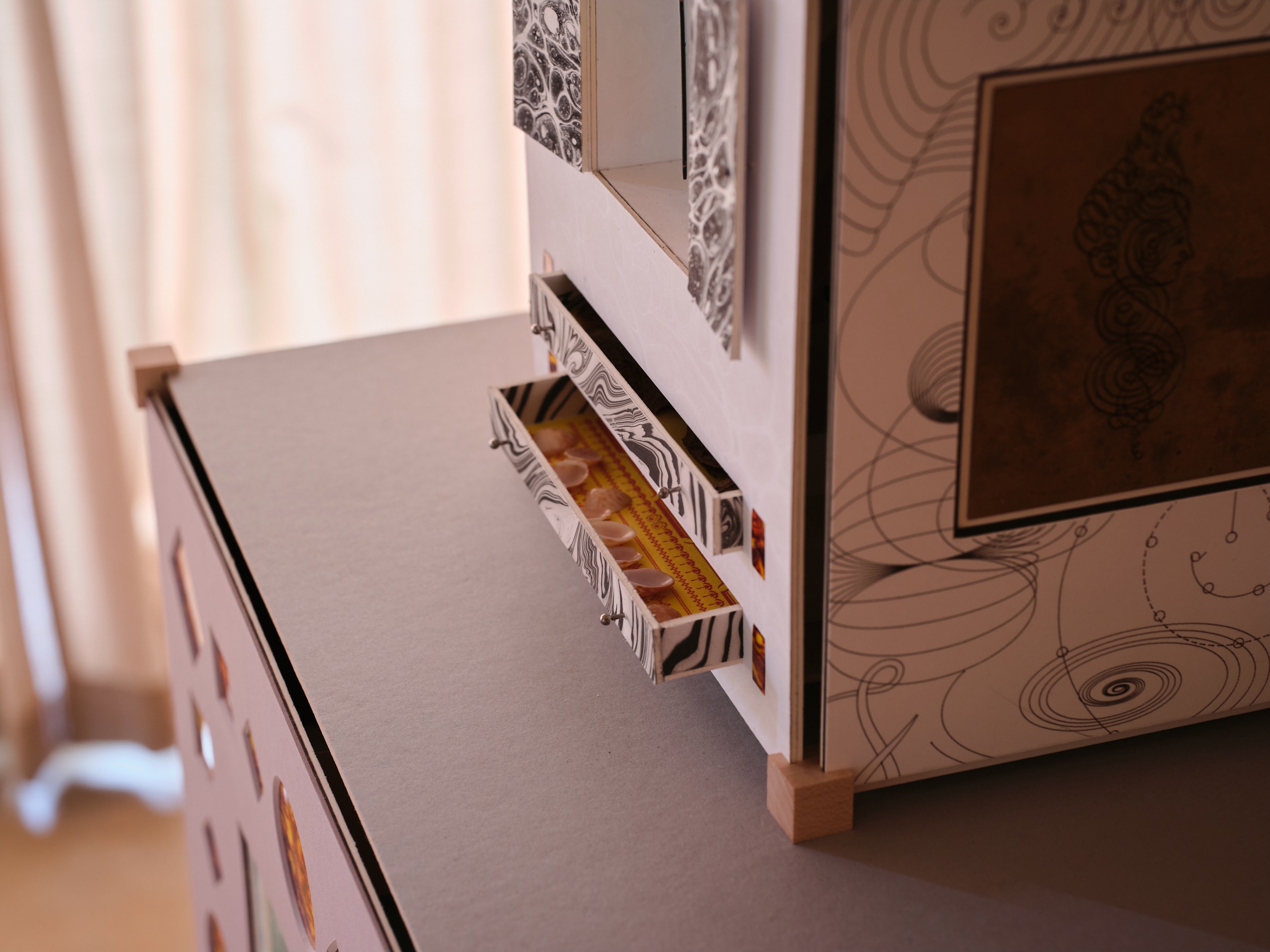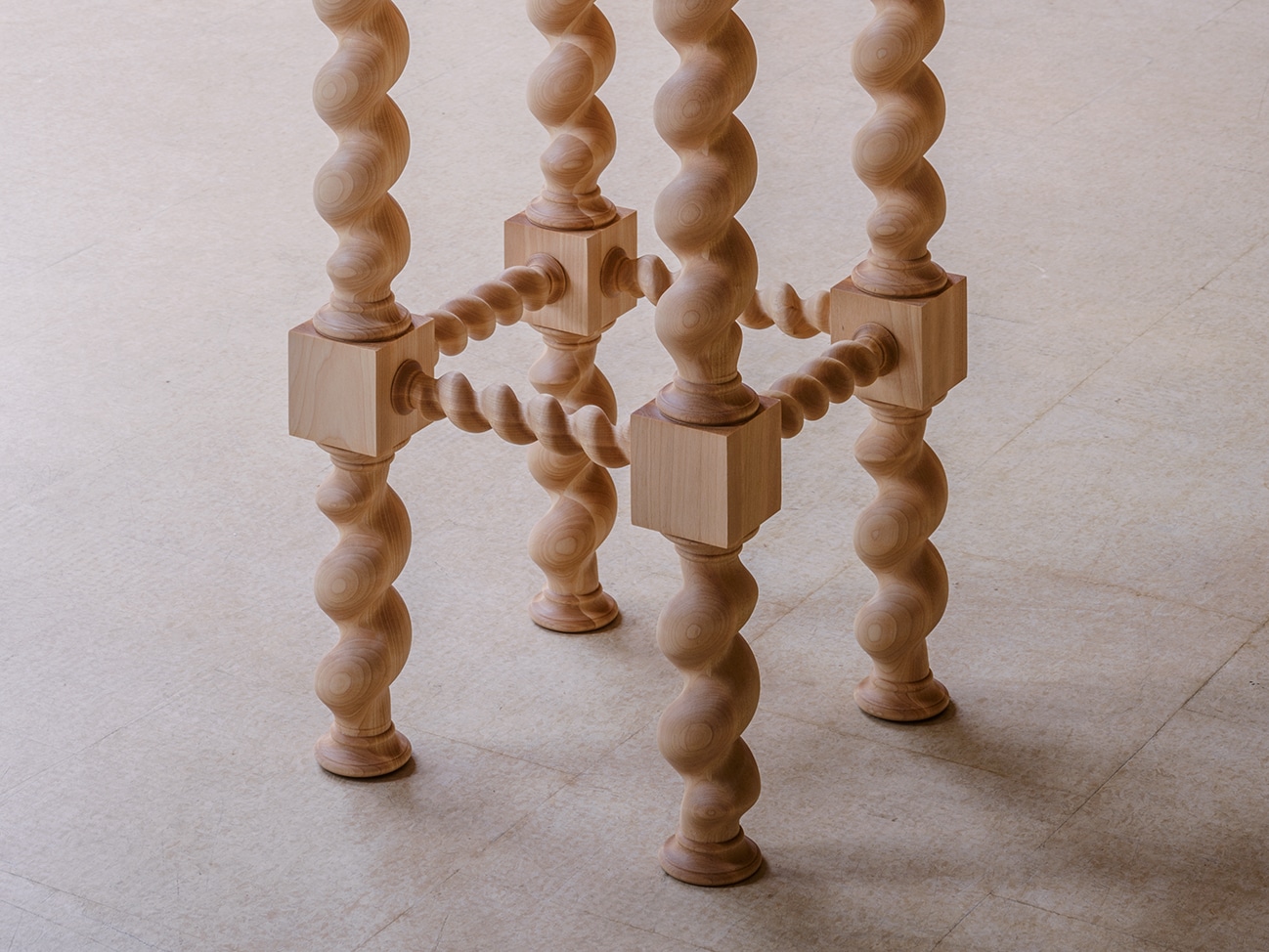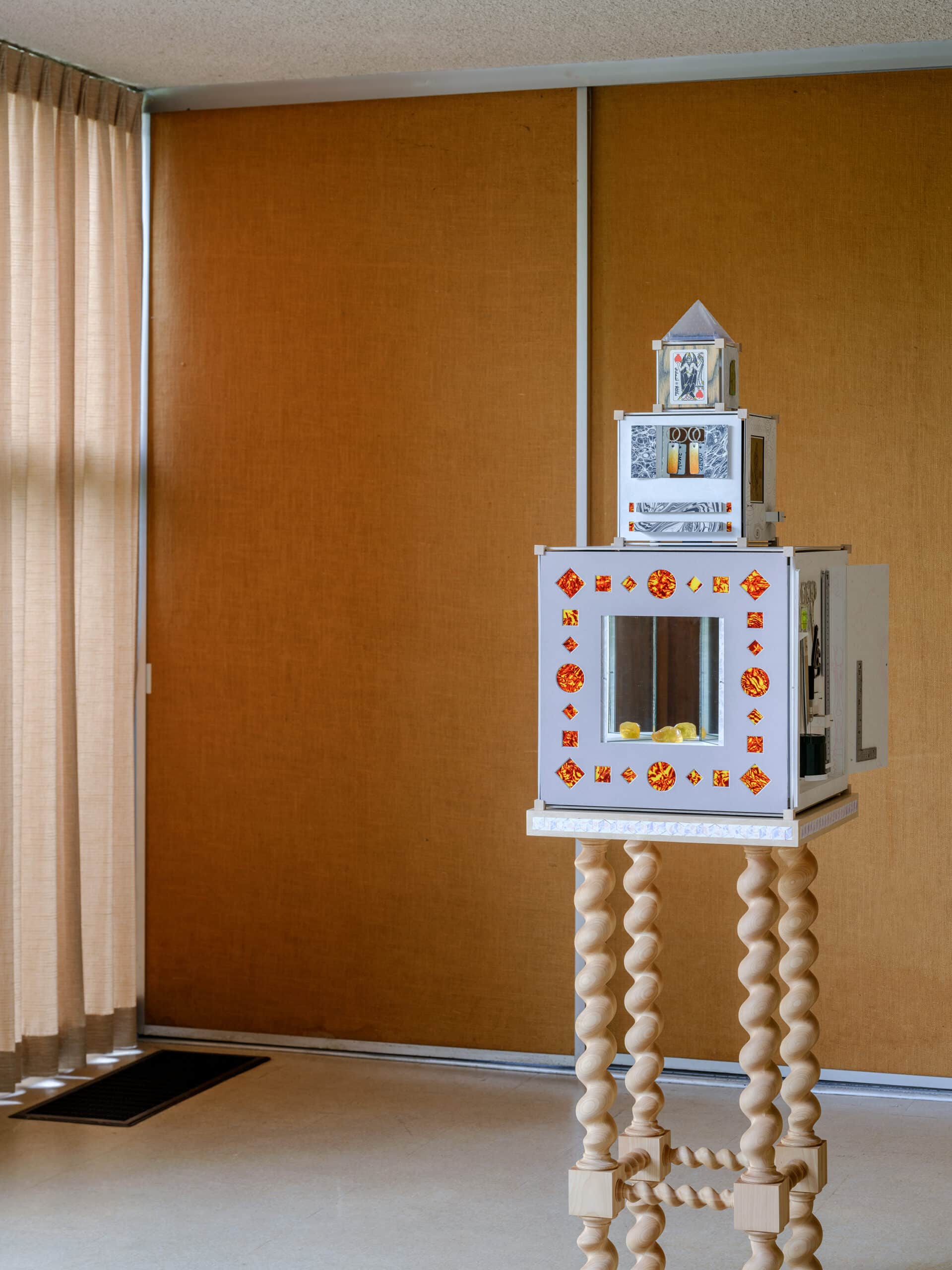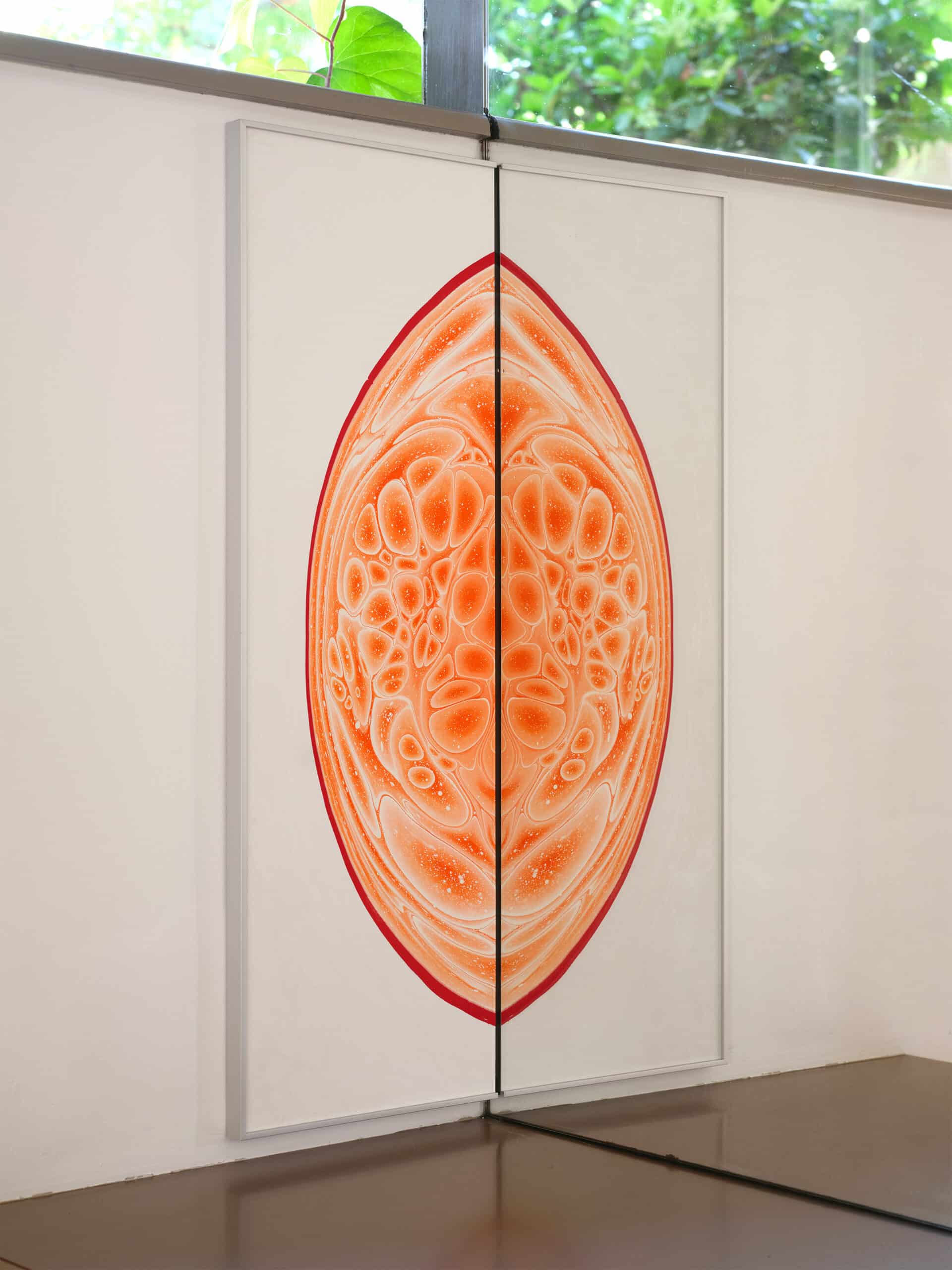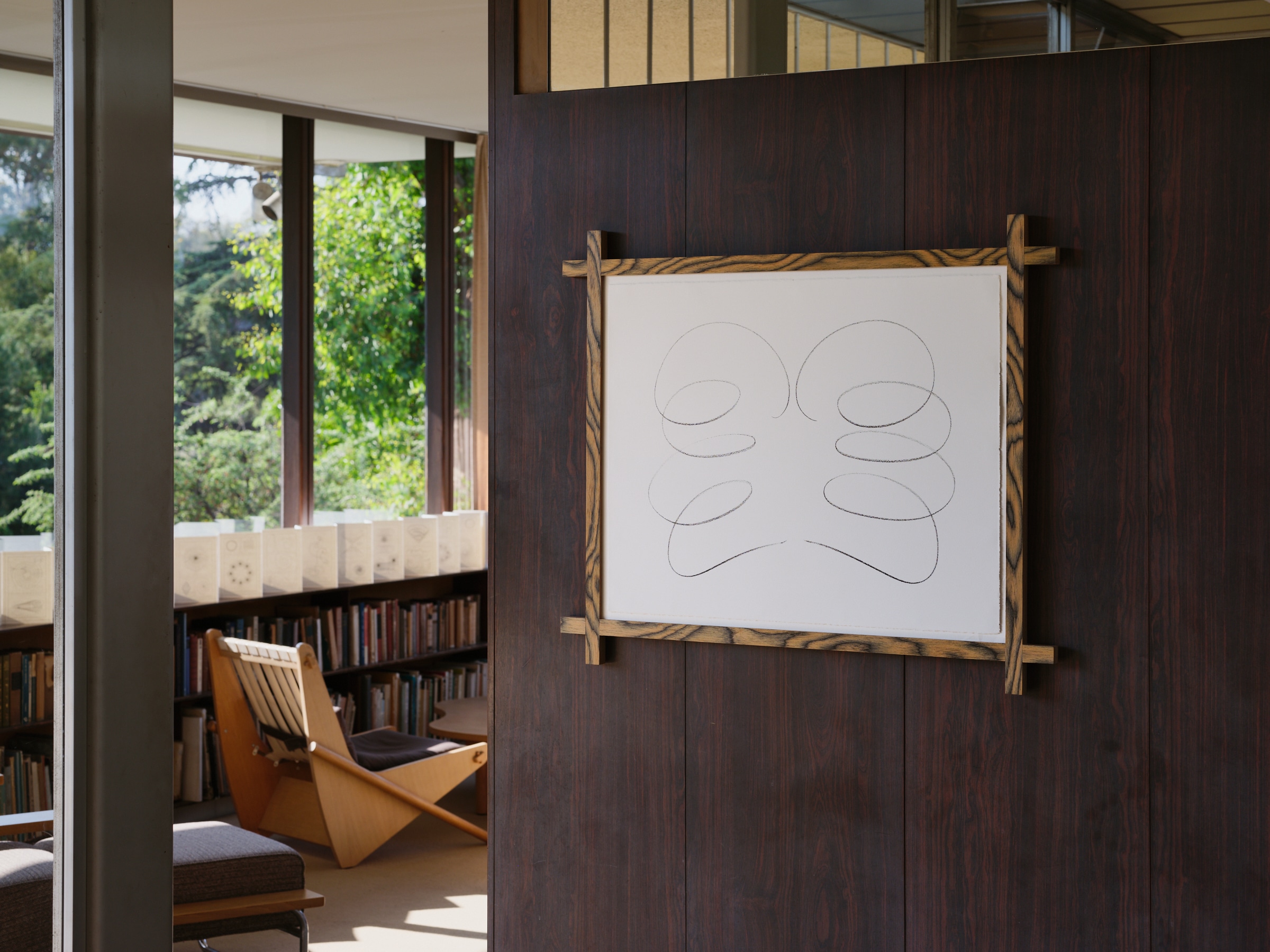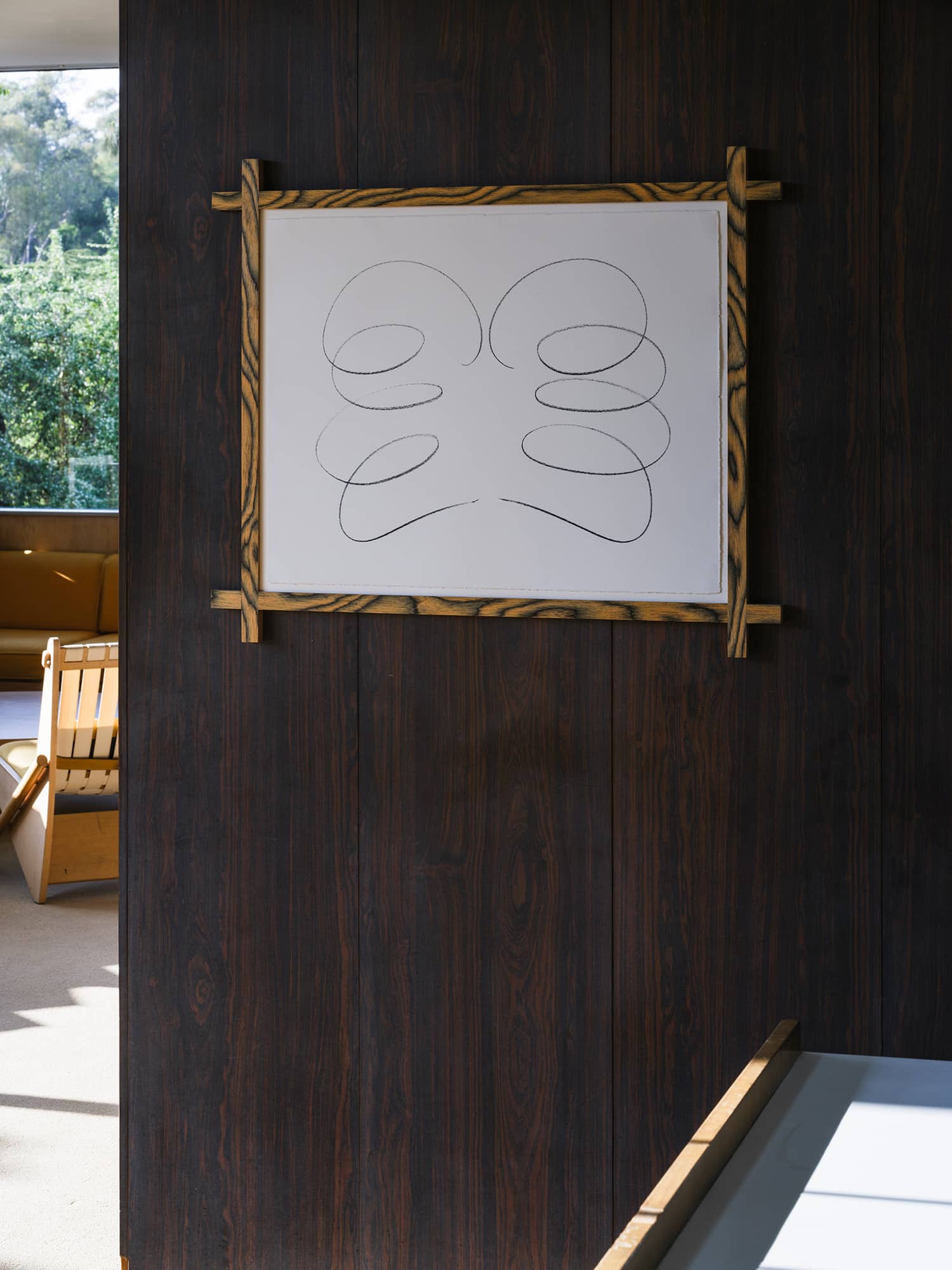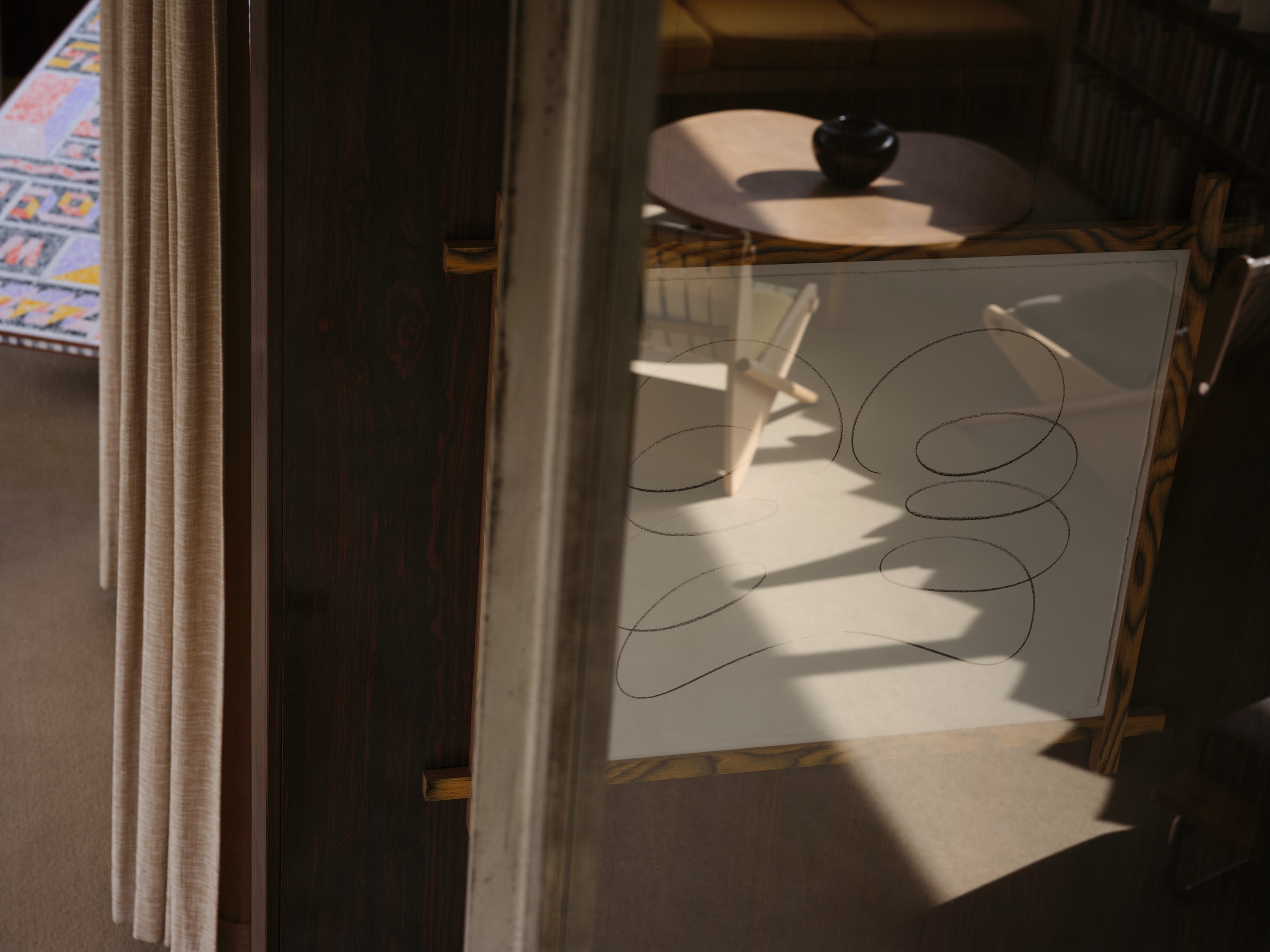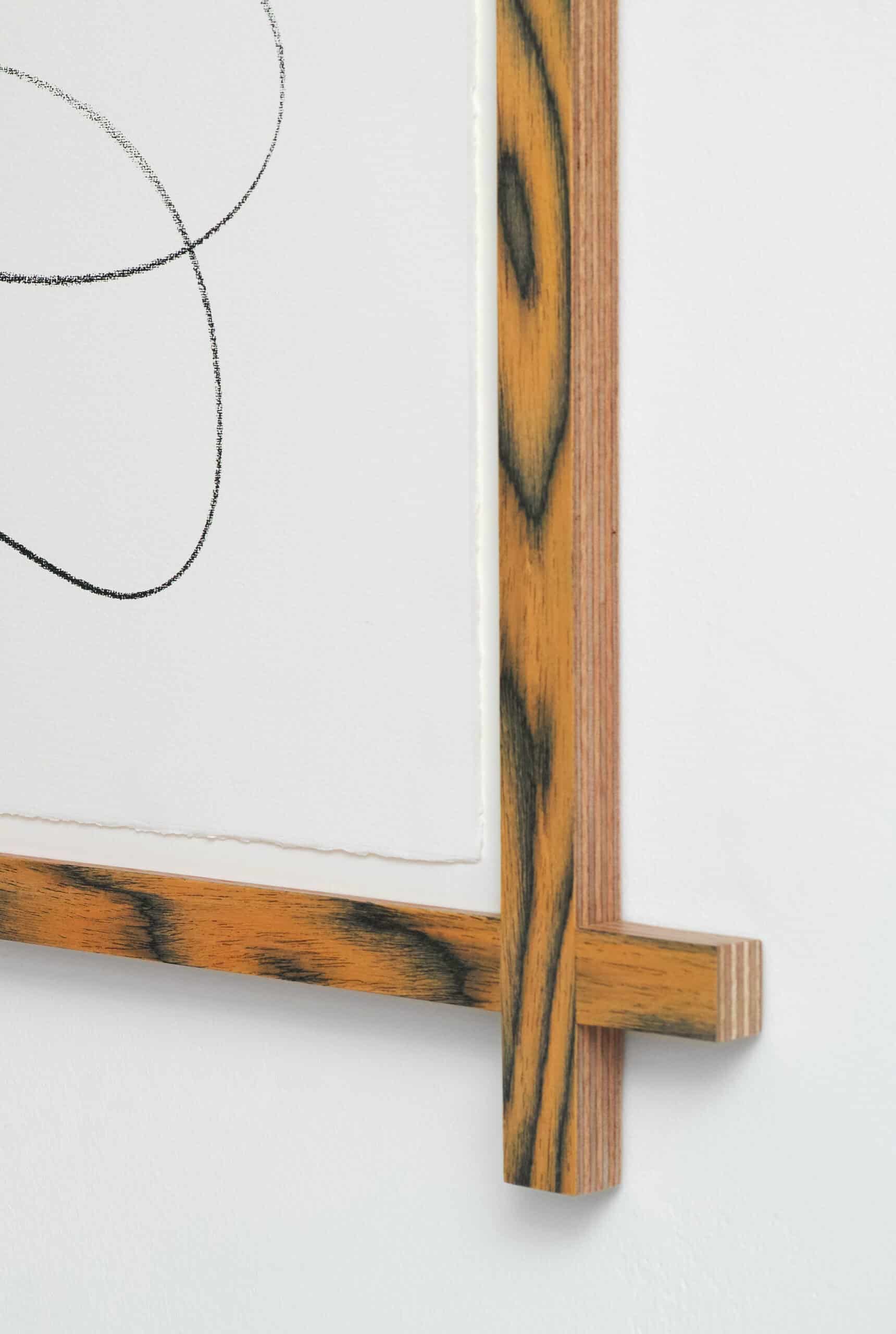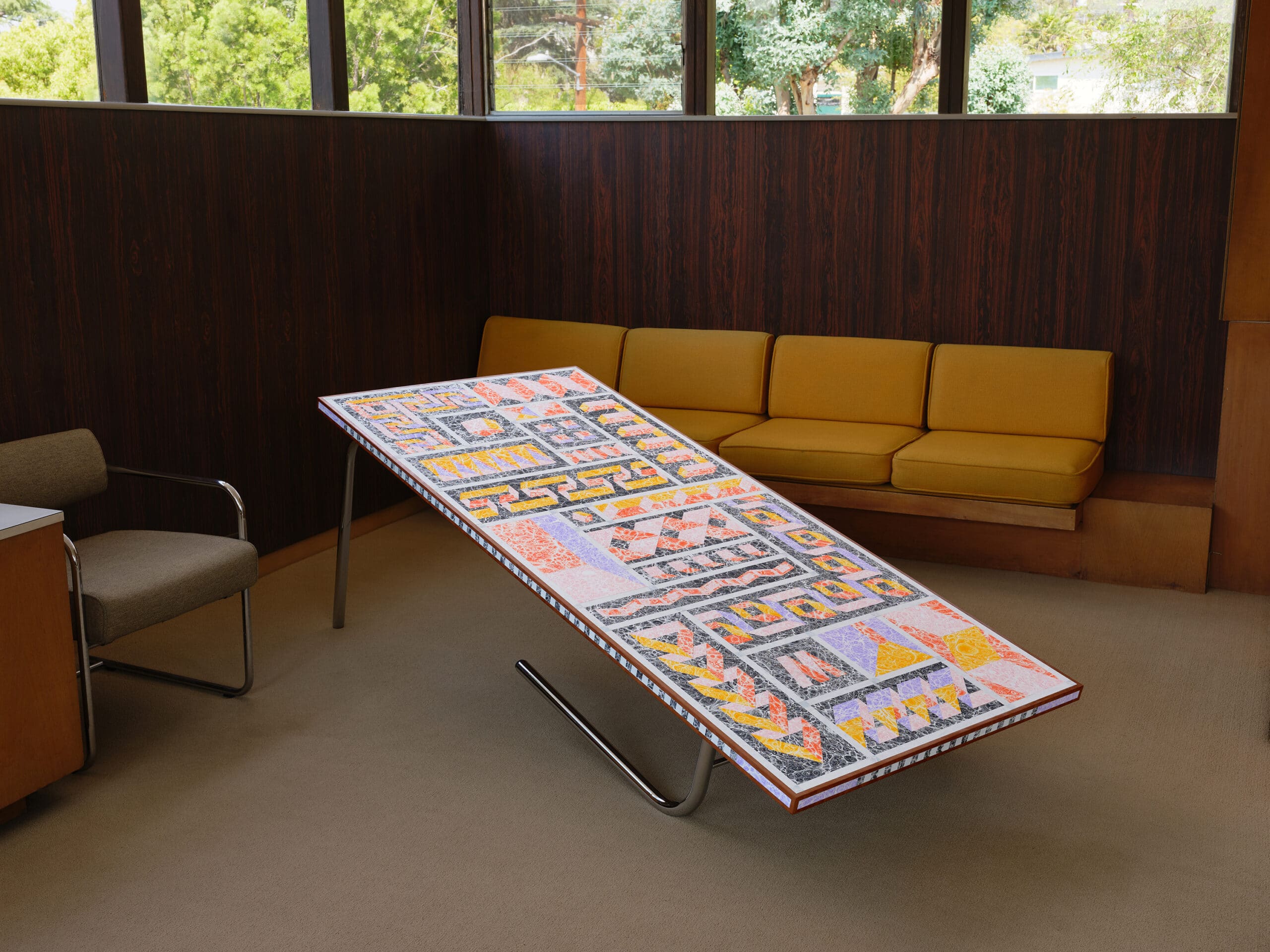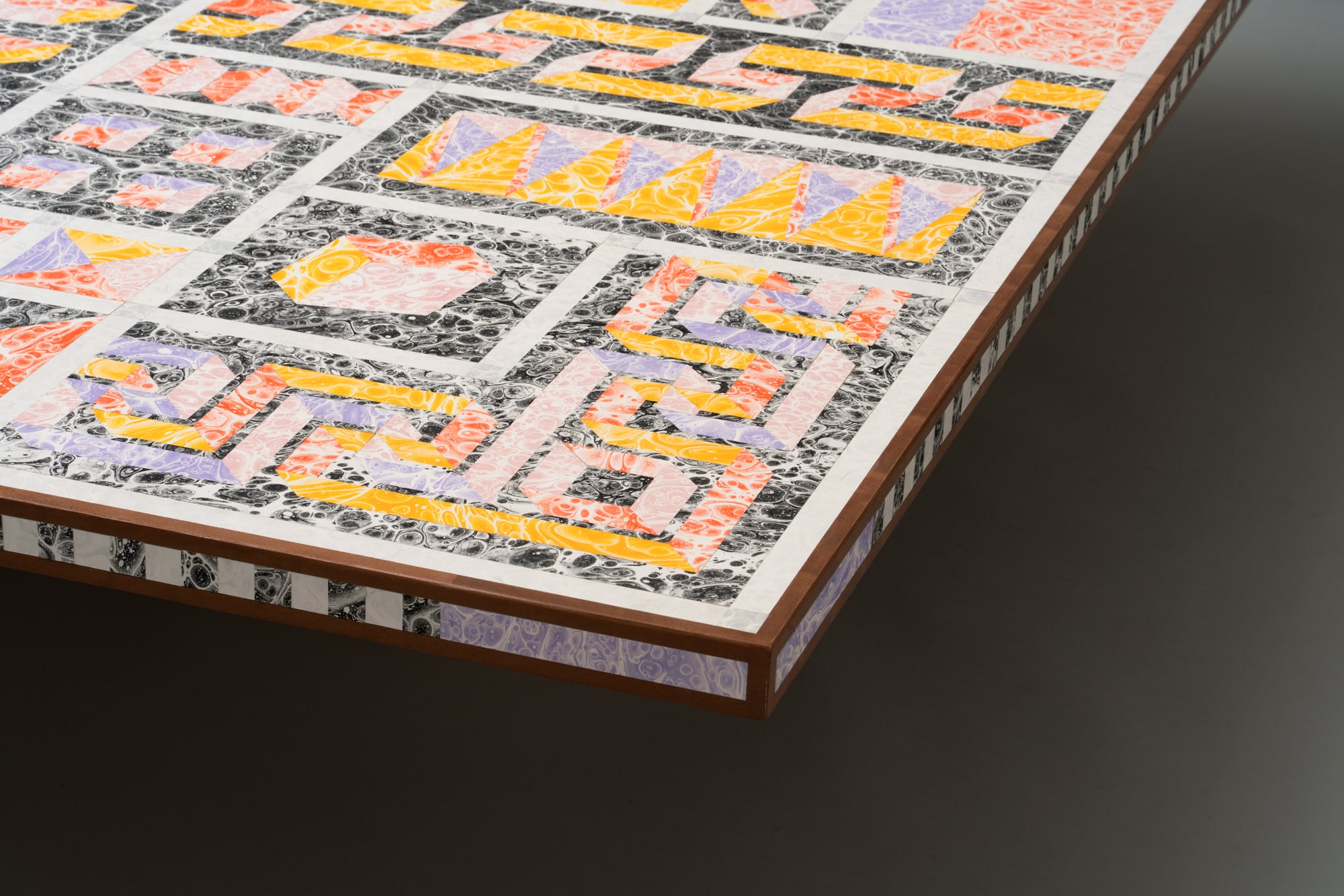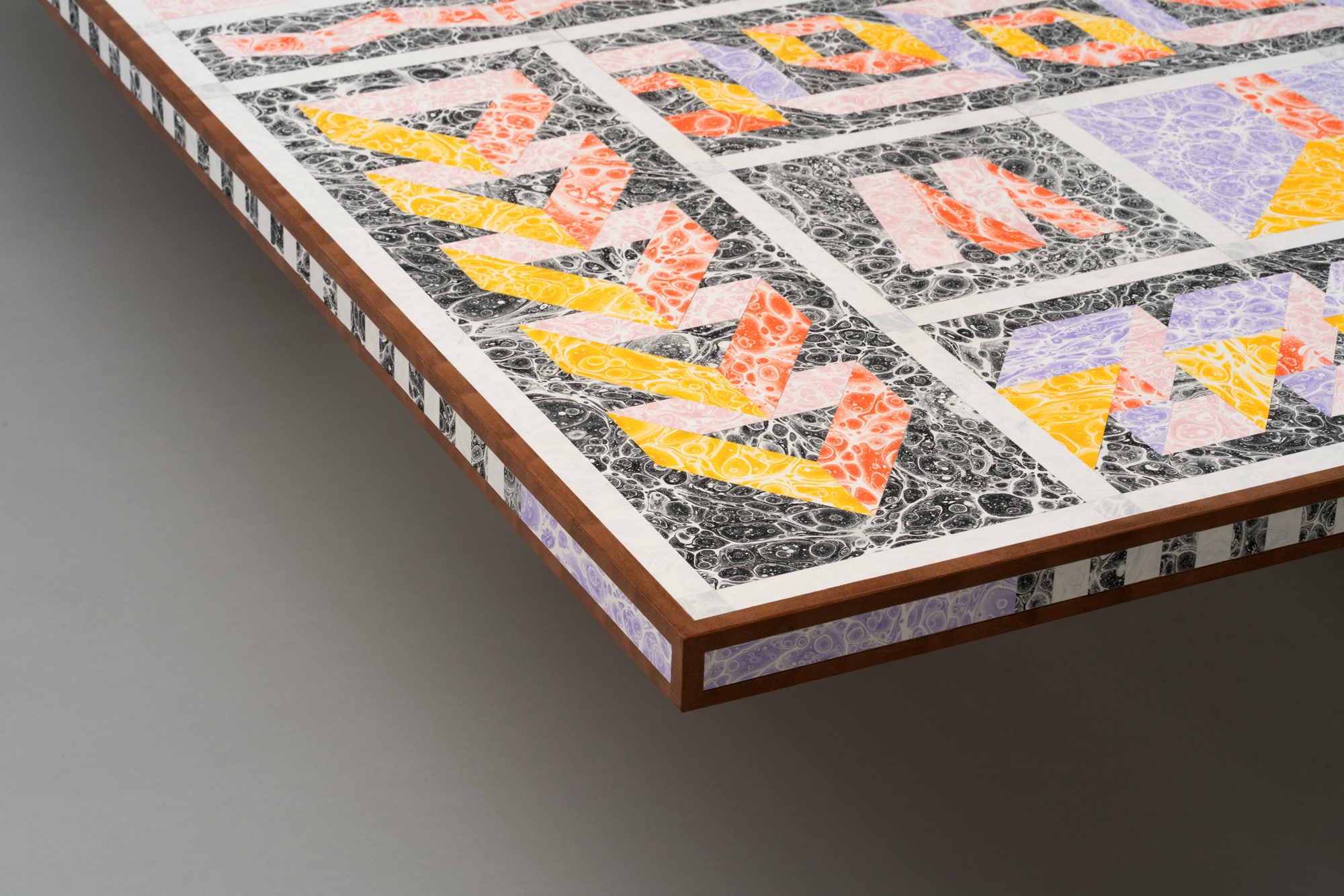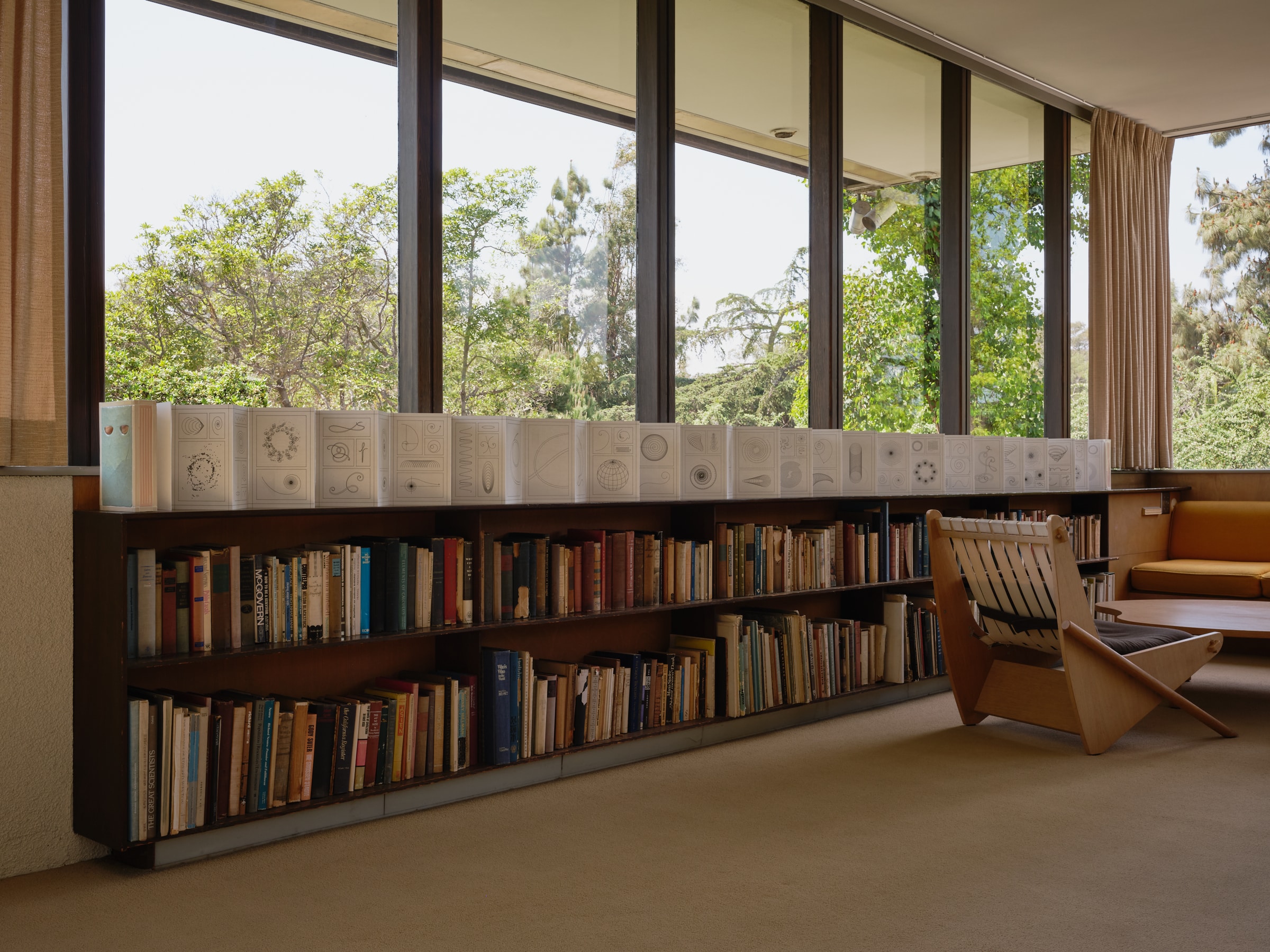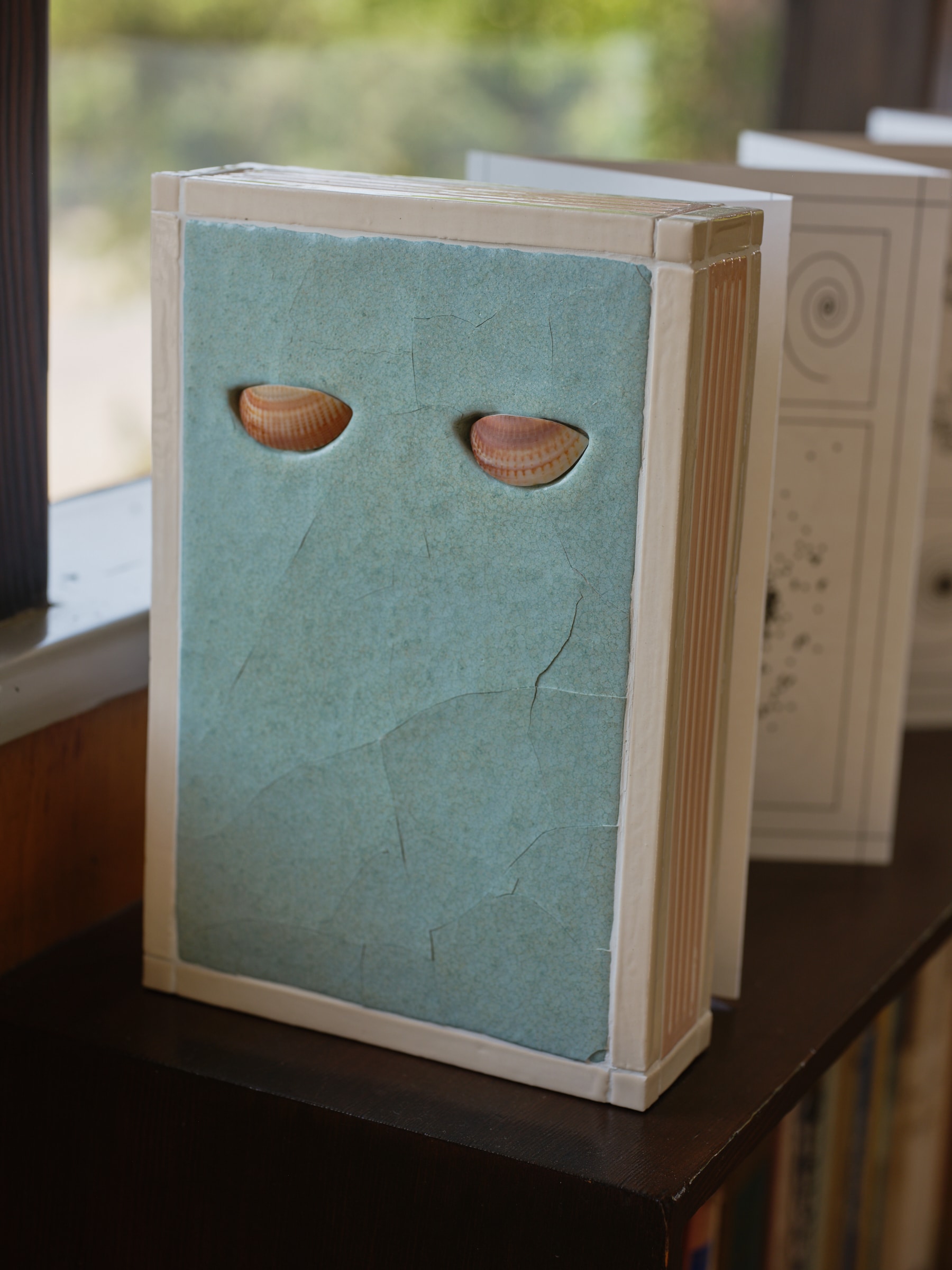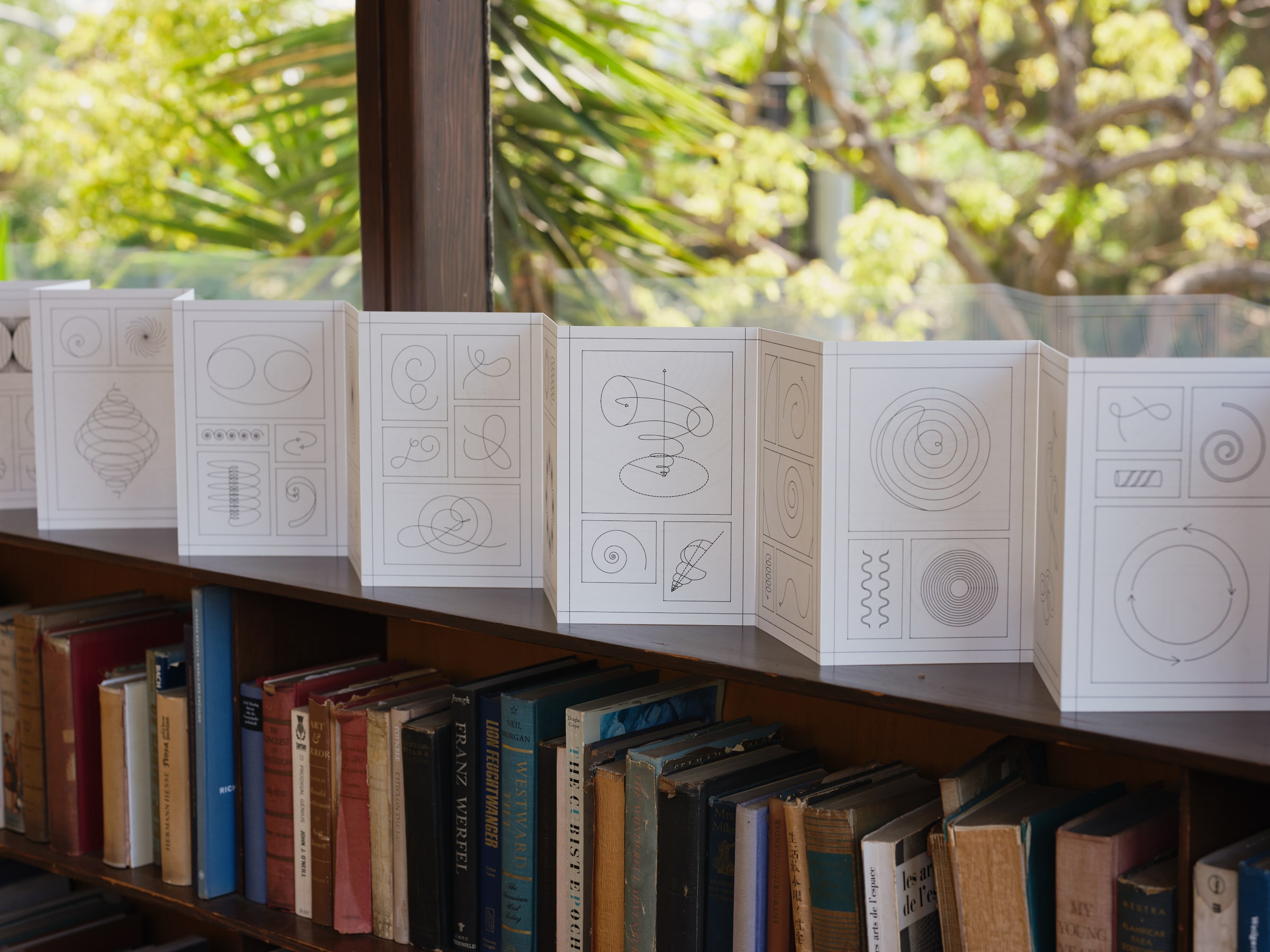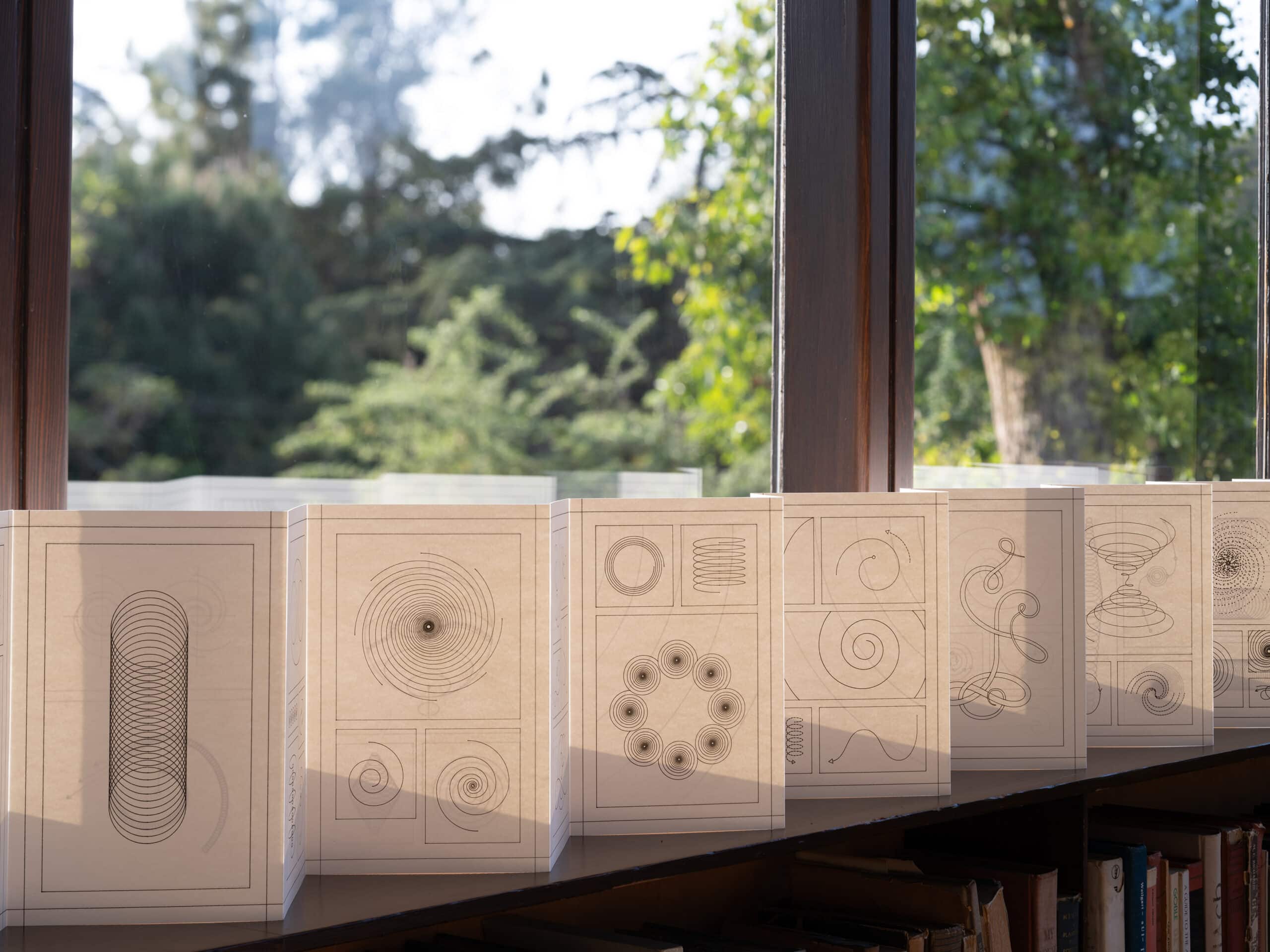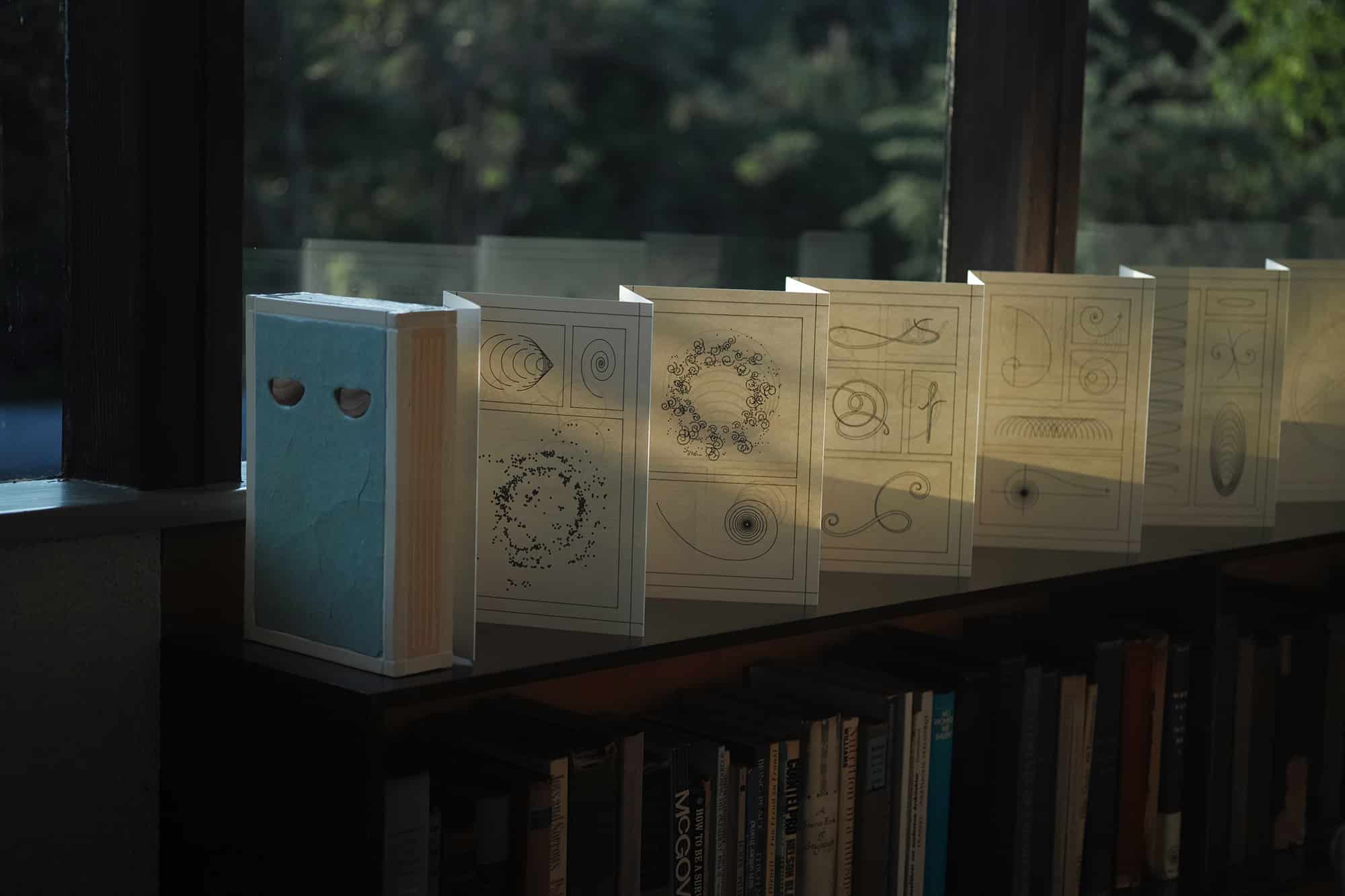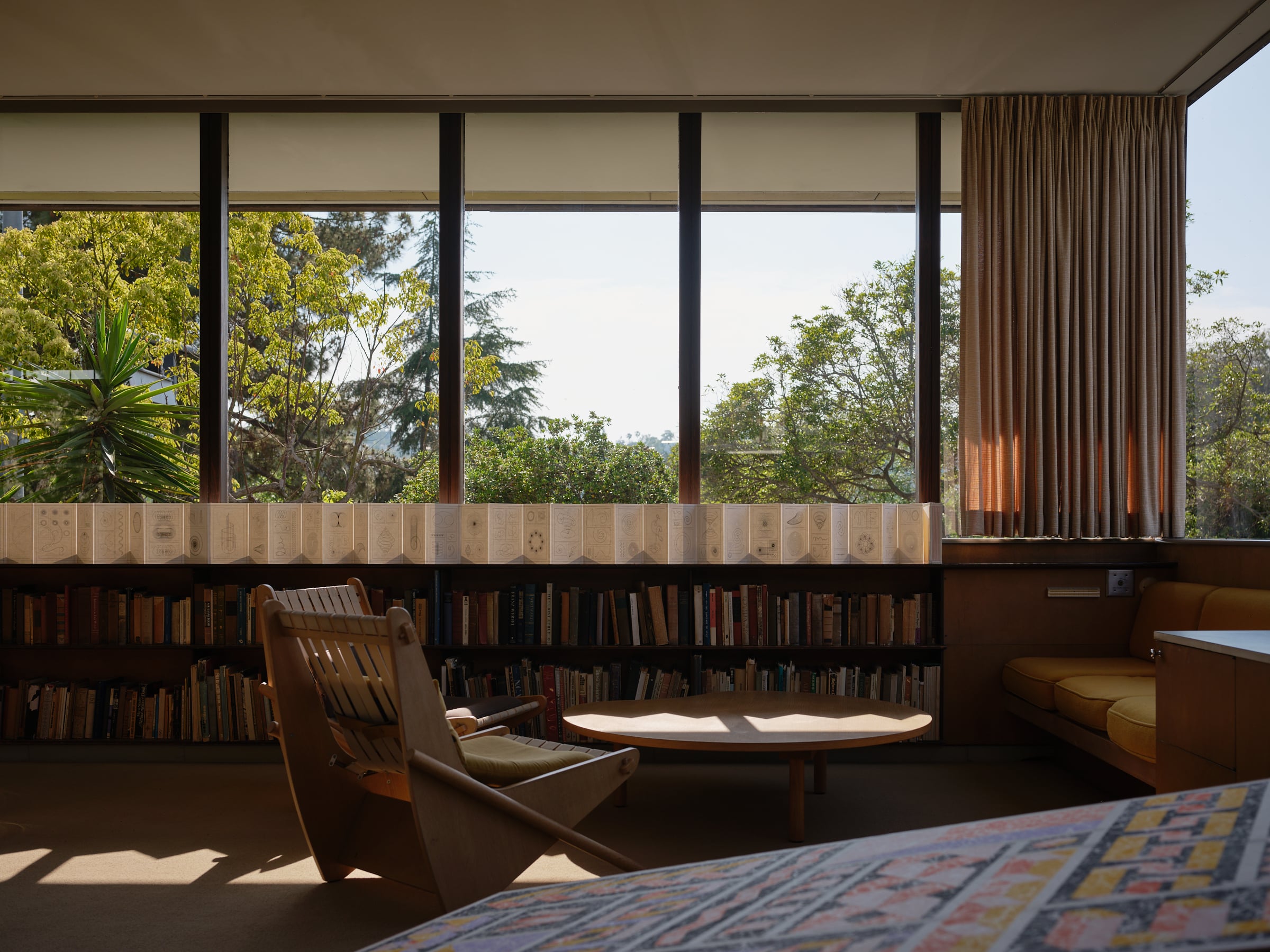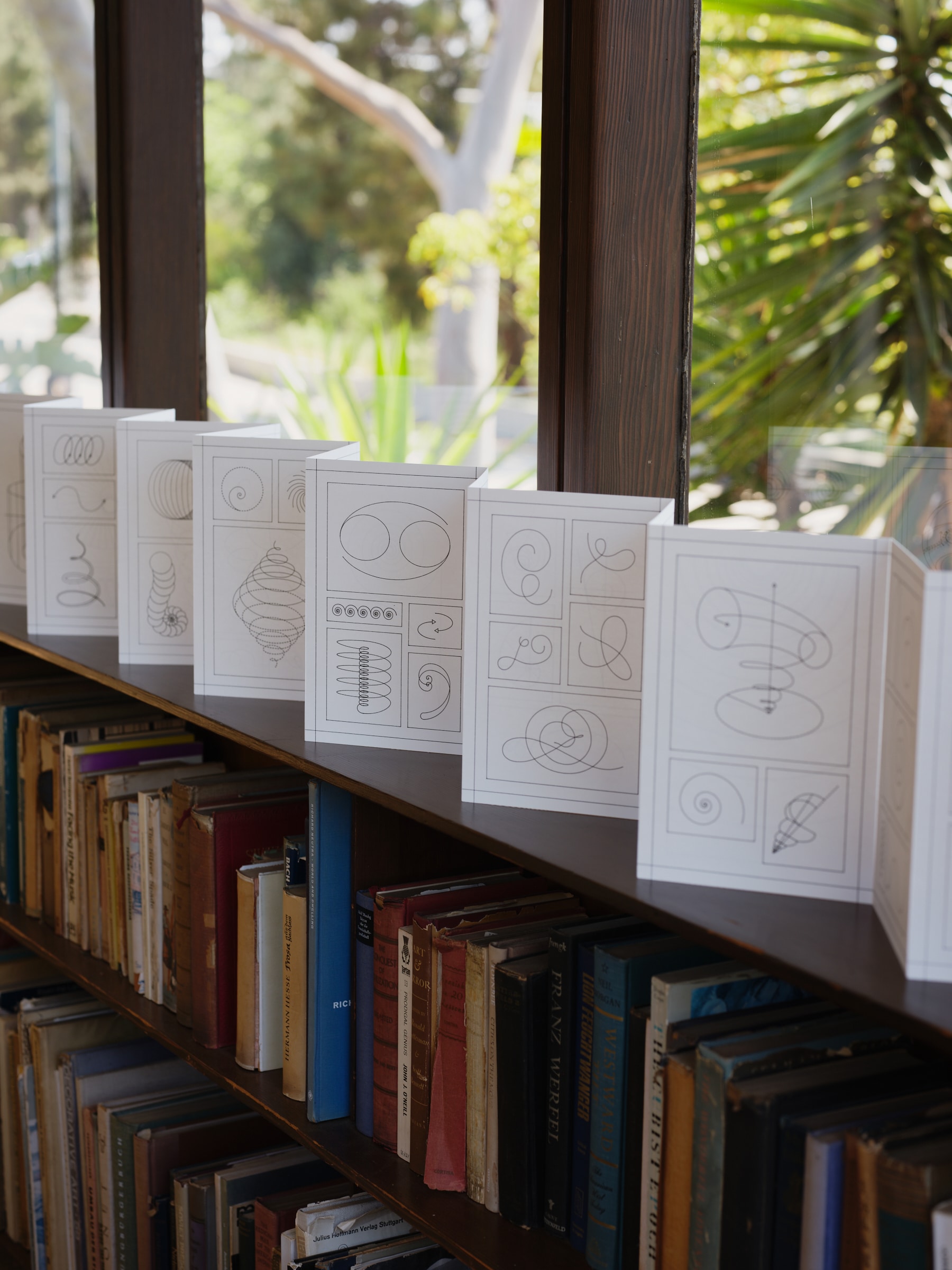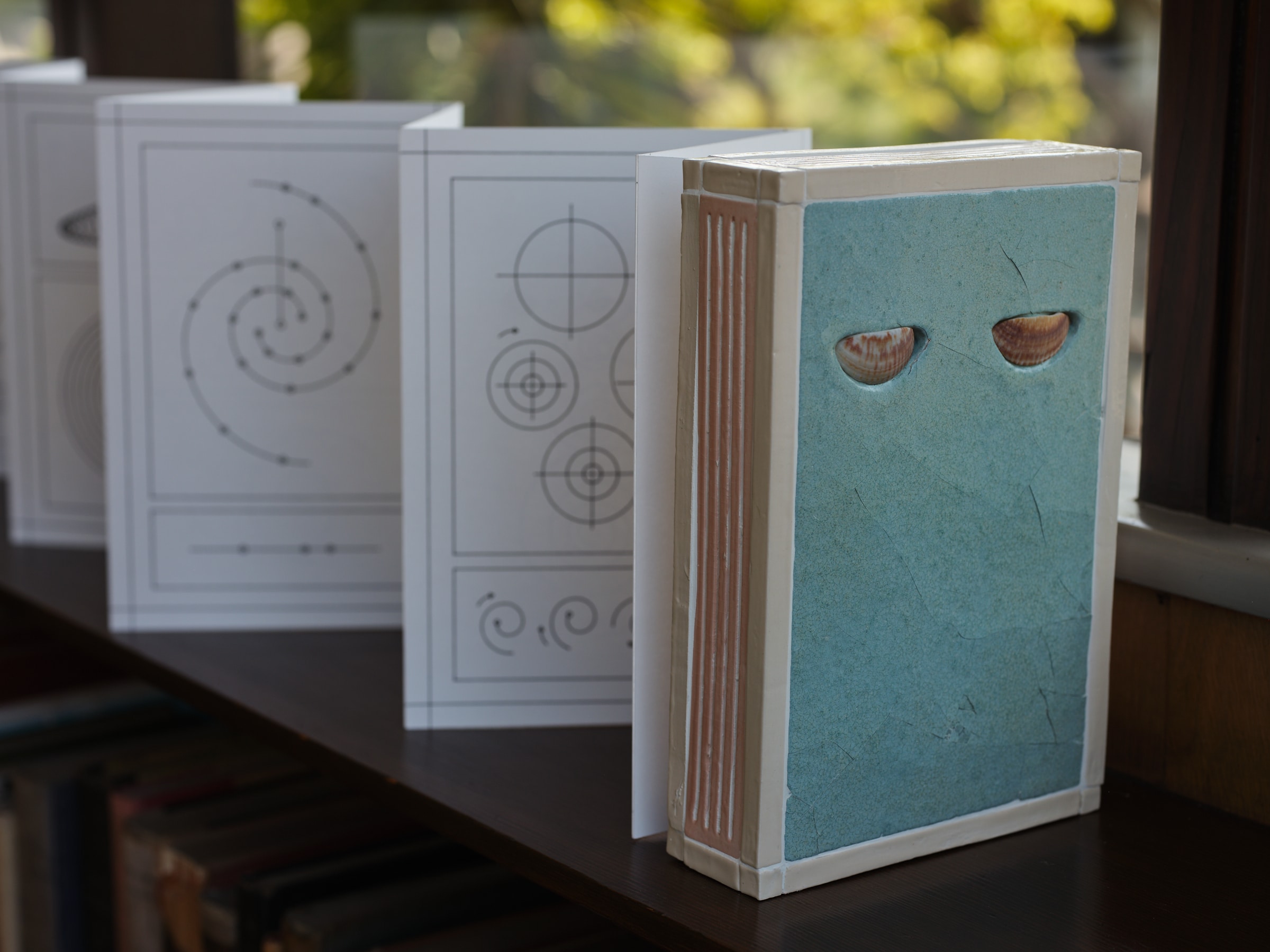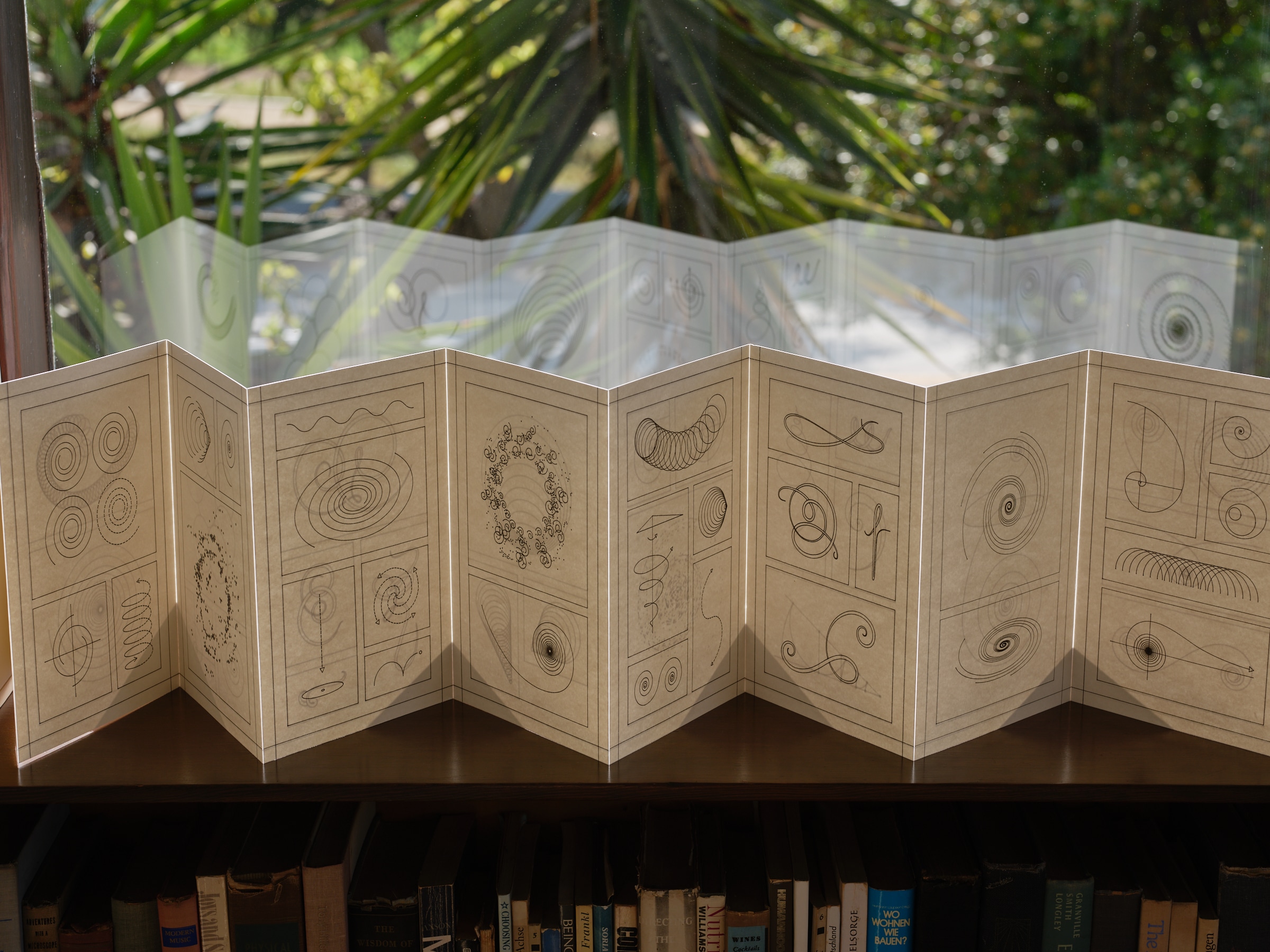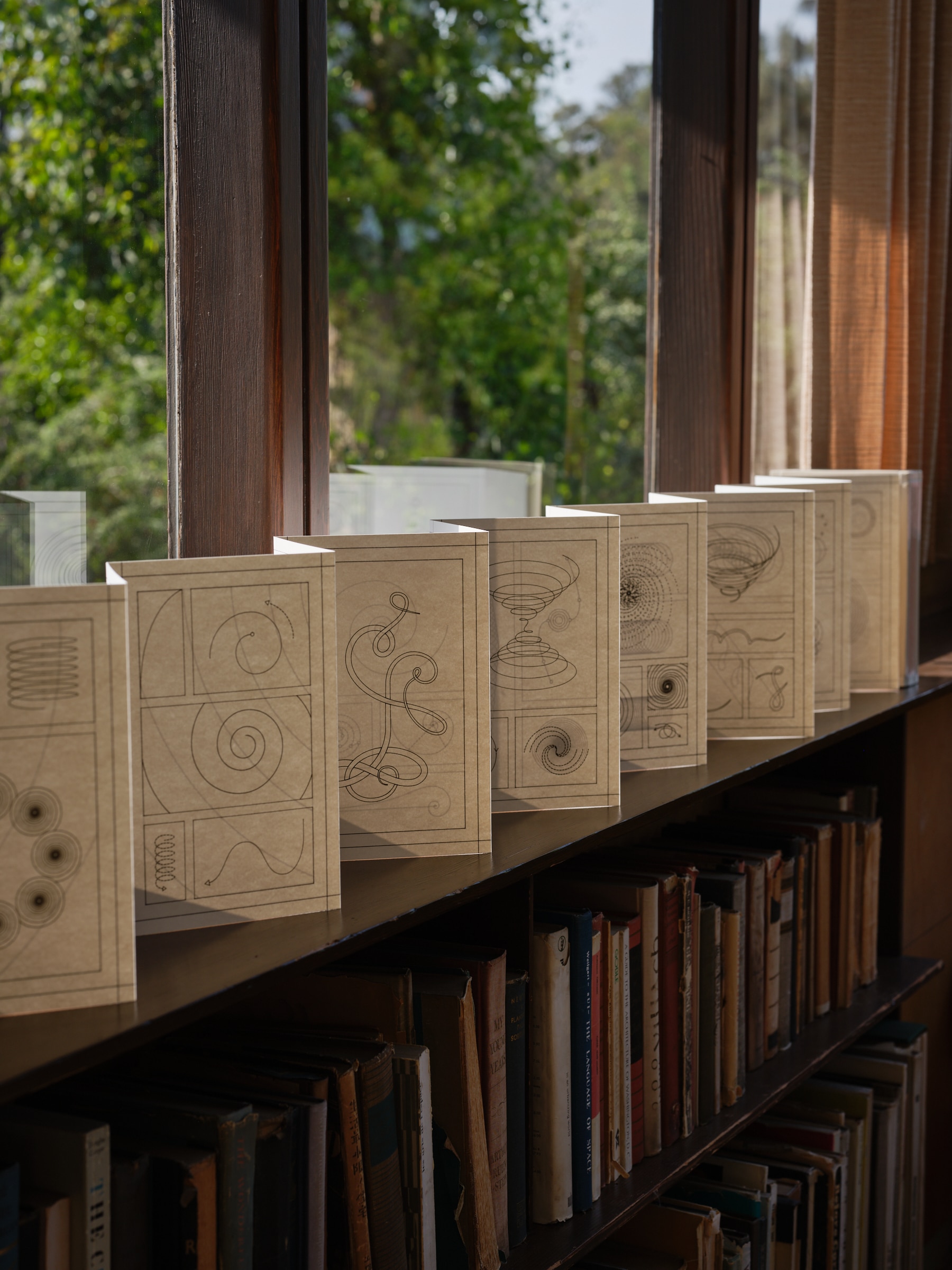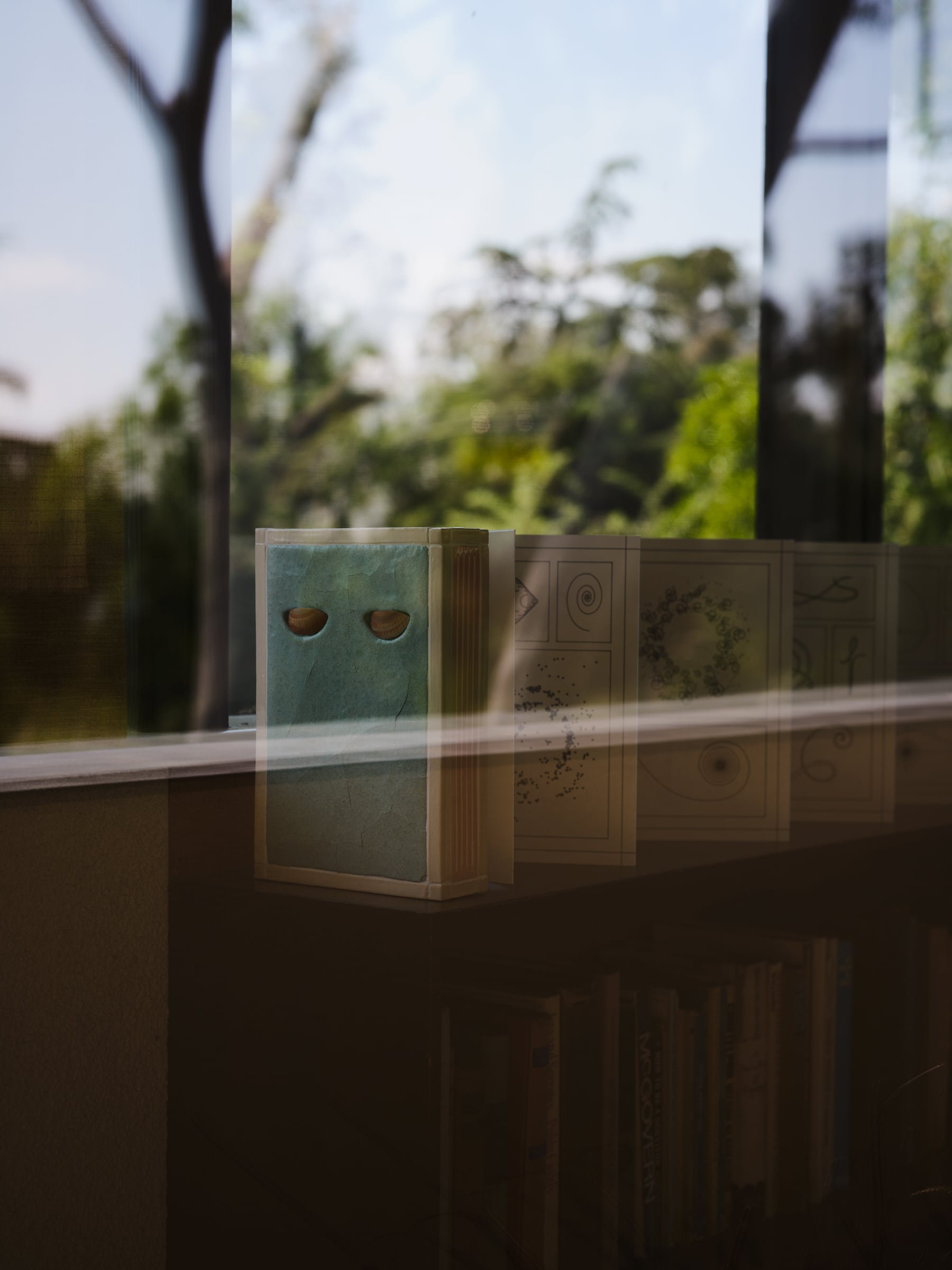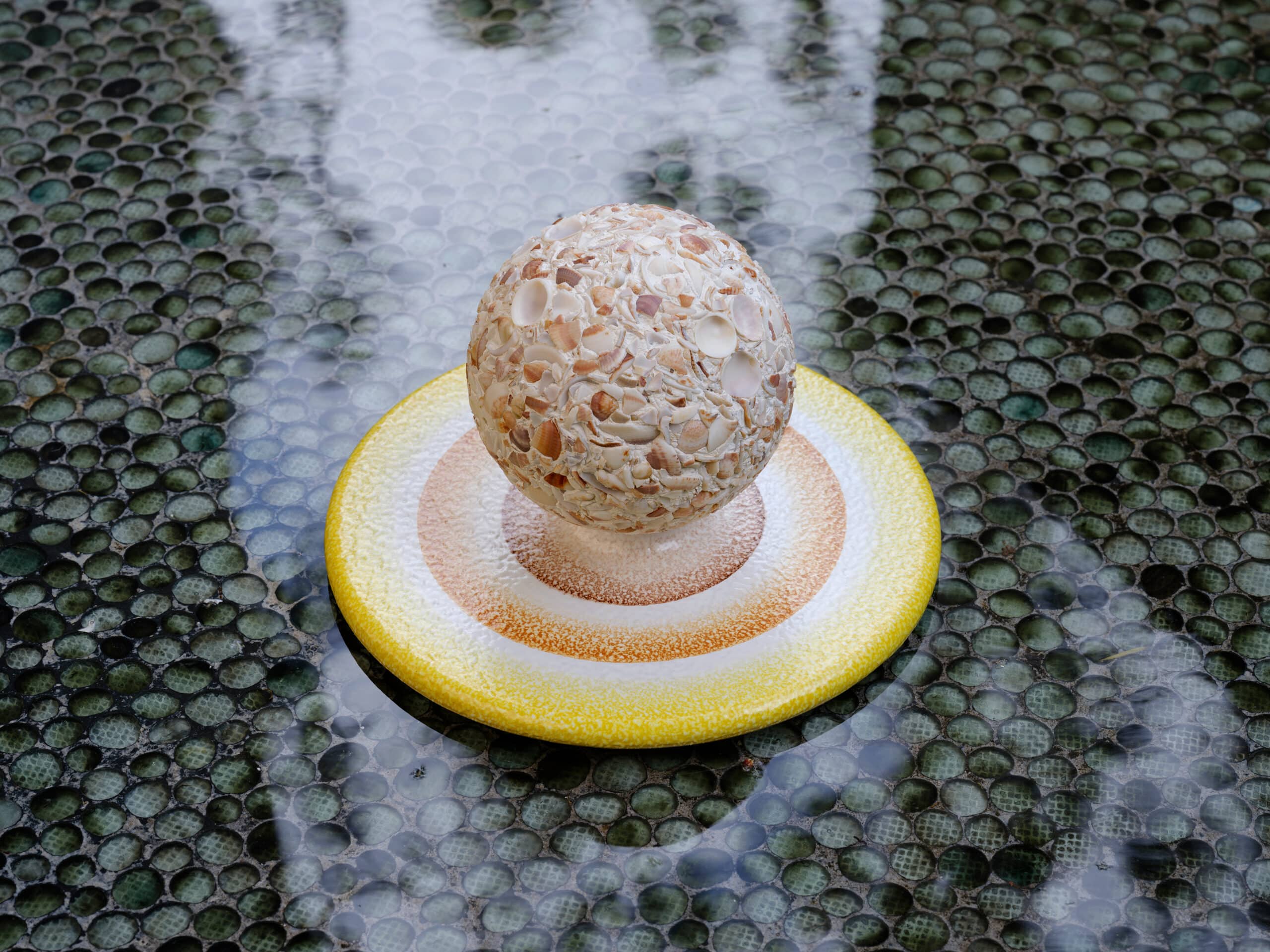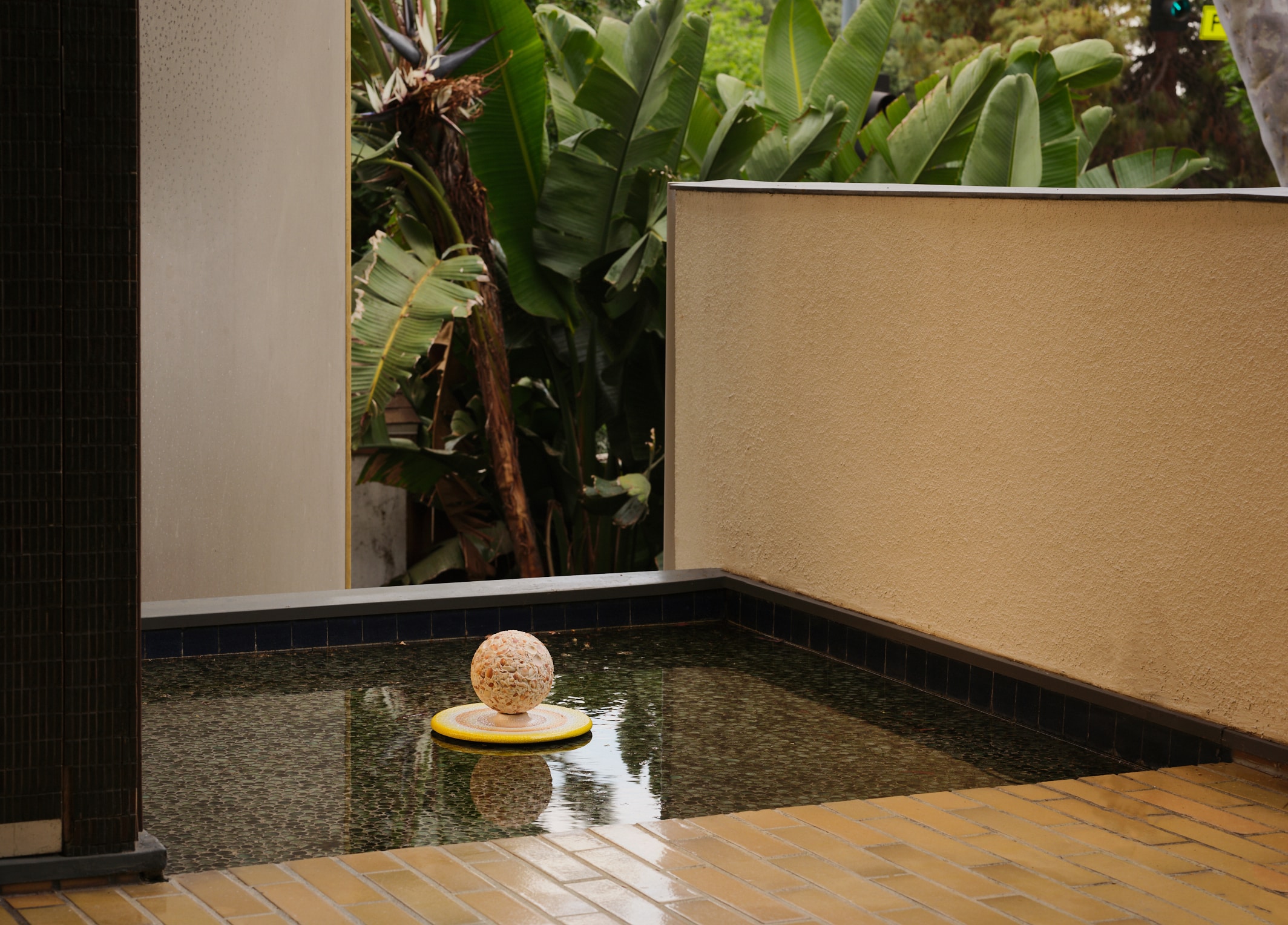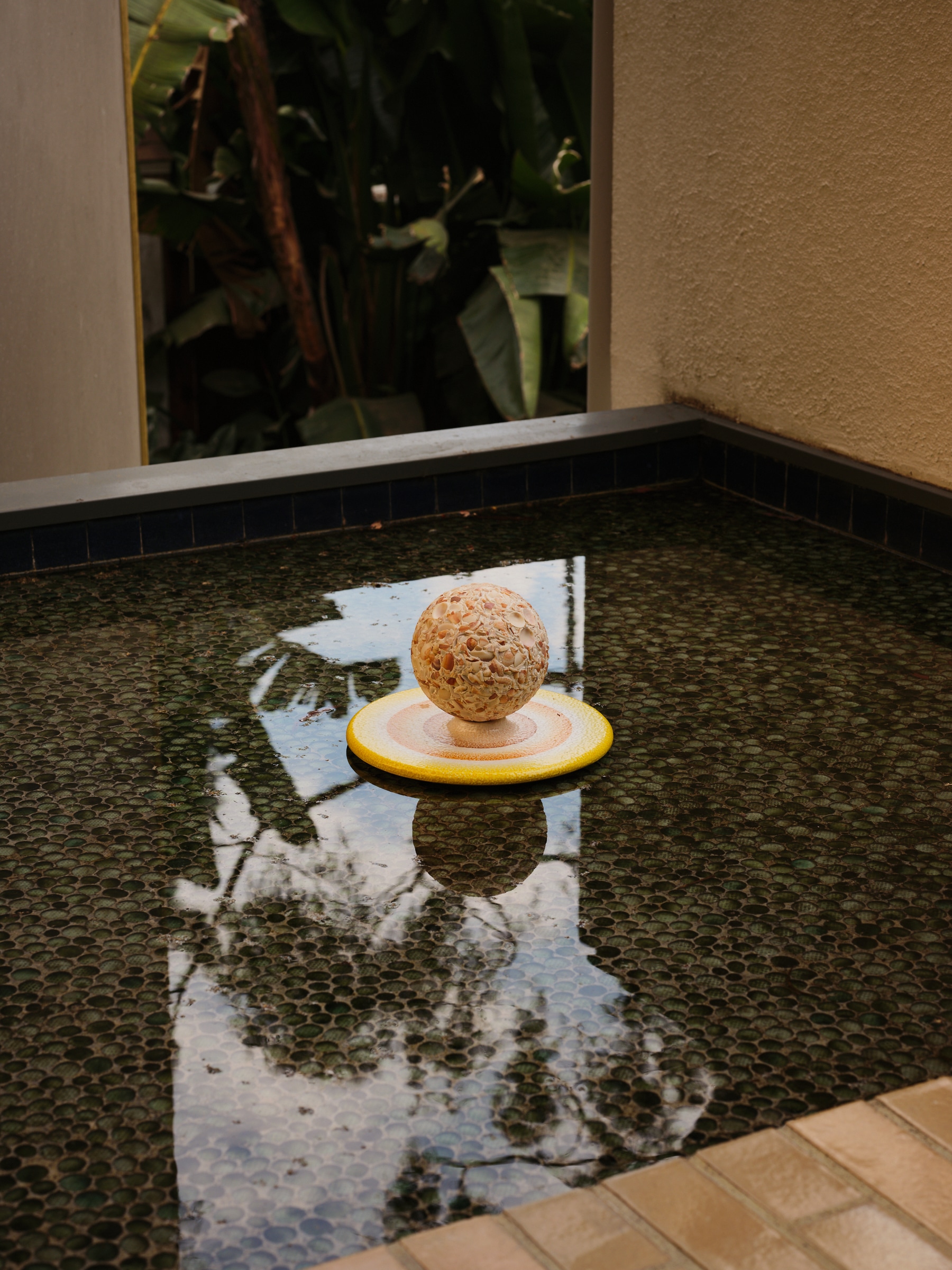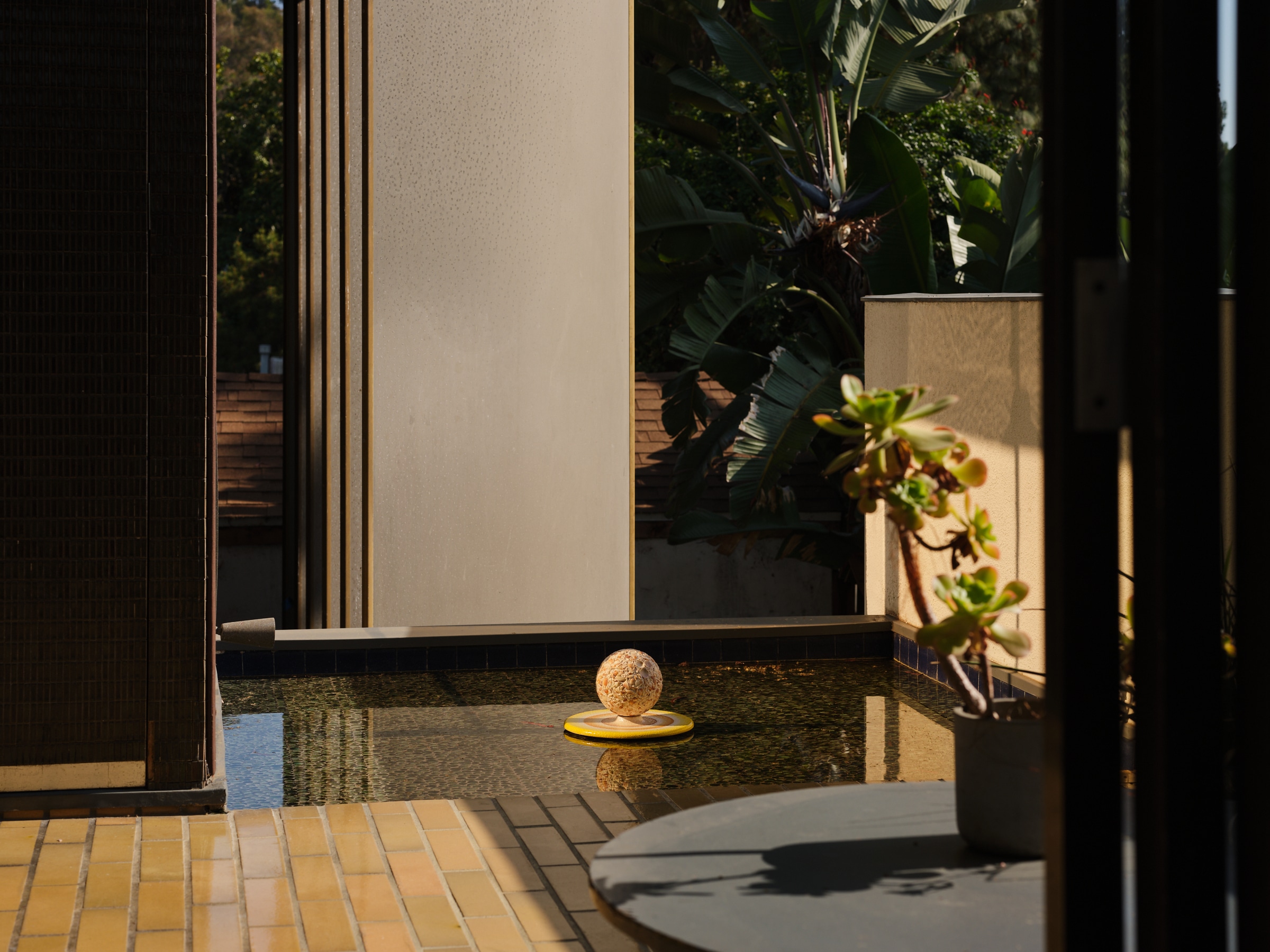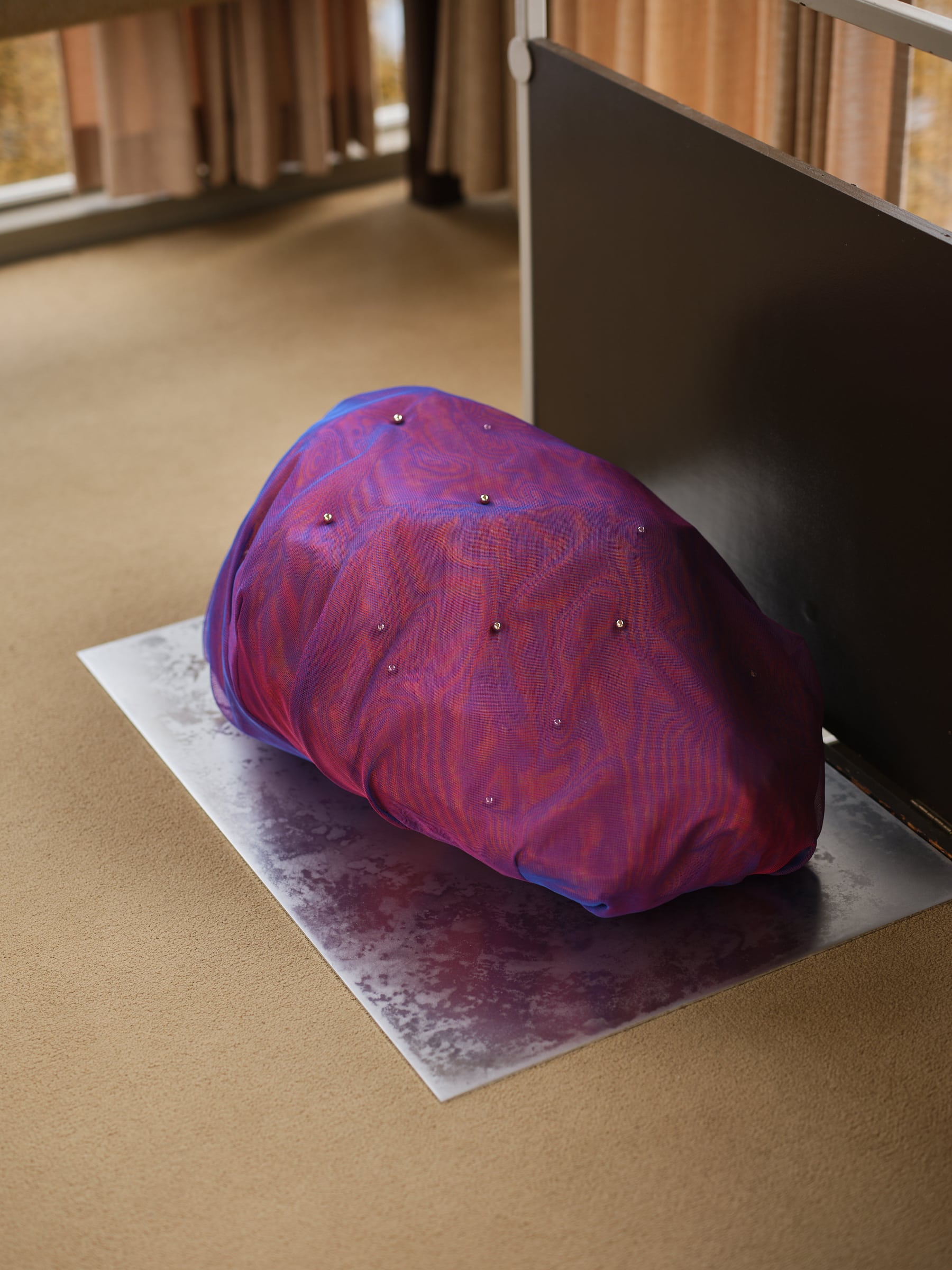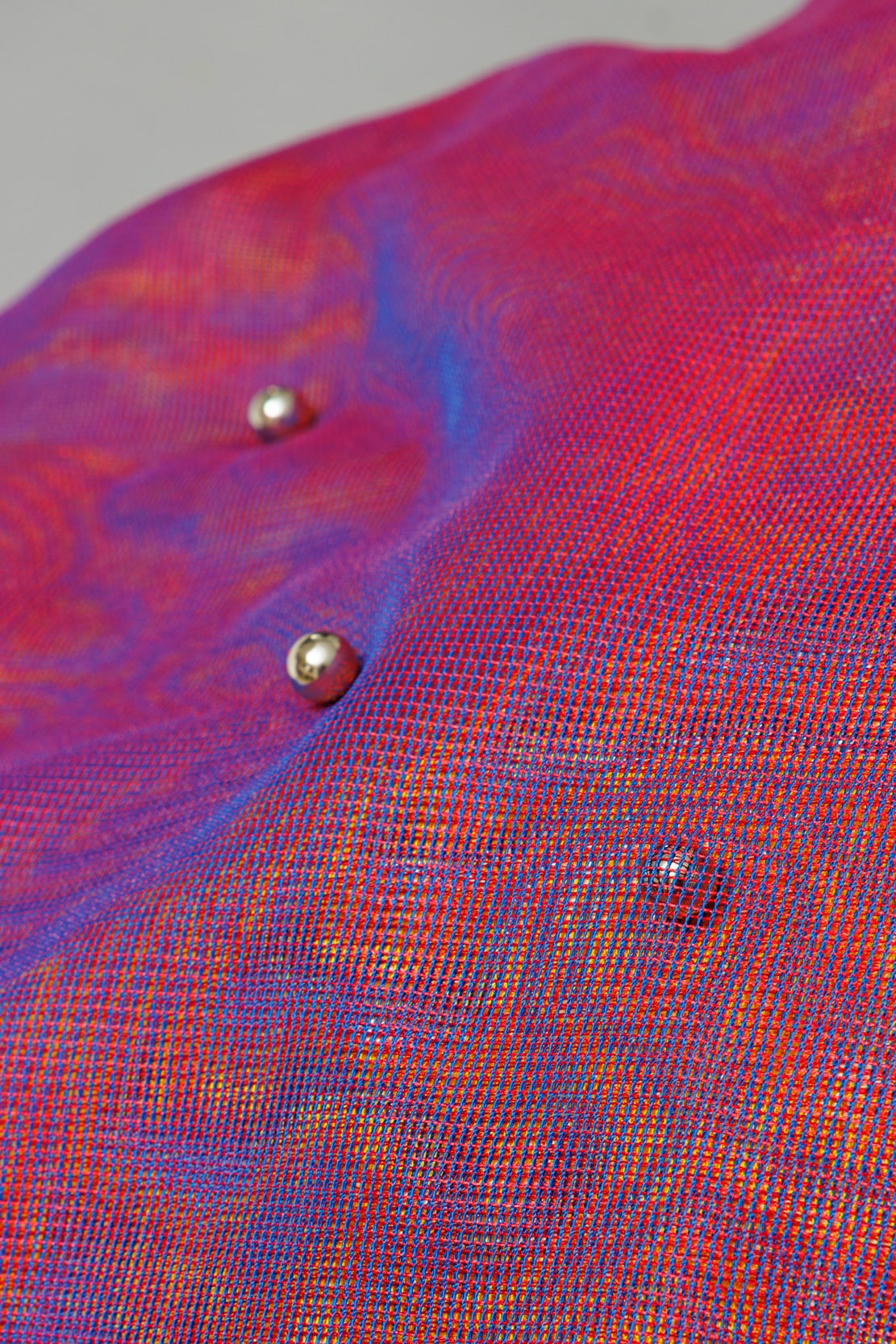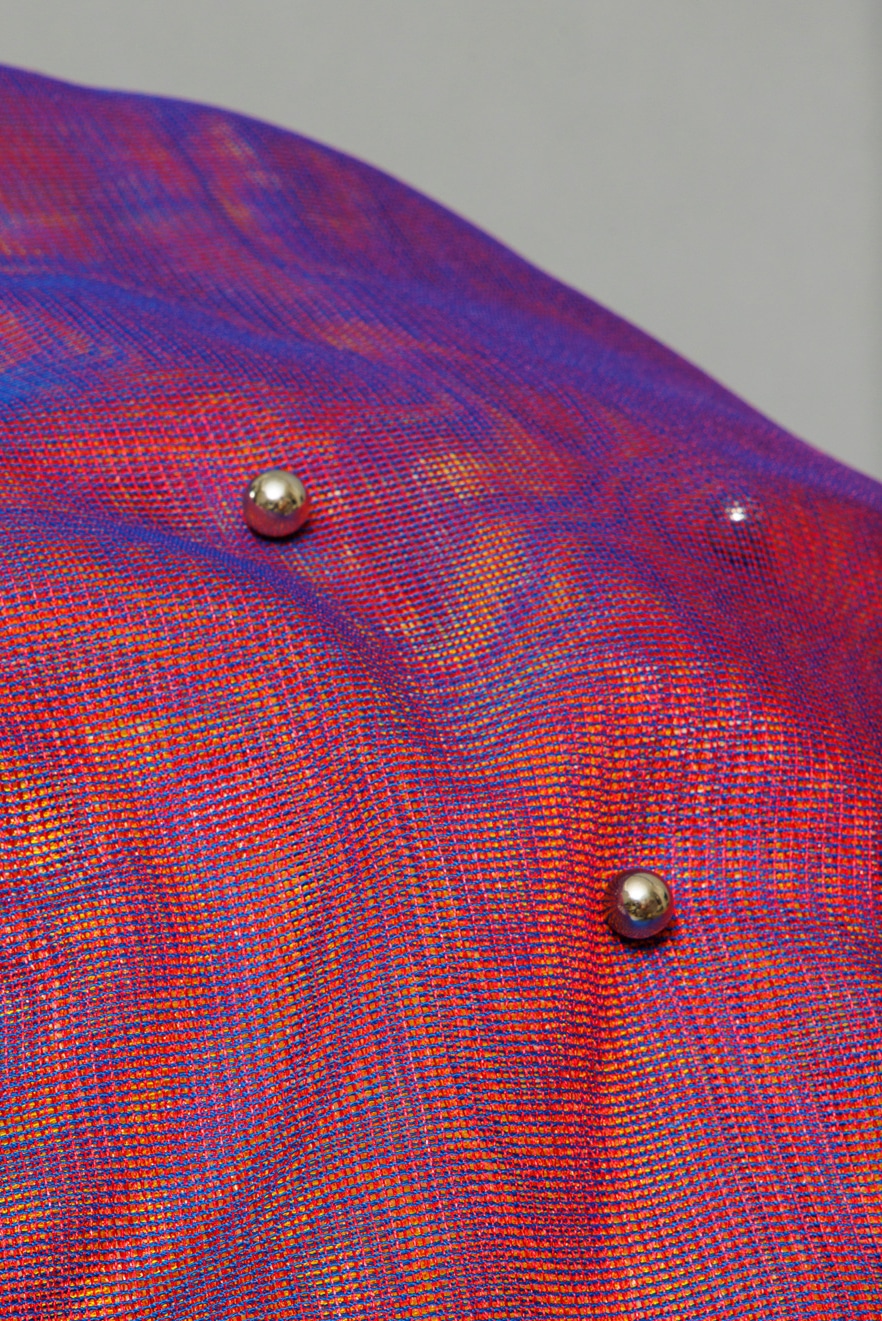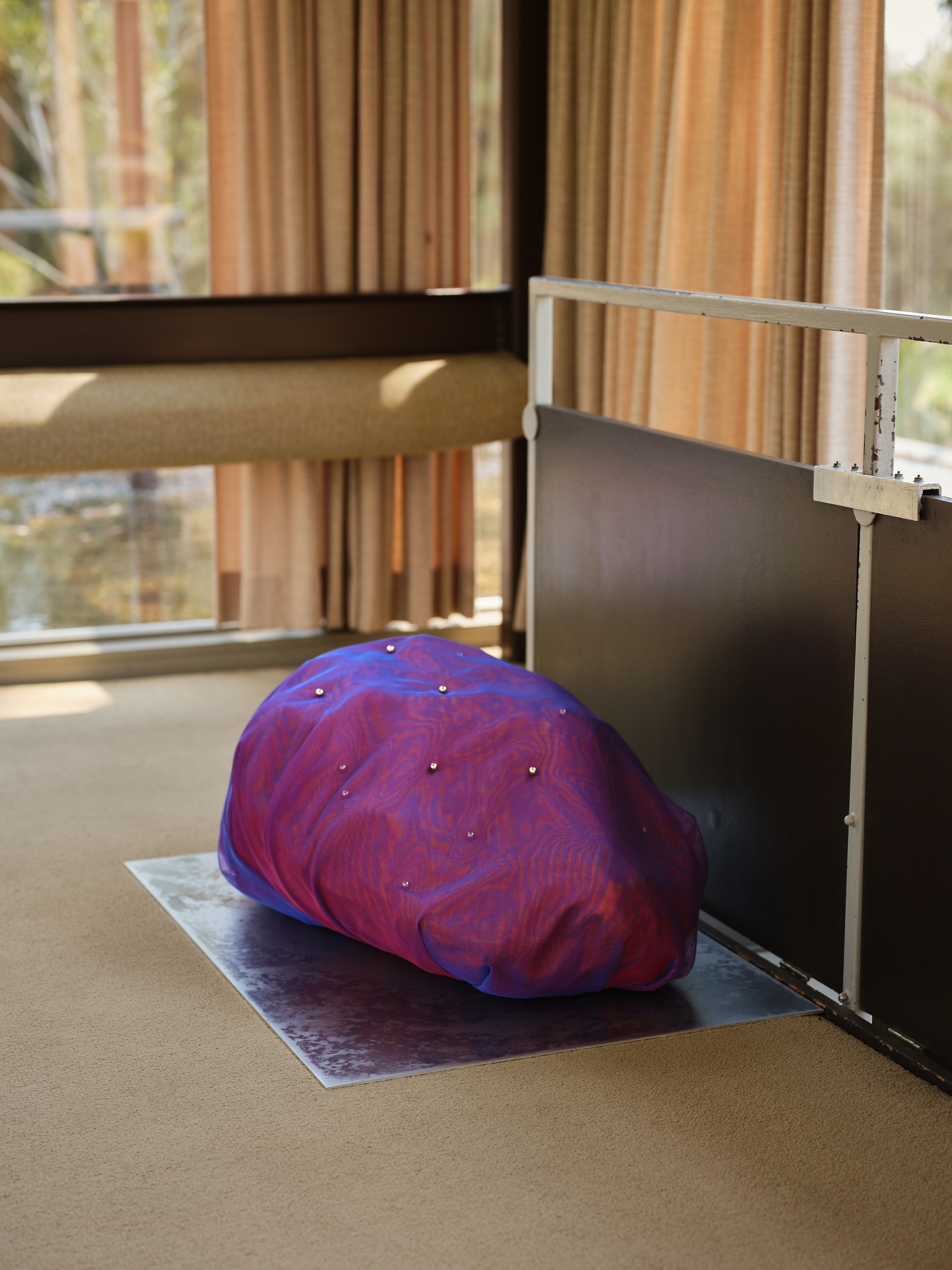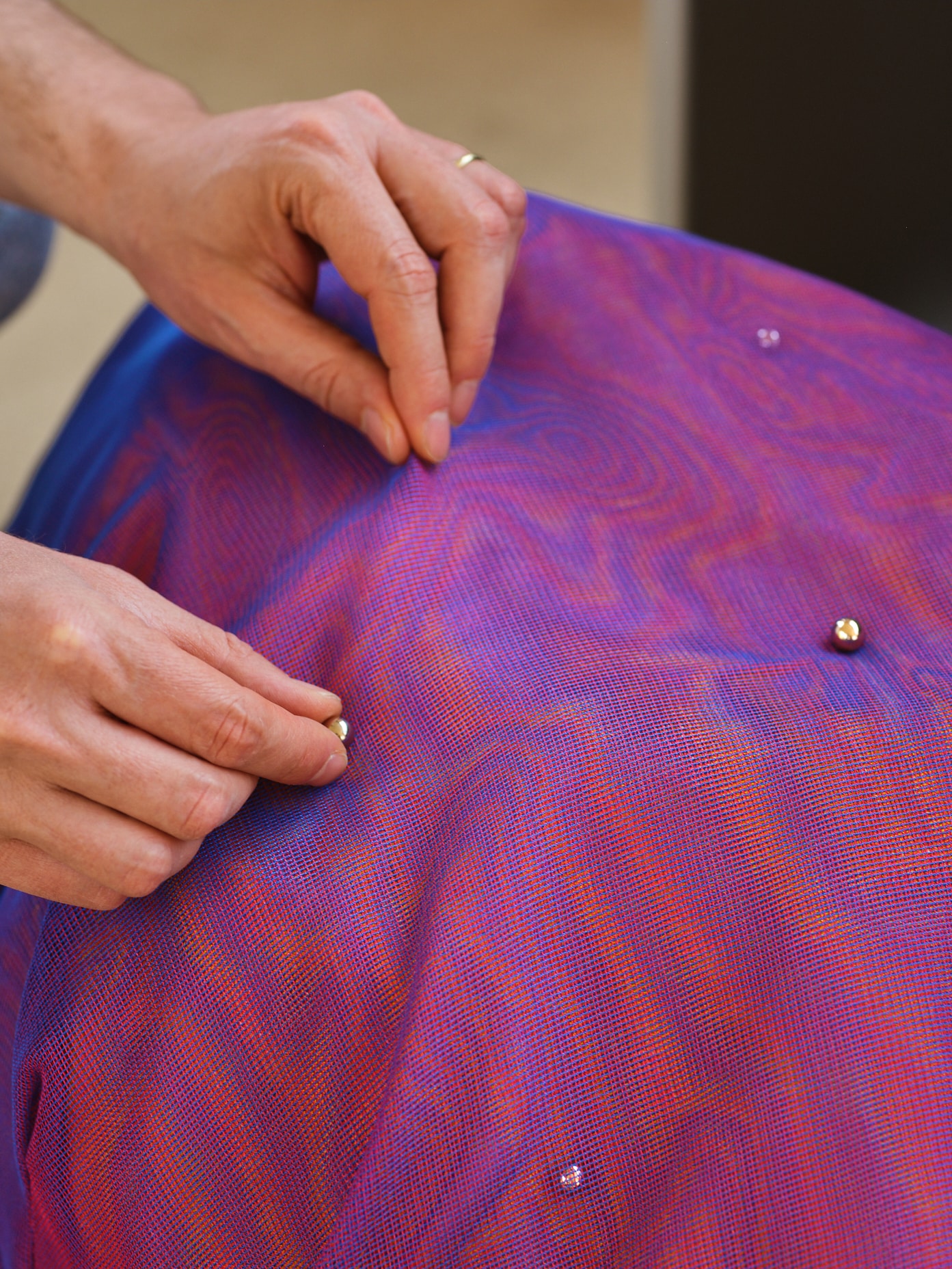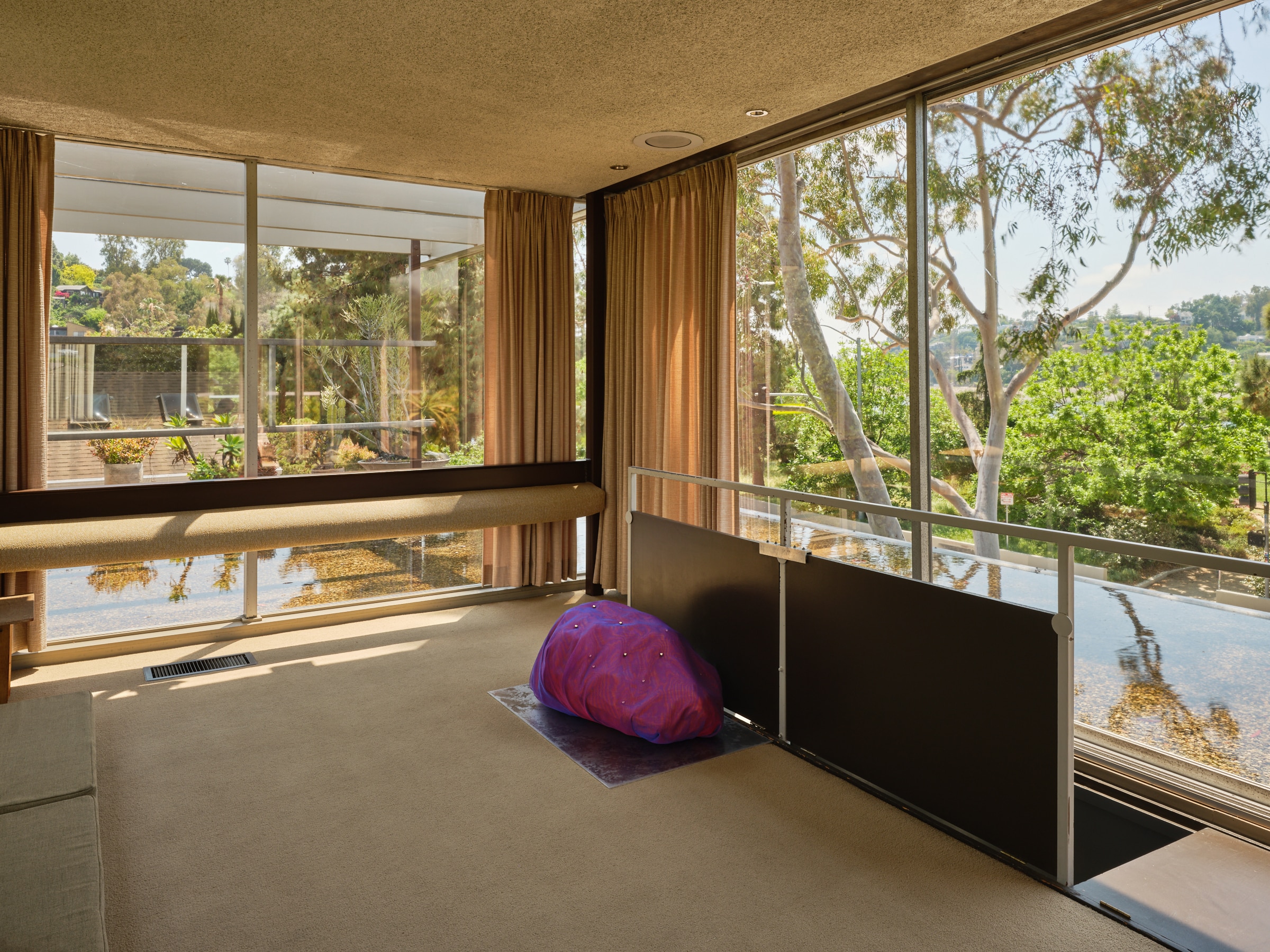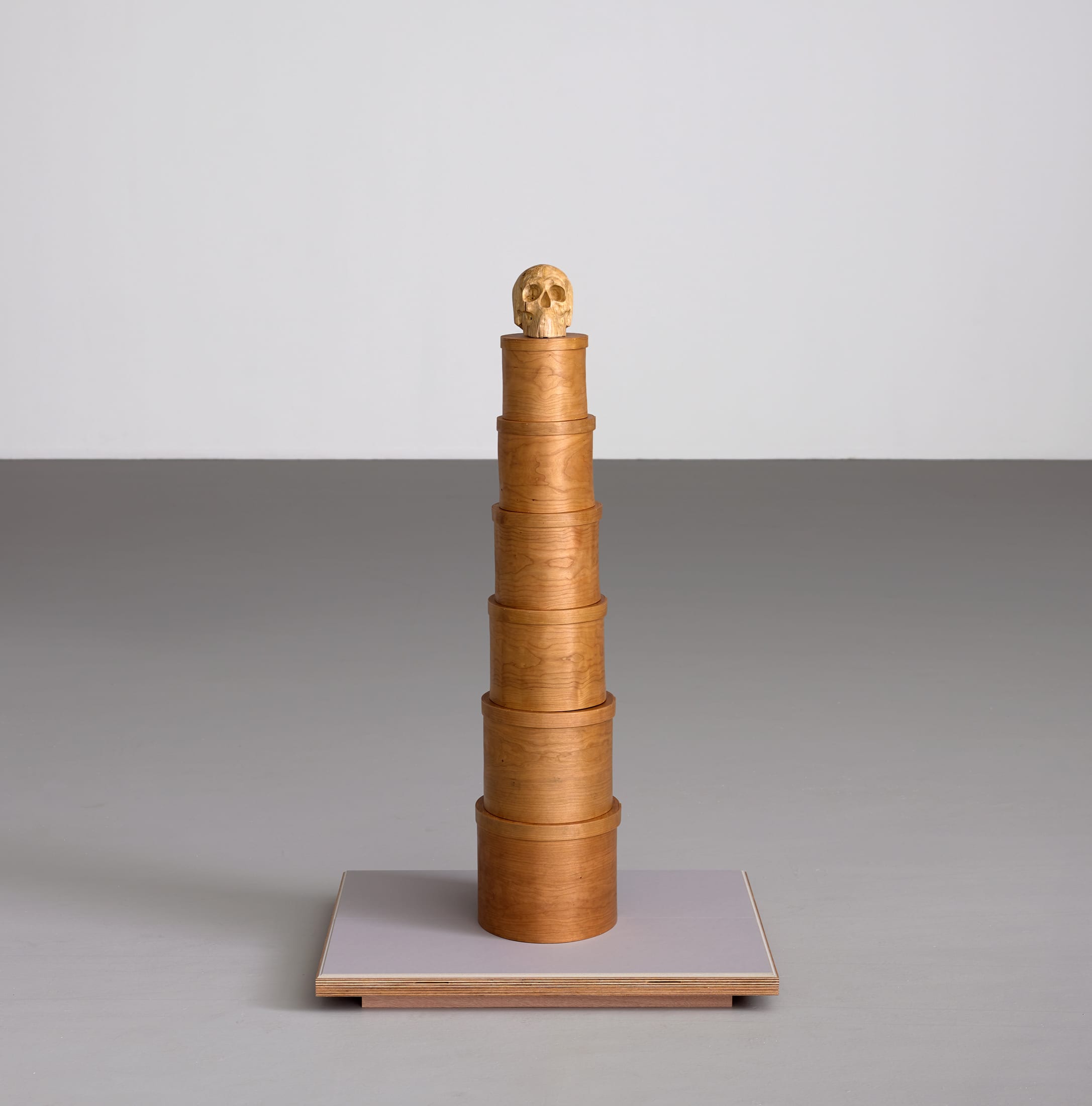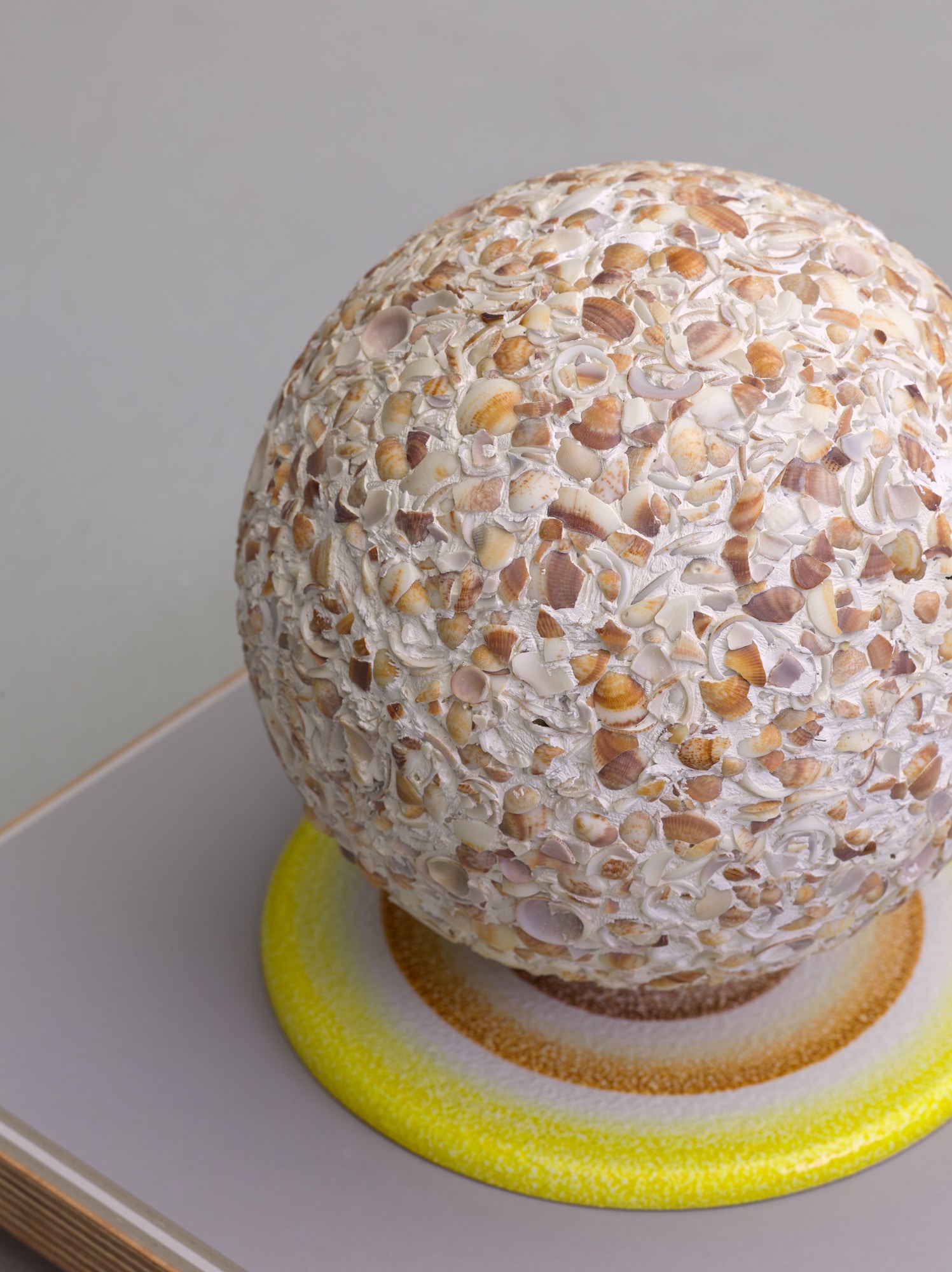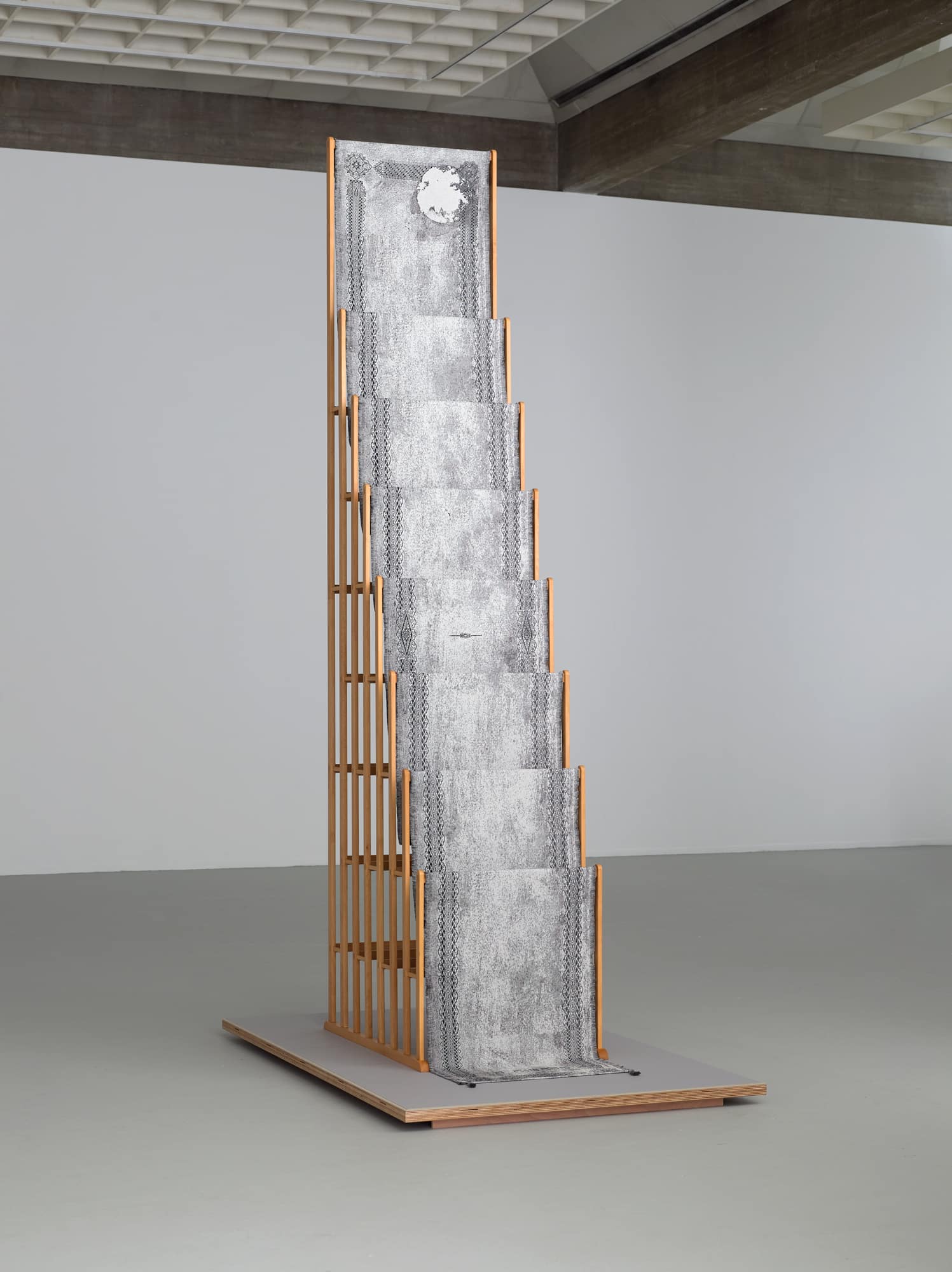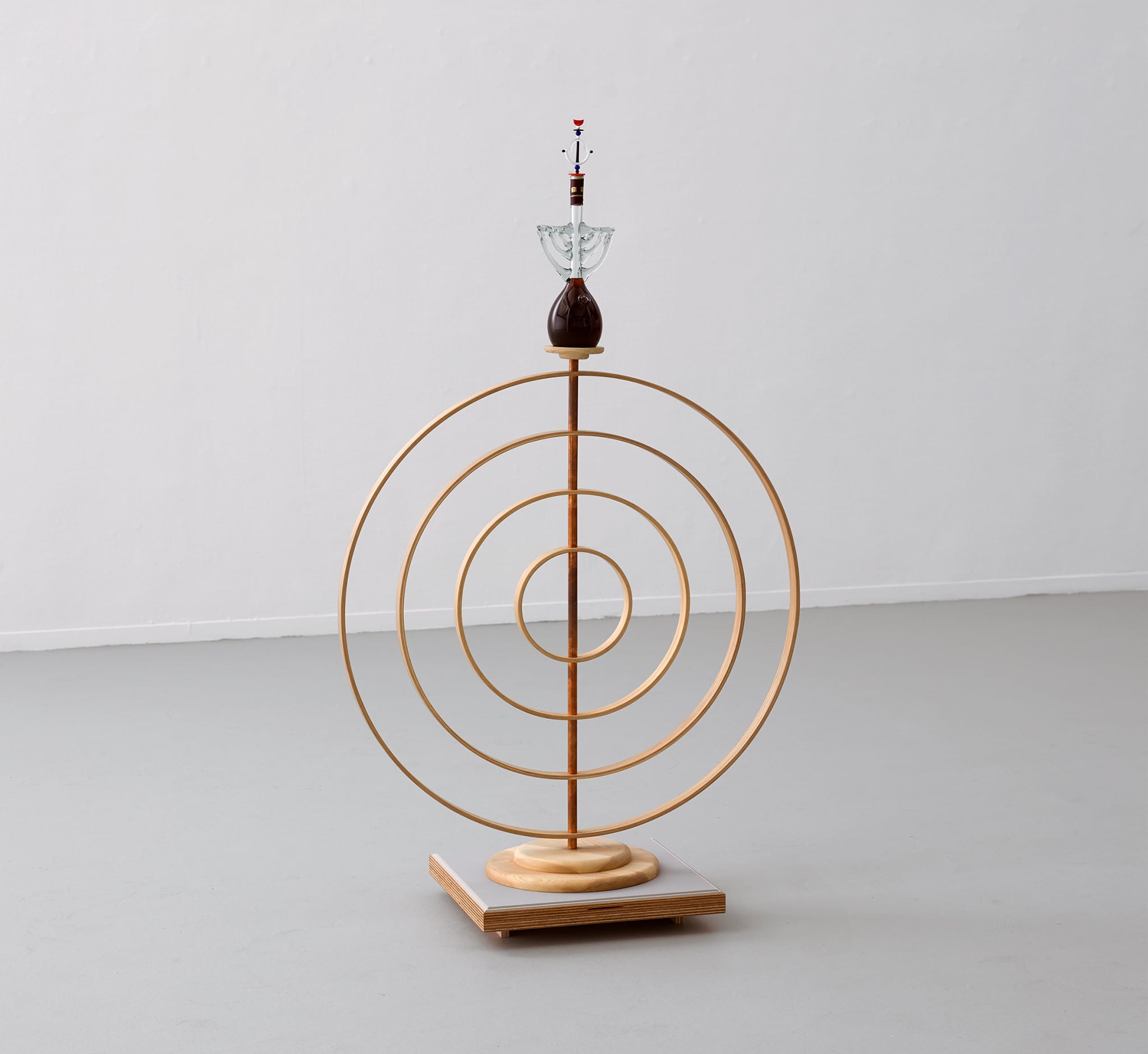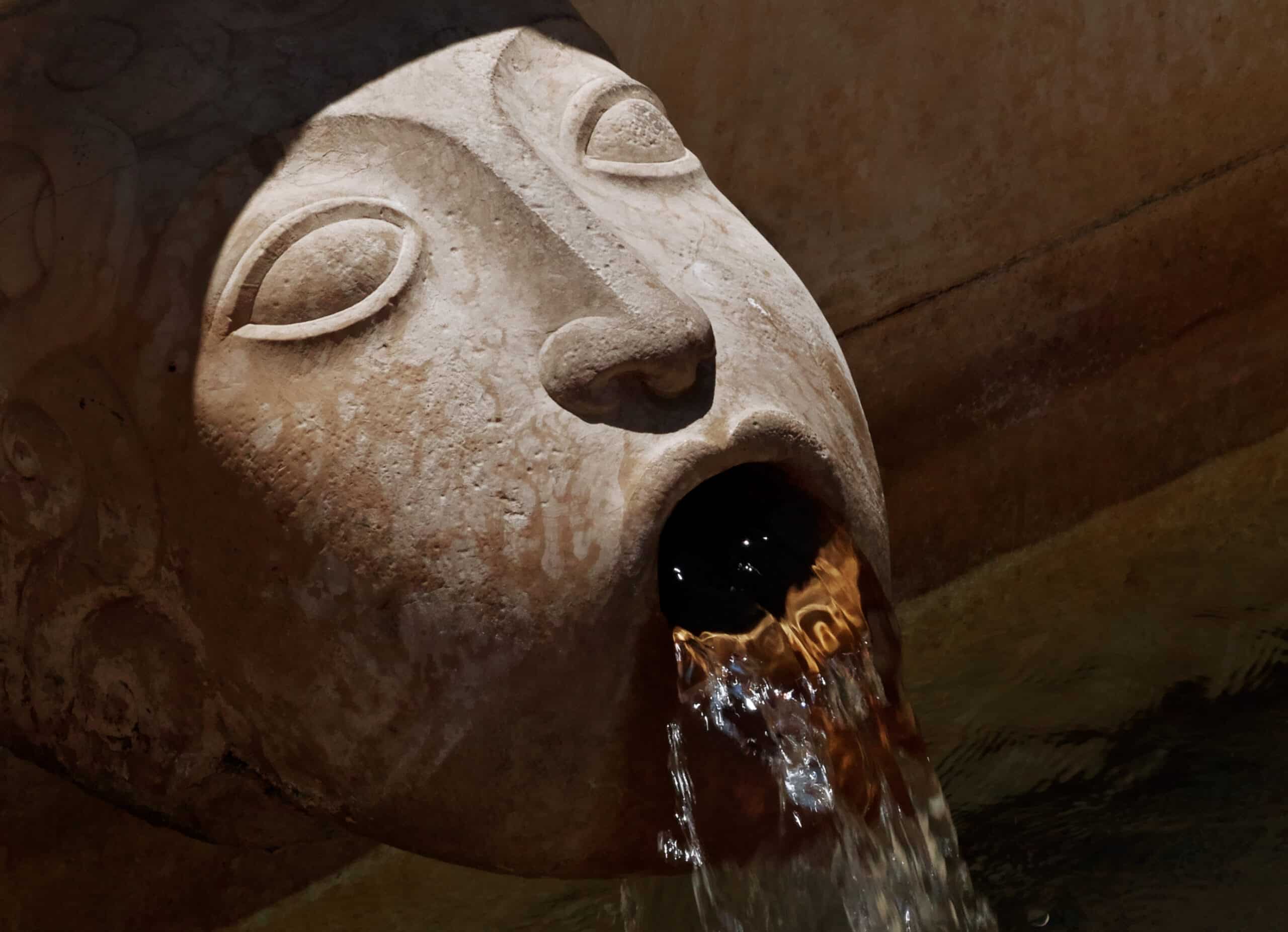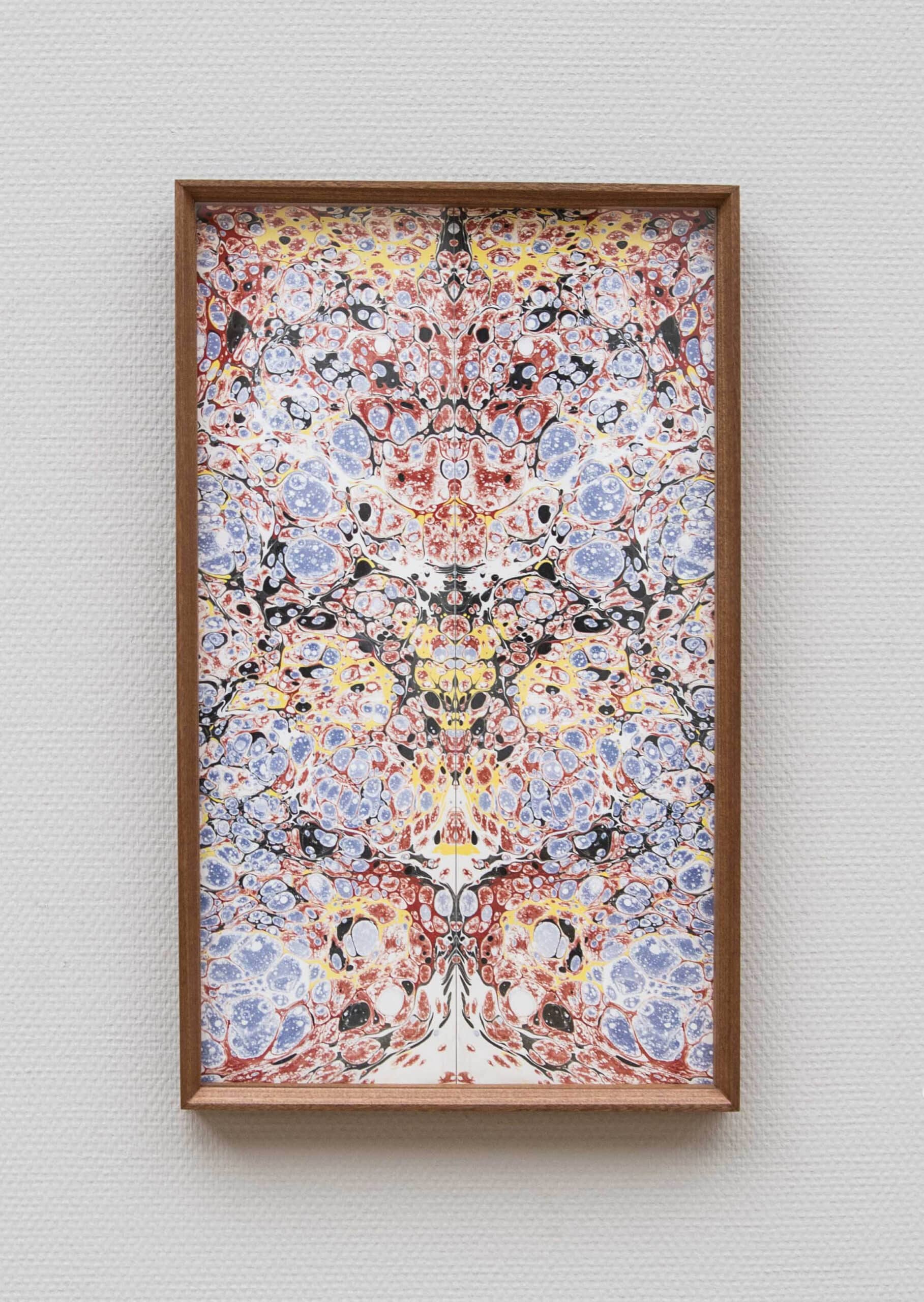Sun, Dial, 2022
TextImages
woodblock print on paper, matboard, aluminum, and mechanical apparatus
108 units
580×660 cm
woodblock print on paper, matboard, aluminum, and mechanical apparatus
108 units
580×660 cm
The (long) red dial rotates clockwise, indicating the local time at the given timezone; the (short) black dial rotates counter clockwise, moving across the letters of the artist’s Hebrew name, completing a rotation every sixty minutes
Asmodeus, 2022
TextImages
house of cards: letterpress print on paper, 24×21.6×6.3 cm
step ladder: cypress wood, 96×30×30 cm
house of cards: letterpress print on paper, 24×21.6×6.3 cm
step ladder: cypress wood, 96×30×30 cm
cards after Zeev Raban, Palestine Playing Cards, ca. 1920; recto: Asmodeus after the Joker card; verso: montage of the Queen card-Batsheva, King card-Solomon, and a portrait of the artist’s wife
Untitled (Joints), 2022
TextImages
color photographs (back to back): archival inkjet prints on cotton rag paper, 80×120 cm each
board: pine and oak wood, 208×136×50 cm
color photographs (back to back): archival inkjet prints on cotton rag paper, 80×120 cm each
board: pine and oak wood, 208×136×50 cm
Untitled (Mirrors), 2022
TextImagespaper works (back to back): natural pigments on cotton rag paper, 108x79 cm each
structure: maple wood, 214×93×78 cm
paper works (back to back): natural pigments on cotton rag paper, 108x79 cm each
structure: maple wood, 214×93×78 cm
Marbling is a paper-handling technique with rich roots in the Islamic world and East Asia. Traditionally, the technique has been utilized in the creation of various patterns on paper for the covers and endpapers of unique books and manuscripts. I have been ceaselessly exploring marbling and its formations, and approach each marbling-related project differently.
Natural pigments are diluted in water and mixed with various materials that transform the paint’s surface tension, enabling it to float and expand on a liquid base surface. Drops of color are applied and manipulated in various methods until a pattern is created.
When the paper—soaked in advance with hydrophobic material—meets the surface, the pigments detach from their medium: water returns to the tray, and the pigments are fixated within the paper fibers.
In the “Mirrors” series, I sought a way to create a defined shape rather than a pattern. When I gazed at the image vertically positioned on a wall, I felt those elliptical shapes are a portal opening agape in the paper, perhaps to another conscious space. Not unlike mirrors, there is a mental teleportation here: one seems to look at an outside, but finds oneself looking inside.
This poetic relation is the twin of the physical logic of marbling as it is uniquely applied in this series. Initially, the surface is covered with a drizzle of white pigment. Then, a drop of color is added, and a second color is applied in the midst of the first color. The first color is pressured between two forces: from the inside out by one color, and from the outside by the white background.
Gates of Tears, 2021
TextImagesink and color pencils on paper in artist frame (cypress wood) 46 x 38 cm
ink and color pencils on paper in artist frame (cypress wood) 46 x 38 cm
A personal prayer I wrote in Hebrew, translated to Yiddish, then translated again into a Yiddish stenography system developed in 1925 by Fanny (Feiga) Schargorodska, that (as far as i know) was never in actual use.
Reflecting Pool (No Garden Without A Snake), 2017
TextImages
concrete floor relief, granolith cast sculpture, cacti and succulent garden
(public plaza, 33 Shaul Hamelech st. Tel Aviv)
concrete floor relief, granolith cast sculpture, cacti and succulent garden
(public plaza, 33 Shaul Hamelech st. Tel Aviv)
Tool Chest, 2025
TextImages
birch wood (Barley Twisted), maple wood, cardboard, paper, work samples, sketches, natural phenomena, and various objects.
165 x 44 x 44 cm
birch wood (Barley Twisted), maple wood, cardboard, paper, work samples, sketches, natural phenomena, and various objects.
165 x 44 x 44 cm
Both Hands, 2025
TextImages
silkscreen and woodblock print on cotton rag paper in artist frame.
90x75.5x2.2 cm (framed)
silkscreen and woodblock print on cotton rag paper in artist frame.
90x75.5x2.2 cm (framed)
This printed edition was created after the drawing
Both Hands
Camel Table (Pietra Dura), 2025
TextImages
cut and inlaid marbled papers (natural pigments on cotton rag paper), Sapele veneer, and plywood on Neutra's Camel Table system.
74 x 90 x 205 cm
cut and inlaid marbled papers (natural pigments on cotton rag paper), Sapele veneer, and plywood on Neutra's Camel Table system.
74 x 90 x 205 cm
It is an intervention in Richard Neutra’s iconic Camel Table, originally designed to function as both a dining and coffee table, with folding legs to adjust its height. I left it between states. The top surface is made from many pieces of marbled paper mounted on museum board, then cut and inlaid to form different patterns. All patterns are visual representations of three-dimensional spaces rendered in two-dimensional form. The composition recalls historical pattern books, which architects once used to guide stylistic decisions before the rise of modernism.
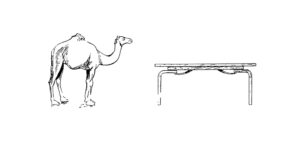
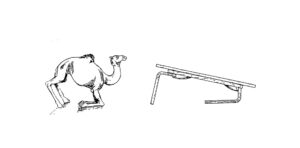
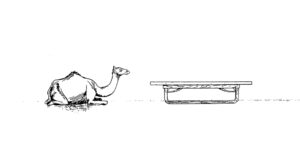
Book of Spirals, 2025
TextImages
glazed ceramics, natural seashells, and archival ink on paper (drawn with a mechanical drawing device using a Rapidograph fineliner)
24 x 16 x Various lengths up to 700 cm
glazed ceramics, natural seashells, and archival ink on paper (drawn with a mechanical drawing device using a Rapidograph fineliner)
24 x 16 x Various lengths up to 700 cm
Seashell Sphere (16), 2022
TextImages
sphere: plaster, sand, and seashells (Glycymeris nummaria), diameter 16 cm; base: fired and glazed stoneware (glazed using a historical glaze recipe developed for the Italian Futurists at Studio Mazzotti; created by Tullio Mazzotti, Albisola, Italy), 2×30×30 cm
sphere: plaster, sand, and seashells (Glycymeris nummaria), diameter 16 cm; base: fired and glazed stoneware (glazed using a historical glaze recipe developed for the Italian Futurists at Studio Mazzotti; created by Tullio Mazzotti, Albisola, Italy), 2×30×30 cm
Bird, 2018
TextImages
bird-of-paradise flower, water, glass, plywood and cherry veneer.
138x15x15 cm
bird-of-paradise flower, water, glass, plywood and cherry veneer.
138x15x15 cm
A bird-of-paradise flower is placed within a glass vessel made of three parts in blue, red and yellow. The flower is so named for its resemblance to a spectacular bird that seems to be drinking nectar from its stem: the wide sepal that carries the flower resembles a bird’s stomach, with the sharp angle between the stem and the sepal evoking a beak, and the petals appearing like fluttering wings. The form of the bird suggested by the flower entices nectivorous birds to land on its “stomach.” Pollen particles stick to their legs and fall off as they fly onto the next flower, contributing to the plants’ pollination and reproduction.
Like the glass vessel, the flower too – belongs to the monocotyledon group – comprised of multiples of three: three petals, three stamens, and so forth. It also has three colors: orange sepals, purple petals and green stem. The vessel is made of the three primary colors, the flower of the three secondary colors. Together they comprise the full color wheel—two that are one, and one that breaks up into its elements.
Olivewood Skull, 2022
TextImages
carved olive wood after a 3D scan of the artist’s skull: 15x16x24 cm
set of six oval (Shaker style) nesting boxes: cherry wood and copper
17x18x27 cm
18.5x20.5x30.7 cm
20x23x34.4 cm
21.5x25.5x38.1 cm
23x28x41.8 cm
24.5x30.5x45.5 cm
carved olive wood after a 3D scan of the artist’s skull: 15x16x24 cm
set of six oval (Shaker style) nesting boxes: cherry wood and copper
17x18x27 cm
18.5x20.5x30.7 cm
20x23x34.4 cm
21.5x25.5x38.1 cm
23x28x41.8 cm
24.5x30.5x45.5 cm
Mirror #1, 2022
TextImagesnatural pigments on cotton rag paper
108×79 cm
natural pigments on cotton rag paper
108×79 cm
Marbling is a paper-handling technique with rich roots in the Islamic world and East Asia. Traditionally, the technique has been utilized in the creation of various patterns on paper for the covers and endpapers of unique books and manuscripts. I have been ceaselessly exploring marbling and its formations, and approach each marbling-related project differently.
Natural pigments are diluted in water and mixed with various materials that transform the paint’s surface tension, enabling it to float and expand on a liquid base surface. Drops of color are applied and manipulated in various methods until a pattern is created.
When the paper—soaked in advance with hydrophobic material—meets the surface, the pigments detach from their medium: water returns to the tray, and the pigments are fixated within the paper fibers.
In the “Mirrors” series, I sought a way to create a defined shape rather than a pattern. When I gazed at the image vertically positioned on a wall, I felt those elliptical shapes are a portal opening agape in the paper, perhaps to another conscious space. Not unlike mirrors, there is a mental teleportation here: one seems to look at an outside, but finds oneself looking inside.
This poetic relation is the twin of the physical logic of marbling as it is uniquely applied in this series. Initially, the surface is covered with a drizzle of white pigment. Then, a drop of color is added, and a second color is applied in the midst of the first color. The first color is pressured between two forces: from the inside out by one color, and from the outside by the white background.
HaLevana, 2010-2014
TextImagessculpture: painted bronze, color photograph (archival inkjet print on cotton rag paper; photographed in Arcosanti, Arizona), 35×20×3 cm; leg: painted brass, 125×3×3 cm
sculpture: painted bronze, color photograph (archival inkjet print on cotton rag paper; photographed in Arcosanti, Arizona), 35×20×3 cm; leg: painted brass, 125×3×3 cm
This sculpture is based on ancient handheld bronze mirrors. Traditionally, these objects maintain axes of balance and movement: the woman-shaped handle carries a large round reflective disc on its head; and the object offers the allure of approaching and gazing up close into the space that opens within the matter.
In the disc’s stead I placed a photograph I took of a space in Arcosanti, an experimental utopian city built in the Arizonian desert in the 1970s by Italian architect Paolo Soleri. Titled after the Italian words for “against things,” the city was born with the notion of an evolved unity of structure and inhabitant in mind. If Arcosanti emulates the relations between home and person, the mirror perhaps does so with the relation between body and spirit, between an object and its anima.
The title, one of the Hebrew names for the moon (referring to its whiteness and its femininity), came up during my first casting attempts in plaster, resulting in a texture that seemed to me akin to the surface of the moon, perhaps the ultimate mirror.
Seashell Sphere, 2022
TextImagessphere: plaster, sand, and seashells (Glycymeris nummaria), 16, 20, 30 and 40 cm diameter
base: fired and glazed stoneware (glazed using a historical glaze recipe developed for the Italian Futurists at Studio Mazzotti; created by Tullio Mazzotti, Albisola, Italy), 2×30×30 cm
sphere: plaster, sand, and seashells (Glycymeris nummaria), 16, 20, 30 and 40 cm diameter
base: fired and glazed stoneware (glazed using a historical glaze recipe developed for the Italian Futurists at Studio Mazzotti; created by Tullio Mazzotti, Albisola, Italy), 2×30×30 cm
This series of works was born out of a desire to recreate natural consolidations of shells and earth I encountered on the shoreline. The seashell is made of merged layers of matter, and its logic extends to broader scales when the layered shell itself becomes a layer in a larger object: a rock. The seashells common on our shores, used in this piece, are Glycymeris, a species of saltwater clam that has been extinct in our region for approximately a millennia.
It is a series of four spheres, round castings of seashell and plaster positioned on ceramic bases glazed in a historical recipe developed in the 1930s by the family-run Studio Mazzotti in Albisola, Italy. The glaze was devised for a collaborative series of functional objects designed by Italian Futurist artists and executed by Studio Mazzotti. With different formal languages, the glaze is the common feature of the series, and it reminded me very much of the surface of the shells I have been collecting.
Time as an elastic matter is a dominant notion in my practice. Here, two variations of time transpire: once when the shell transports us to an archaeological past time, and again when a century-old artistic aesthetic imagines its future, that is, our present.
Like the futurists, this piece seeks ways to preserve movement in still matter. Here, it is centripetal motion: the matter gathers towards a center, curling up into a sphere, much like the logic of the pottery wheel, or the physical principle of how planets and celestial objects are made. A relation is formed: between the microcosm and the macrocosm, the shell and the rock, the sculpture and the universe.
Snail-knife, 2022
TextImages
titanium, brass, silver, snail shell, pencil on paper, felt, plywood and cherry veneer.
138x80x95 ; 7x17x5 cm
titanium, brass, silver, snail shell, pencil on paper, felt, plywood and cherry veneer.
138x80x95 ; 7x17x5 cm
Examining medieval scrolls, I chanced upon an image in the illustrated marginalia—a frightened knight fighting a snail. Confronting the snail, with its spiral shell that seems to imply the infinite dimension of the universe and the ability to travel backwards and forwards in time, the mortal knight, whose physical power and time are limited, can but beg for his life.
Two straight lines intersect on a sheet of paper resting on a small stand. A rod rises from this intersection supporting a small object: a palm-sized knife. The handle of the knife is made of snail shell out of which emerges a silver-plated brass body and an anodized blade. This object faces and stretches in two directions simultaneously. One coils inwards, the other juts out sharply and turns outward.
The object on which the snail-knife rests recalls in its logic monastery choir stalls, furniture that demark independent spaces, disconnected from their surroundings, almost separate rooms. Choir stalls include a chair and a stand for placing a book, for writing, or for presenting various objects—mostly sacred icons—for contemplation and reflection. This is a protected, intimate space for a moment of exhalation and inhalation, filling and emptying, reading and writing.
Untitled (Bookmatch #1), 2015
TextImagesnatural pigments on paper and archival inkjet print on cotton rag paper
60/42 cm
natural pigments on paper and archival inkjet print on cotton rag paper
60/42 cm
Marbling, or marbled paper, are named so due to the similarity the patterns might carry to sections of marble or other precious stones. This, in turn, sent me to the craft and act of bookmatching: slicing and adjoining two surfaces of marble, wood, or precious stone, so that they mirror each other, for the creation of what seems like an open book.
I scanned a piece of marbled paper on which I created an abstract pattern and flipped it horizontally by digital means. I then digitally printed the result, and pressed the two parts together. Looking closely, one might notice the vertical line separating the work’s two parts.
The technique also refers to the original historical use of marbled paper as covers and endpapers of unique books and manuscripts. The structure of books, composed of two equal sides parting in the middle with a spine, is what gave the material technique its name.


